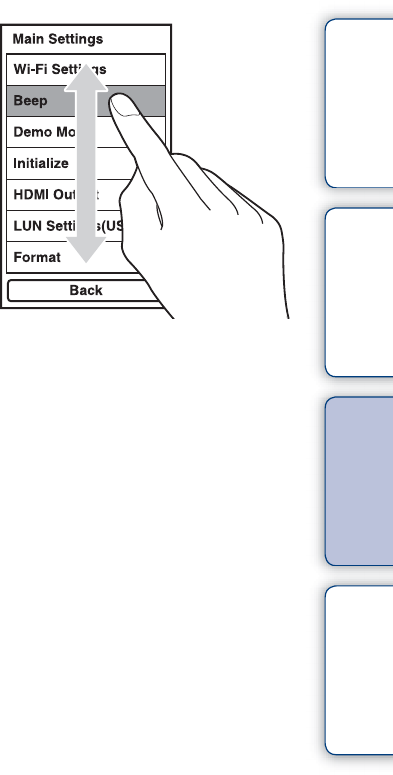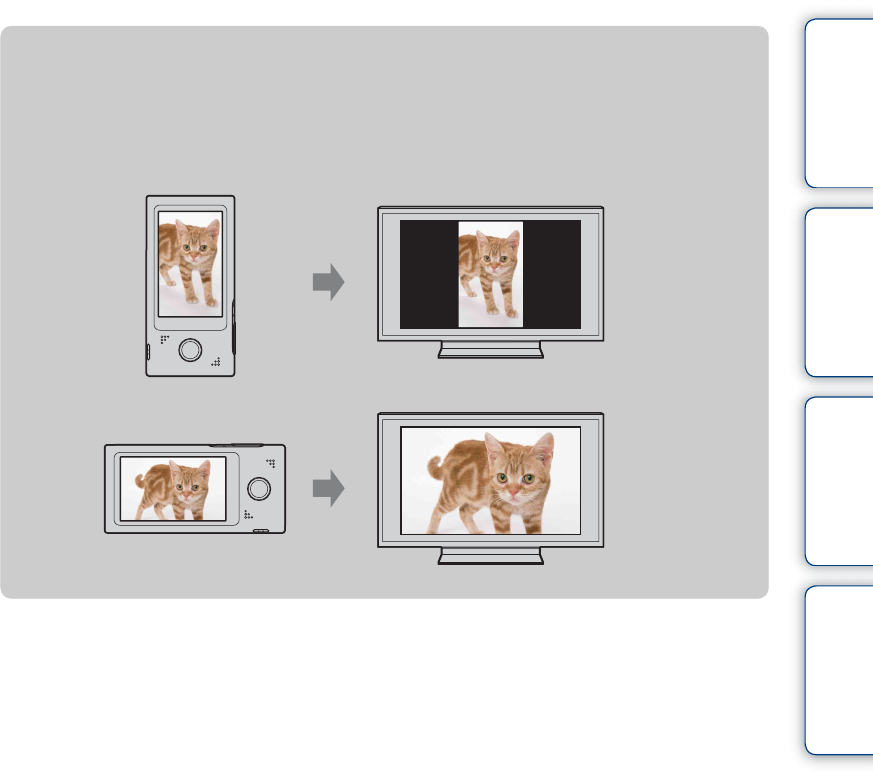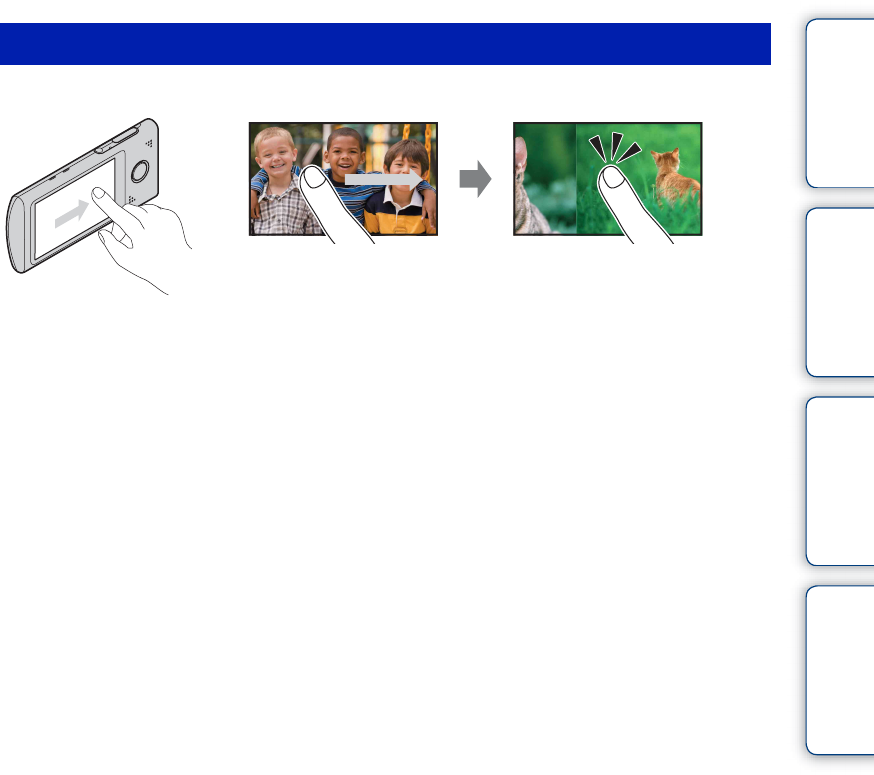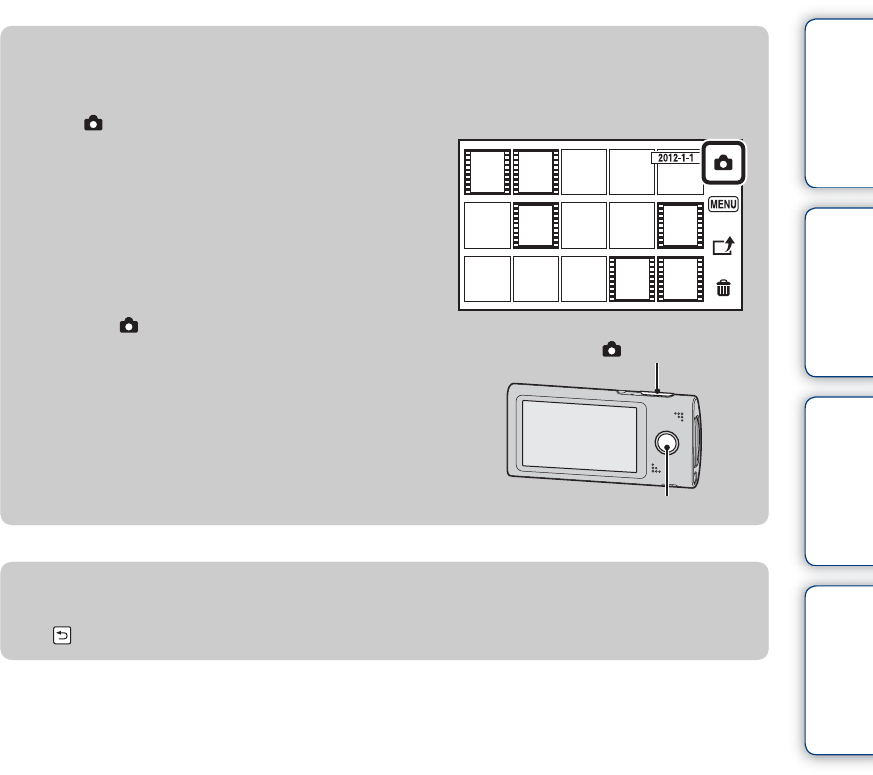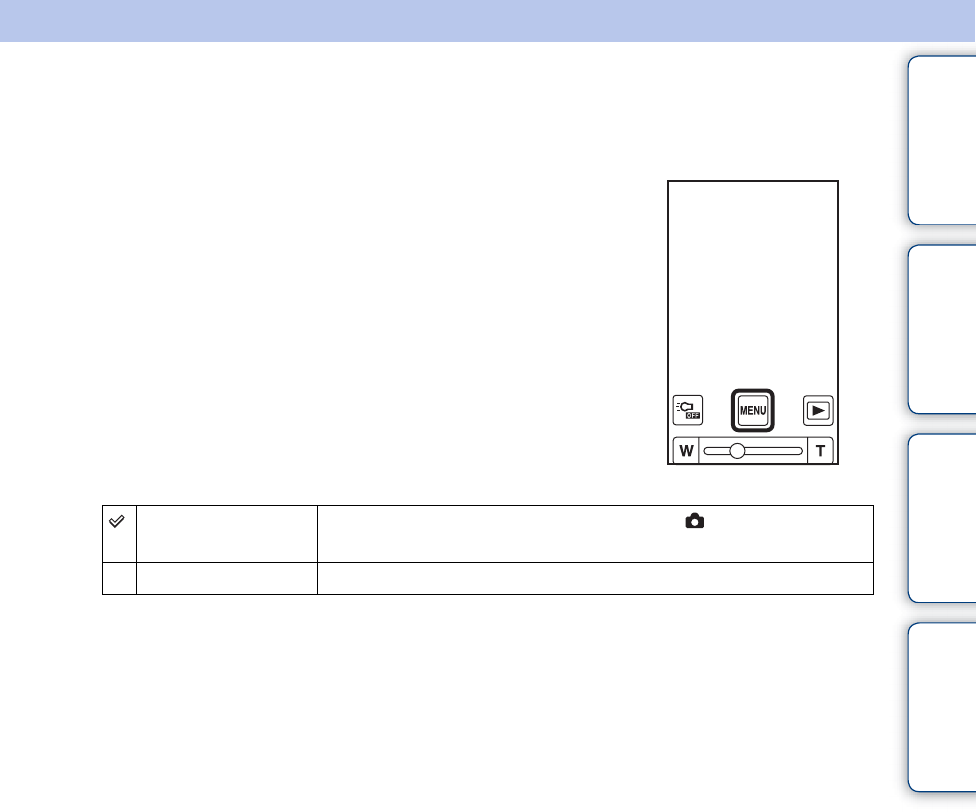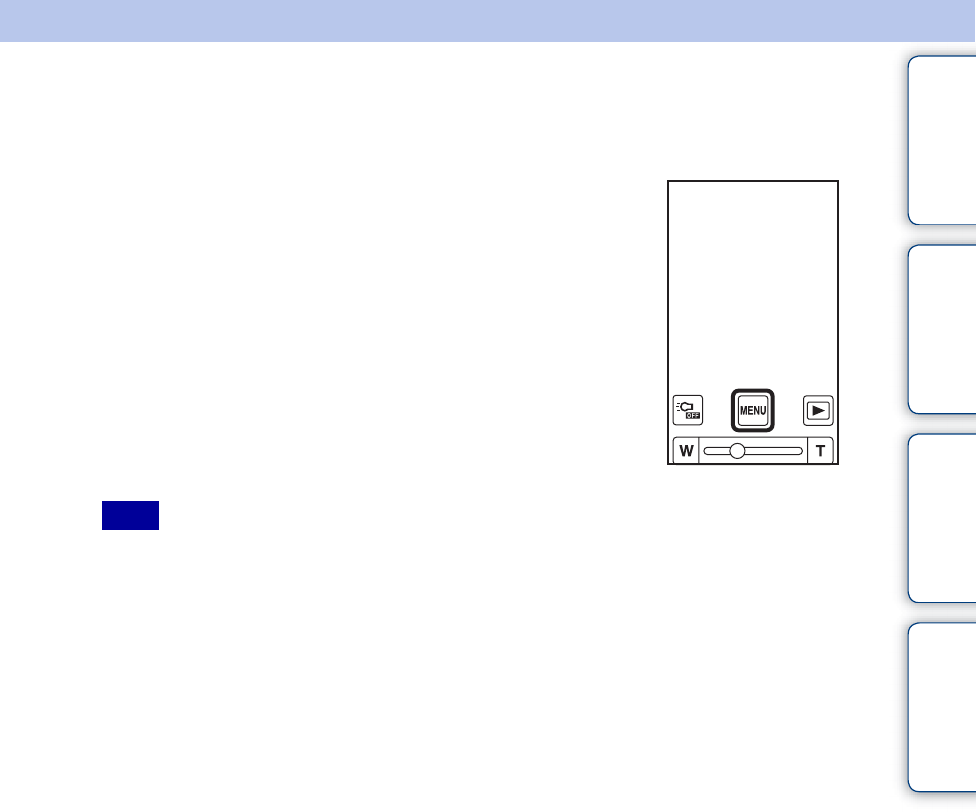Sony Group MHSTS55 MOBILE HD SNAP CAMERA User Manual MHS TS55
Sony Corporation MOBILE HD SNAP CAMERA MHS TS55
Users Manual
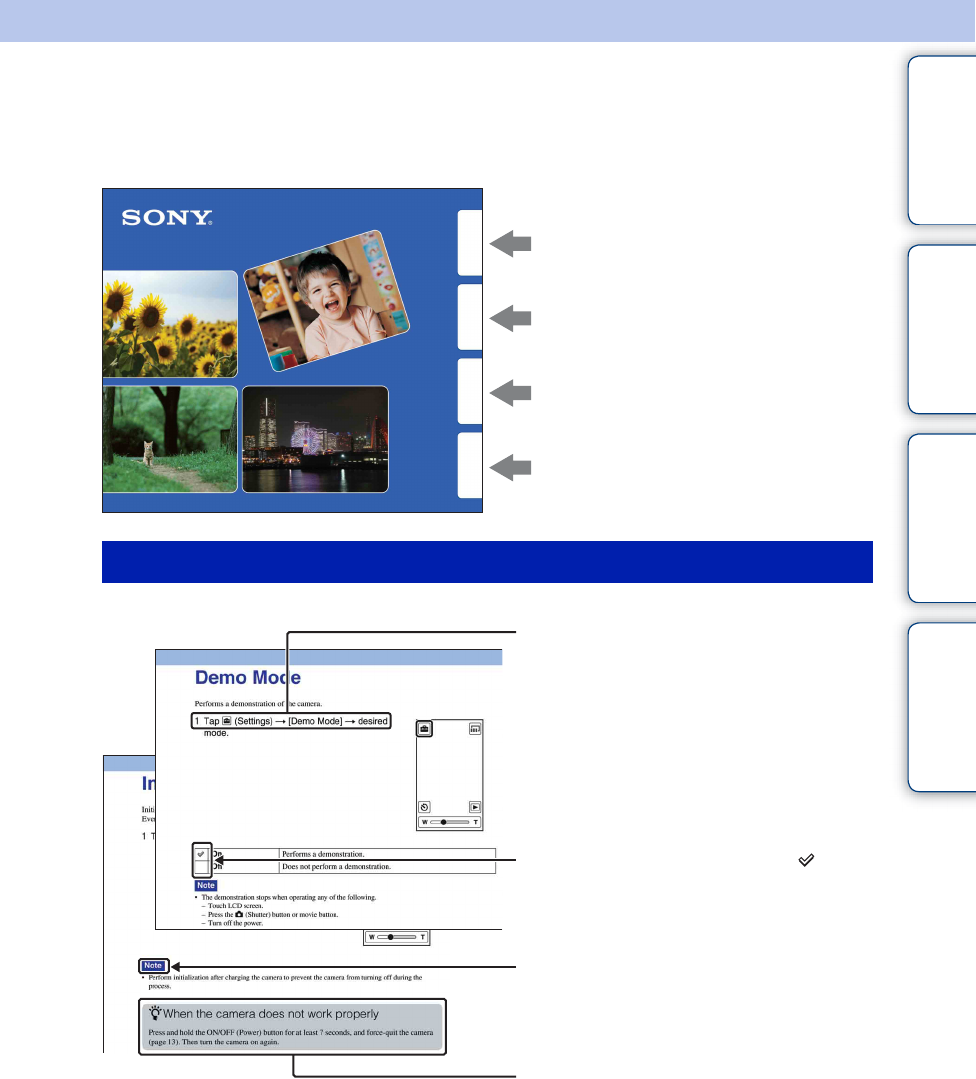
2US
Table of
contents
Operation
Search
Settings
Search Index
How to use this handbook
Click on a button on the right to jump to the corresponding page.
This is convenient when searching for a function you want to view.
Search for information by function.
Search for information by operation.
Search for information in a listing of
Settings items.
Search for information by keyword.
Marks and notations used in this handbook
Table of
contents
Operation
Search
Settings
Search
Index
In this handbook, the sequence of
operations is shown by arrows (t).
Operate the camera in the order indicated.
Marks are shown as they appear in the
camera’s default setting.
The default setting is indicated by .
Indicates cautions and limitations relevant
to the correct operation of the camera.
z Indicates information that is useful to
know.
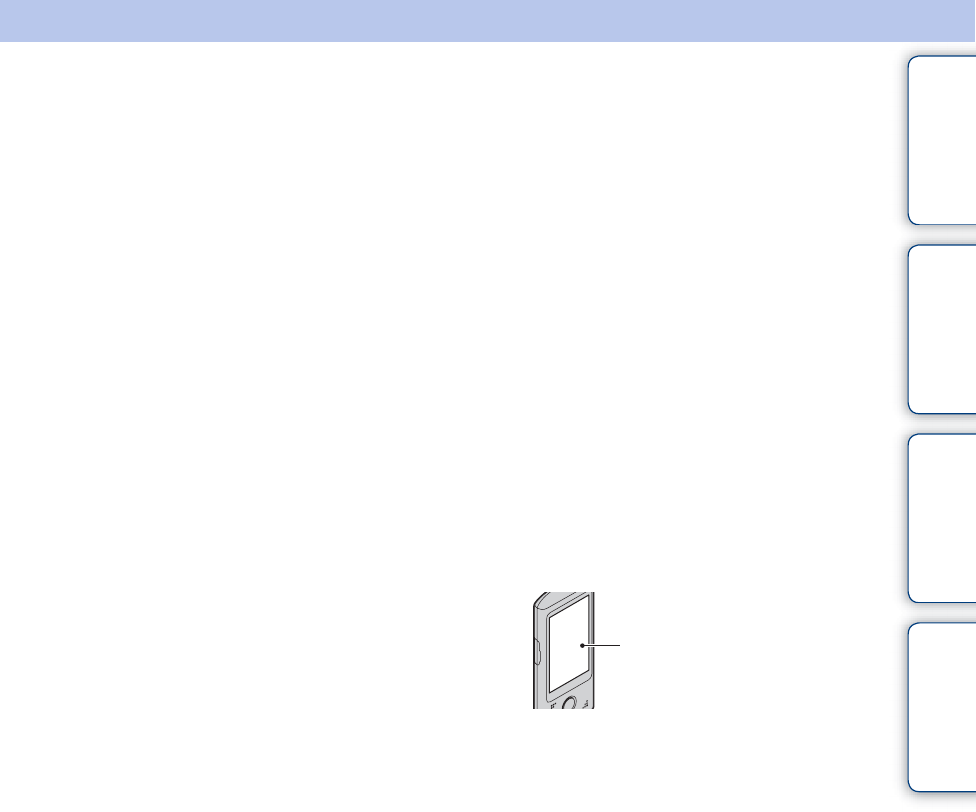
3US
Table of
contents
Operation
Search
Settings
Search Index
Notes on using the camera
Internal memory back up
Be sure to make a backup copy to protect your
data.
Notes on recording/playback and
connection
• Before you start recording, make a trial
recording to make sure that the camera is
working correctly.
• The camera is neither dust-proof, nor splash-
proof, nor water-proof. Read “Precautions”
(page 71) before operating the camera.
• Avoid exposing the camera to water. If water
enters inside the camera, a malfunction may
occur. In some cases, the camera cannot be
repaired.
• Do not aim the camera at the sun or other bright
light.
• Do not use the camera near a location that
generates strong radio waves or emits radiation.
Otherwise, the camera may not properly record
or play back images.
• Using the camera in sandy or dusty locations
may cause malfunctions.
• If moisture condensation occurs, remove it
before using the camera (page 71).
• Do not shake or strike the camera. It may cause
a malfunction and you may not be able to record
images. Furthermore, the recording media may
become unusable or image data may be
damaged.
• When connecting your camera to another device
with a cable, be sure to insert the connector plug
in the correct way. Pushing the plug forcibly
into the terminal will damage the terminal and
may result in a malfunction of your camera.
• Playback of movies other than those shot, edited
or composed on this camera is not guaranteed.
On camera’s temperature
The camera may get warm due to continuous use,
but it is not a malfunction.
On the overheat protection
Depending on the camera and battery temperature,
you may be unable to record movies or the power
may turn off automatically to protect the camera.
A message will be displayed on the LCD screen
before the power turns off or you can no longer
record movies.
Notes on the battery pack
• The battery pack is built into the camera. Charge
the camera before using for the first time.
• You can charge the battery pack even if it is not
completely discharged. In addition, even if the
battery pack is not fully charged, you can use the
partially charged capacity of the battery pack as
is.
• For details on the usable battery pack, see page
70.
Notes on the LCD screen and lens
• The LCD screen is manufactured using
extremely high-precision technology so over
99.99% of the pixels are operational for
effective use. However, some tiny black and/or
bright dots (white, red, blue or green) may
appear on the LCD screen. These dots are a
normal result of the manufacturing process and
do not affect the recording.
• Exposing the LCD screen or the lens to direct
sunlight for long periods may cause
malfunctions. Be careful when placing the
camera near a window or outdoors.
• Do not press against the LCD screen. The screen
may be discolored and that may cause a
malfunction.
• Images may trail across on the LCD screen in a
cold location. This is not a malfunction.
Black, white, red, blue or
green dots
Continued r

4US
Table of
contents
Operation
Search
Settings
Search Index
On image data compatibility
• This camera supports “MP4 format” as movie
file format. Therefore, movies recorded by this
camera cannot be played on devices that do not
support “MP4 format”.
• This camera does not support “AVCHD format”
and therefore is not compatible with the
playback and recording of movies in “AVCHD
format” like a Digital HD Video camera
recorder.
• Still images recorded by this camera are
compressed/recorded in JPEG format. The file
extension is “.JPG”.
• The camera conforms with DCF (Design rule
for Camera File system) universal standard
established by JEITA (Japan Electronics and
Information Technology Industries
Association).
• Sony does not guarantee that the camera will
play back images recorded or edited with other
equipment, or that other equipment will play
back images recorded with the camera.
Warning on copyright
Television programs, films, videotapes, and other
materials may be copyrighted. Unauthorized
recording of such materials may be contrary to the
provisions of the copyright laws.
No compensation for damaged
content or recording failure
Sony cannot compensate for failure to record or
loss or damage of recorded content due to a
malfunction of the camera or recording media, etc.
The images used in this handbook
• The images used as examples in this handbook
are reproduced images, and are not actual
images shot using the camera.
• Design and specifications are subject to change
without notice.
Notes on playing back movies on
other devices
The camera is compatible with MPEG-4 AVC/
H.264 Main Profile. Therefore, you cannot play
back images on the camera with the devices which
are not compatible with the MPEG-4 AVC/H.264.
On wireless network function
• The wireless network function built into this
camera has been confirmed to conform with Wi-
Fi specifications set forth by the Wi-Fi Alliance
(WFA).
• Depending on the region, access to a wireless
LAN may not be available, may require a
separate service charge, or communications may
be blocked or suffer from intermittent outages.
For details, check with your wireless LAN
administrator and/or service provider.
• Sony makes no guarantees whatsoever
regarding the provision of the network service.
Sony bears absolutely no responsibility for
damages that may arise from the use of the
network service even in the case of claims made
by a third-party.
Security precautions when using
wireless network products
• Security settings are absolutely critical when
using a wireless network. Sony bears no
responsibility for any damages that may arise
due to security problems occurring due to failure
to implement security measures or unavoidable
circumstances associated with the use of a
wireless network.
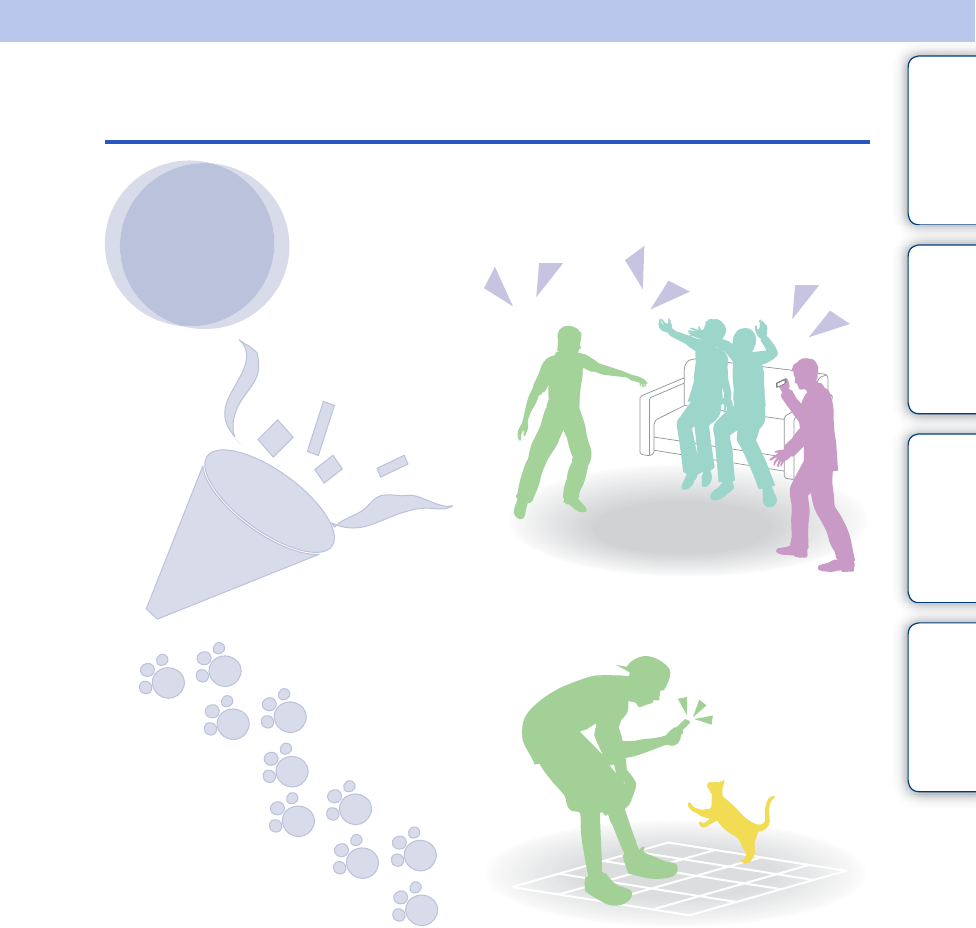
5US
Table of
contents
Operation
Search
Settings
Search Index
Life with “Bloggie”
Capture your life
At a party
Record still images at maximum 12M (4128 ×
3096) and movies at maximum 1920 × 1080
30p full high-vision (page 33, 34). Also, you
can record still images during movie
recording (page 30).
During a walk
Take compact “Bloggie” with you anywhere,
anytime. Take it out, and record casually.
Continued r
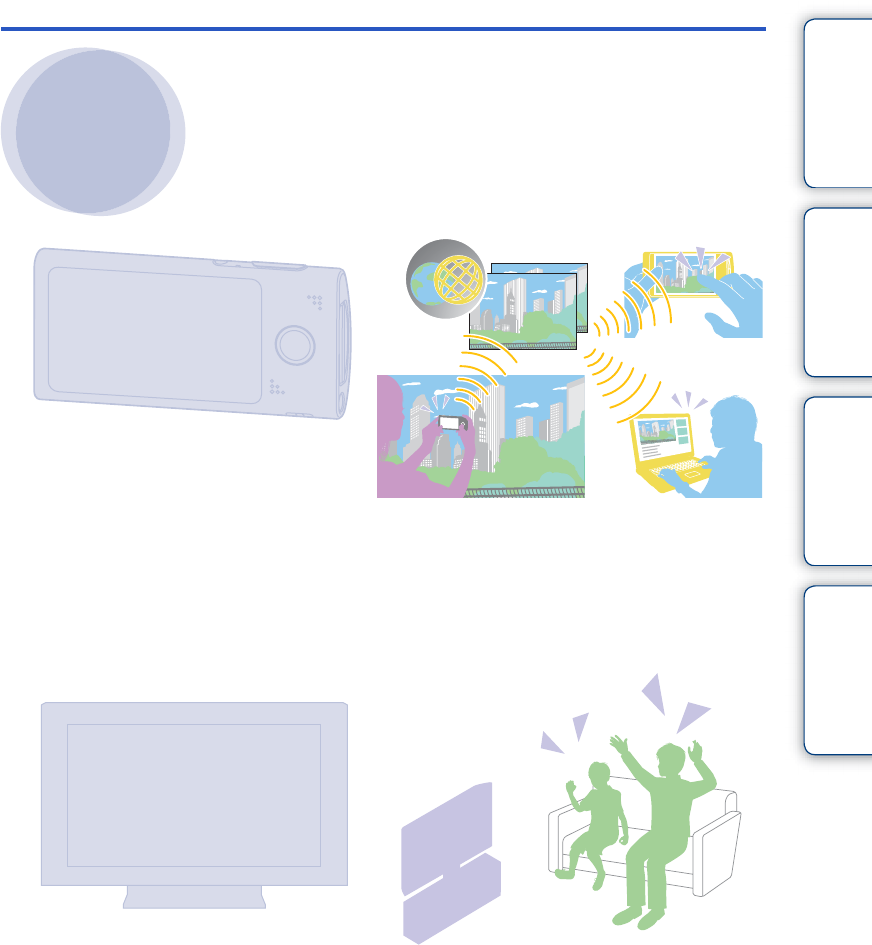
Table of
contents
Operation
Search
Settings
Search Index
6US
Import and upload captured
moments
You can use Wi-Fi to directly upload and
share recorded images from the camera
(page 47).
You can also transfer images to a device, such
as a smartphone, etc (page 49).
Share your life
Connect to TV
Connect your “Bloggie” to a TV with an
HDMI cable (sold separately), and enjoy
images on the big screen (page 60).

7US
Table of
contents
Operation
Search
Settings
Search Index
Table of contents
Notes on using the camera
How to use this handbook····································· 2
Notes on using the camera ··································· 3
Life with “Bloggie”·················································· 5
Operation Search ················································ 10
Settings Search··················································· 11
Identifying parts··················································· 13
List of buttons/icons displayed on the screen ····· 14
How to hold the camera ······································ 16
How to use the touch panel································· 18
Getting started
Checking the accessories supplied····················· 20
Charging the camera··········································· 21
Installing “PlayMemories Home (Limited version)”
on a computer ····················································· 24
Setting the clock·················································· 25
Shooting
Shooting (Still images) ········································ 27
Shooting (Movies) ··············································· 29
Zoom ··································································· 31
Light ···································································· 32
Photo Size··························································· 33
Movie Size··························································· 35
Flicker Reduction ················································ 36
Self-Timer···························································· 37

8US
Table of
contents
Operation
Search
Settings
Search Index
Viewing
Viewing································································ 38
Playback zoom···················································· 40
Delete·································································· 41
Volume control ···················································· 42
Using Wireless LAN (Wi-Fi)
What you can do with Wi-Fi ································ 43
Setting Wi-Fi························································ 44
Live Broadcast (Live Streaming) ························· 46
Uploading images directly (Share) ······················ 47
Uploading images to Personal Space
(Save to PlayMemories online service)··············· 48
Copying data to a smartphone ···························· 49
Computer
Recommended computer environment ··············· 50
Uploading images to a network service ·············· 52
Settings
Setting items ······················································· 11
TV
Viewing images on a TV ····································· 60

9US
Table of
contents
Operation
Search
Settings
Search Index
Troubleshooting
Troubleshooting ·················································· 62
Warning indicators and messages ······················ 67
Others
Number of still images and recordable time of
movies································································· 69
Built-in battery pack············································· 70
Precautions ························································· 71
Specifications ······················································ 73
Index
Index ··································································· 75

10US
Table of
contents
Operation
Search
Settings
Search Index
Operation Search
Shooting still images Shooting (Still images)······································· 27
Shooting movies Shooting (Movies) ··············································· 29
Changing image size Photo Size ····························································· 33
Movie Size ····························································· 35
Deleting images Delete······································································ 41
Format ···································································· 58
Displaying enlarged
images
Playback zoom····················································· 40
Changing clock
settings
Date & Time Setting············································ 59
Initializing settings Initialize··································································· 55
Viewing on TVs Connecting with an HDMI cable
(sold separately) ·················································· 60
Marking the images to
upload
Share······································································· 47
Uploading images to a
network service
Wi-Fi ········································································ 43
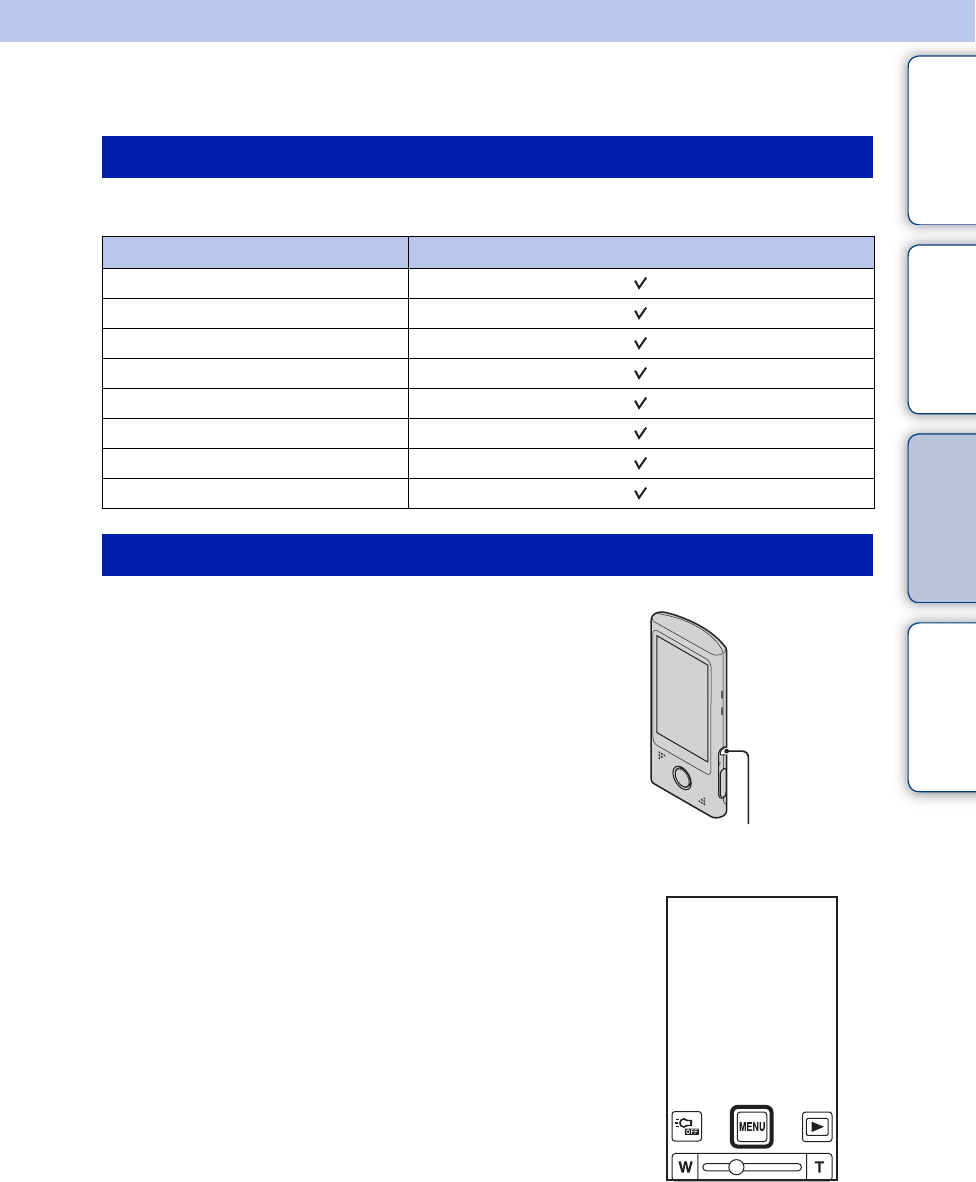
11US
Table of
contents
Operation
Search
Settings
Search Index
Settings Search
All settings can be changed in both shooting and playback mode.
1Press the ON/OFF (Power) button.
2Tap [MENU] t [Main Settings].
Setting items
Items Shooting/Playback mode
Wi-Fi Settings
Beep
Demo Mode
Initialize
HDMI Output
LUN Settings(USB)
Format
Date & Time Setting
How to set items
ON/OFF (Power) button
Continued r
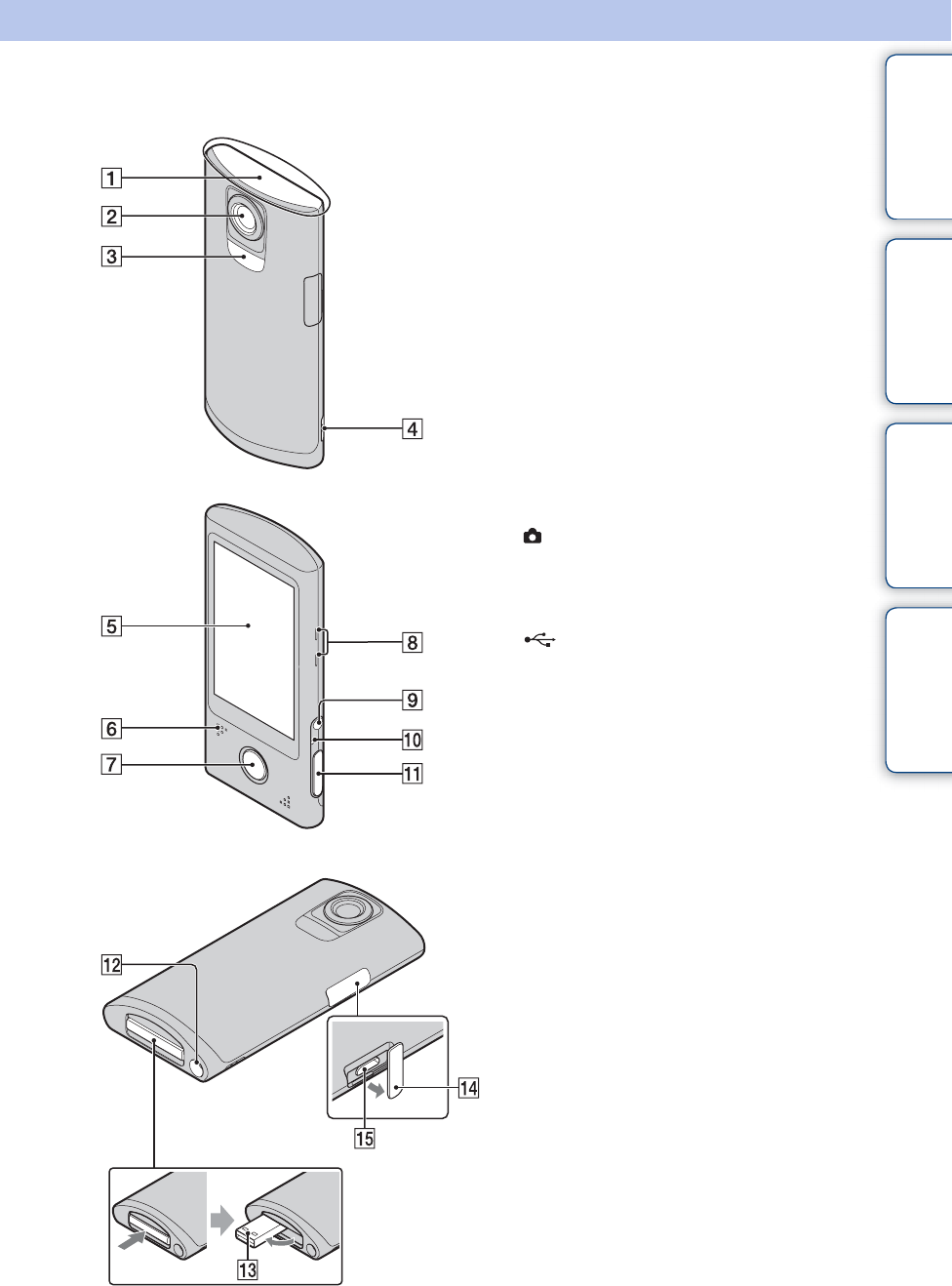
13US
Table of
contents
Operation
Search
Settings
Search Index
Identifying parts
ABuilt-in antenna
• Do not cover the built-in antenna part with
your hand when using Wi-Fi.
BLens
CLight
DHook for wrist strap
ELCD screen/Touch panel
FSpeaker
GMovie button
HMicrophone
ION/OFF (Power) button
• Press and hold the ON/OFF (Power) button
for at least 7 seconds to force-quit the
camera.
JCharge lamp
K (Shutter) button
LTripod receptacle
• Do not hold the camera when attaching the
tripod.
M (USB) jack
NJack cover
OHDMI OUT jack (60)
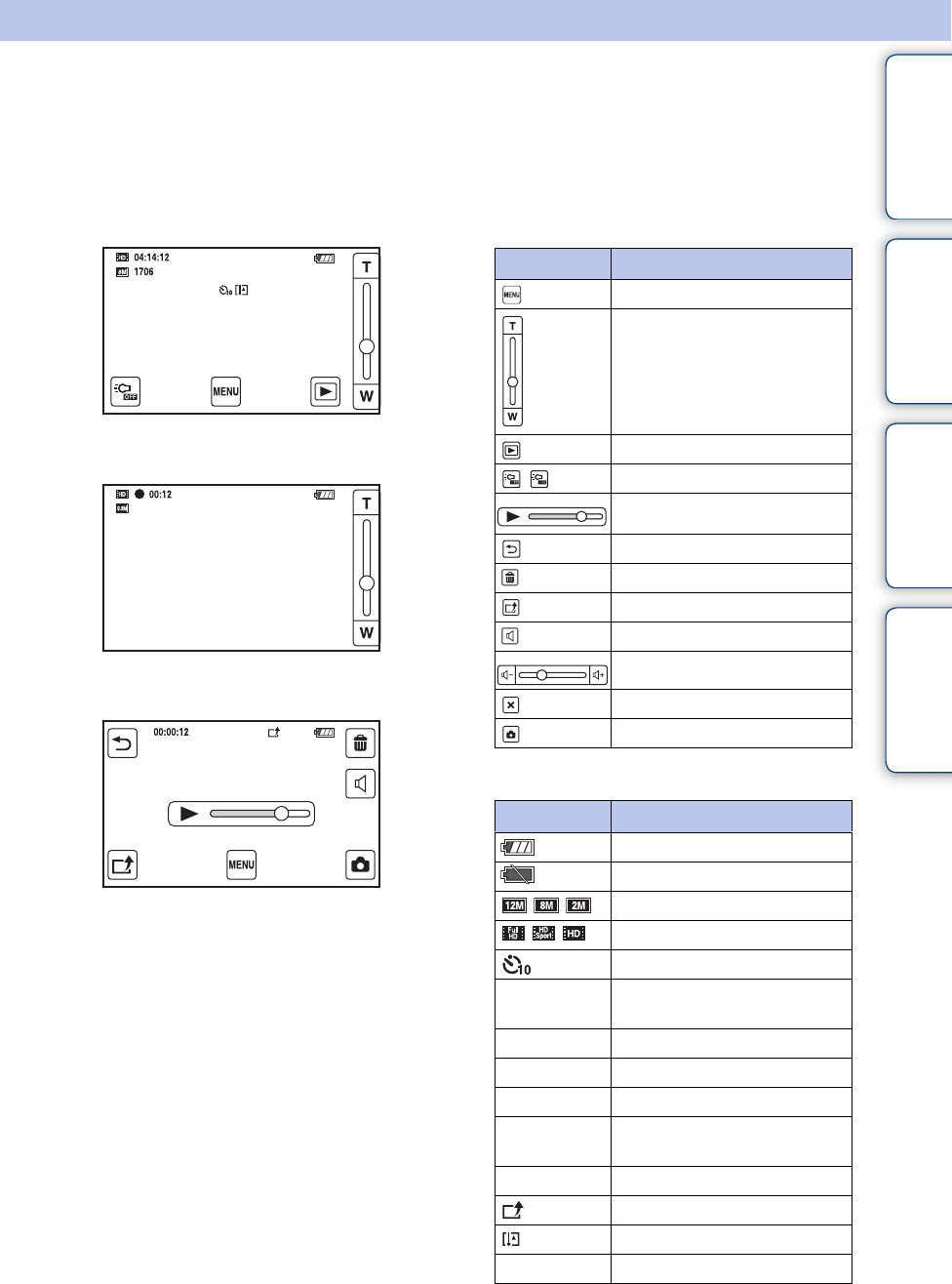
14US
Table of
contents
Operation
Search
Settings
Search Index
List of buttons/icons displayed
on the screen
Buttons and icons are displayed on the screen to indicate the camera status.
When in standby for shooting
When shooting movies
When playing back
Buttons
Icons
Display Indication
Menu
Zoom scaling
Playback
Light
Playback bar
Returning to the index screen
Delete
Share
Adjusting volume
Volume
Exit the function
Shooting mode
Display Indication
Battery remaining
Low battery warning
Photo Size (resolution)
Movie Size
Self-timer
1706 Number of recordable still
images
z(green) AE/AF lock
04:14:12 Recordable time
00:12 Recording time (m:s)
2012-1-1
9:30 AM Recorded date/time of the
playback image
z(red) During movie recording
Share pending
Overheating warning
00:00:12 Counter
Continued r
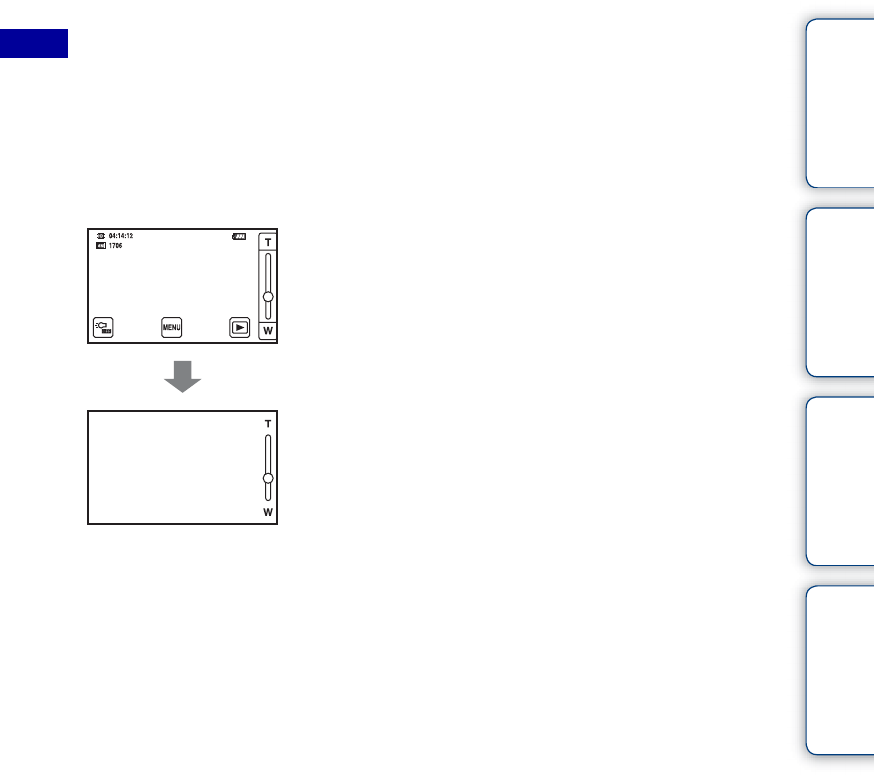
15US
Table of
contents
Operation
Search
Settings
Search Index
• Indicators and their positions are approximate
and differ from what you actually see.
• The screen display shifts both horizontally and
vertically depending on the camera aspect.
• The screen display disappears automatically
after about 4 seconds. You can display it again
by tapping the LCD screen.
Notes
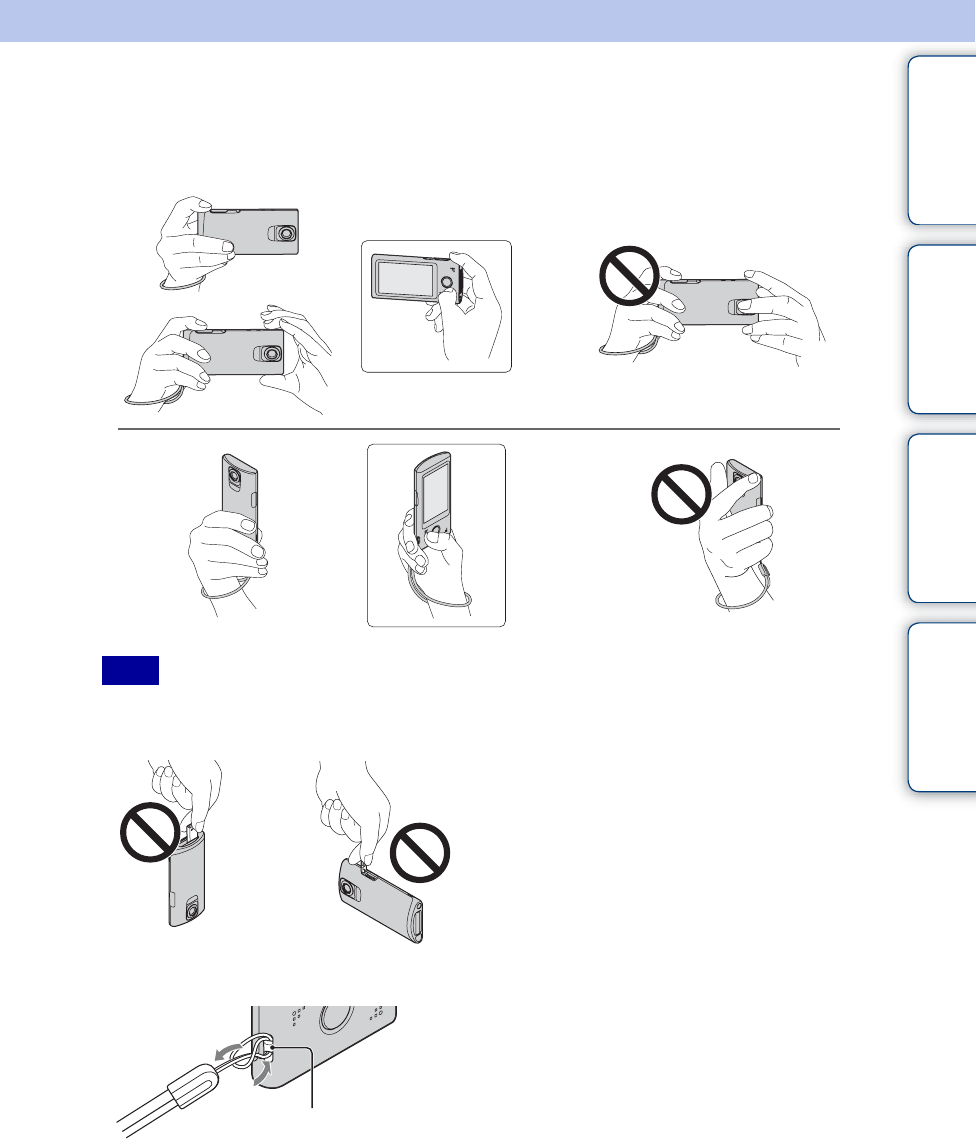
16US
Table of
contents
Operation
Search
Settings
Search Index
How to hold the camera
Be careful not to block the lens, microphone, light or built-in antenna with your finger when
shooting.
• Do not cover the built-in antenna part with your hand if Wi-Fi connection is difficult.
Do not hold the USB jack or HDMI OUT jack cover.
Attach the strap and place your hand through its loop to prevent the camera from damage by
being dropped.
Note
Hook
Continued r
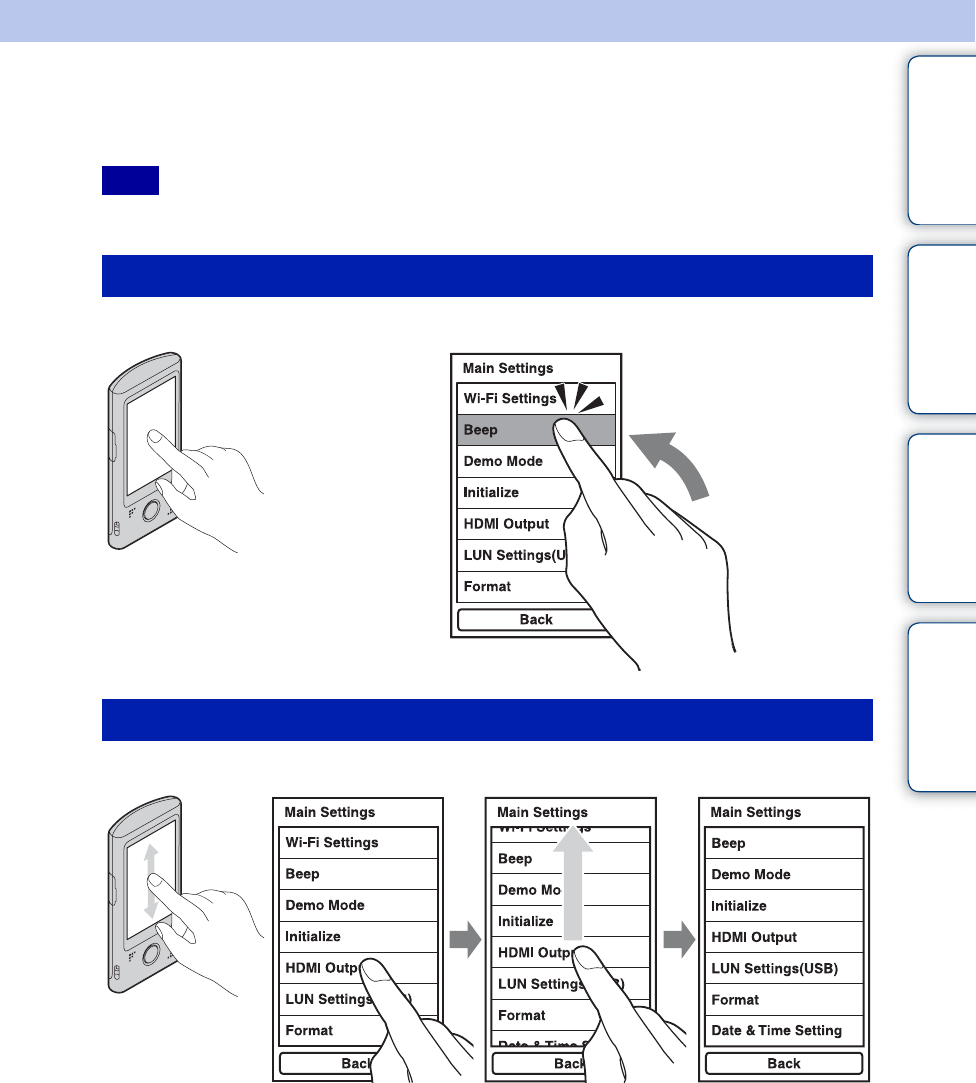
18US
Table of
contents
Operation
Search
Settings
Search Index
How to use the touch panel
You can operate the camera by tapping the buttons on the LCD screen or dragging the screen.
• Do not operate with a sharp-pointed object, such as pen or finger nail.
Lightly touch the buttons or items on the screen with your finger.
Touch and slide the screen with your finger.
Note
Select the items (Tap)
Scroll the screen (Drag)
Drag upwards Release your finger

20US
Table of
contents
Operation
Search
Settings
Search Index
Checking the accessories
supplied
• USB connection support cable (1)
Use this if the USB jack of the camera cannot be connected to the computer (page 21).
• Wrist strap (1)
• Software (page 24)
The following contents are included in the internal memory of this camera.
– PlayMemories Home (Limited version)
– Bloggie Handbook (this manual)
• Instruction Manual (1)
• Important Notice (1)
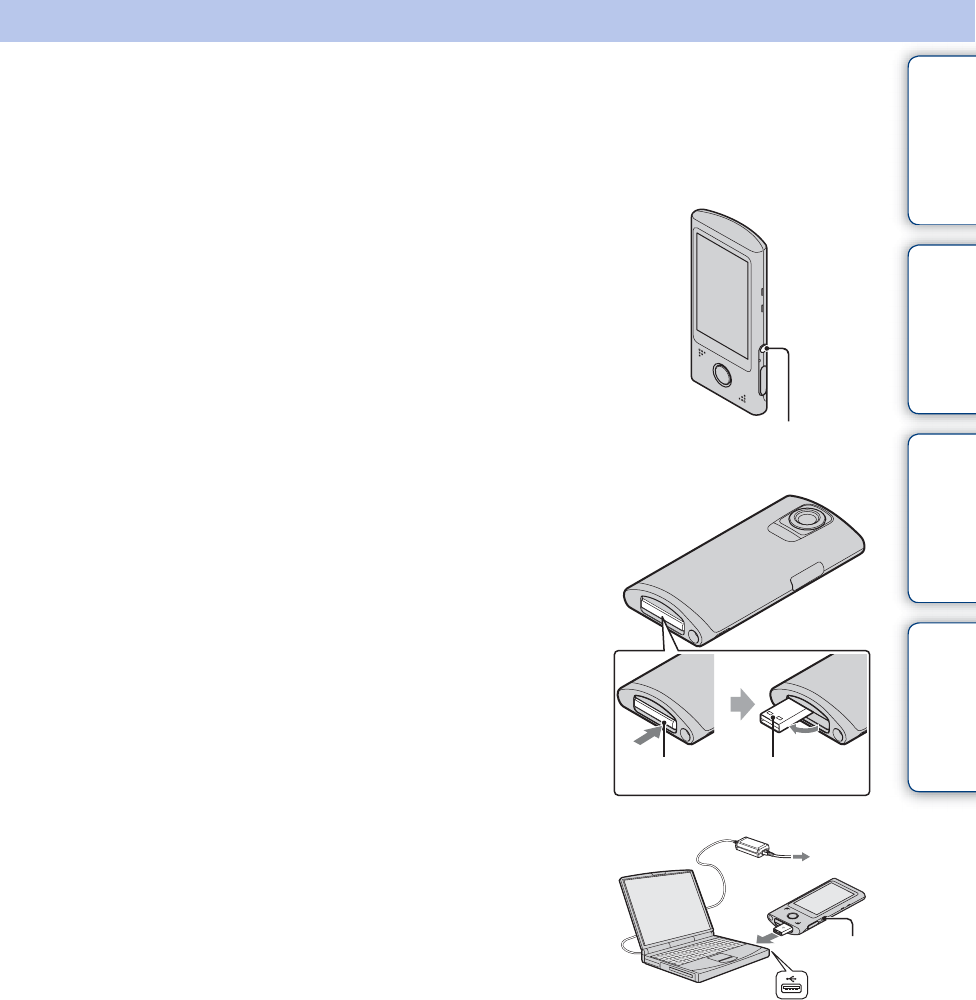
21US
Table of
contents
Operation
Search
Settings
Search Index
Charging the camera
The camera’s battery is continuously recharged whenever the camera is connected to a running
computer.
1Press the ON/OFF (Power) button to turn off
the camera.
2Push the “PUSH” part at the bottom of the
camera.
The USB jack comes out as shown in the illustration.
3Connect the camera to the computer that is
turned on.
The charge lamp lights up in orange, and charging starts.
When the charge lamp turns off, charging is finished.
• The charge lamp may turn off when the temperature is outside
of the recommended operating temperature (10°C to 30°C
(50°F to 86°F)).
4When charging is finished, delete the USB connection between the
camera and computer.
• Install PlayMemories Home (pre-loaded on the internal memory) after completing the procedure
above.
ON/OFF (Power)
button
USB jackPUSH
Charge
lamp
Continued r
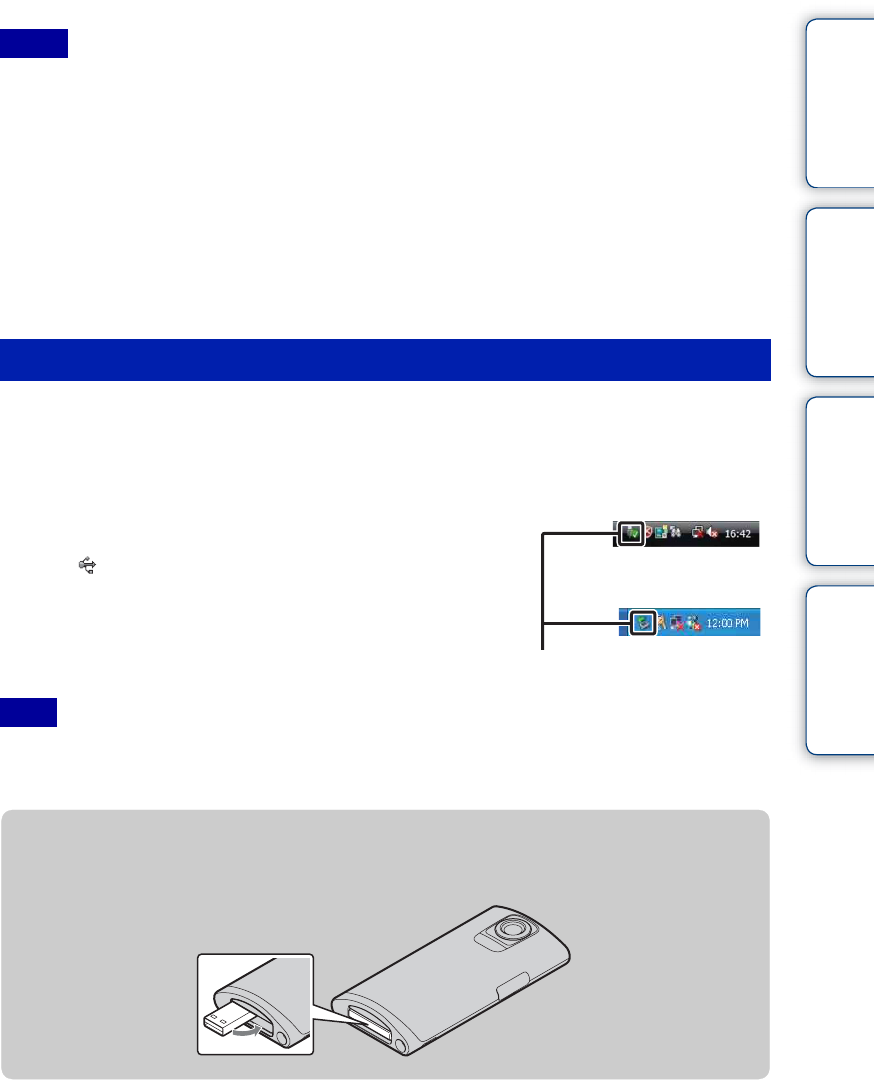
22US
Table of
contents
Operation
Search
Settings
Search Index
• While the camera is connected to a computer, you cannot operate the camera. Be sure to disconnect the
camera before operation.
• Do not apply force to the camera, when you connect the camera to a computer. This may cause damage to
the camera or the computer.
• When you connect the camera to a notebook computer that is not connected to an AC power source, the
battery of the notebook computer may be depleted rapidly. Do not leave the camera connected to the
computer for a long time.
• Charging the battery or the connection with customized or hand-built computers is not guaranteed.
Depending on the type of USB device used, charging may not function properly.
• If you do not intend to use the camera for an extended period, charge the camera once every 6 to 12
months to maintain battery performance.
Perform the procedures from step 1 to 3 below before:
• Disconnecting the USB connection support cable.
• Turning off the camera.
1Double-click the disconnect icon on the
tasktray.
2Click (USB Mass Storage Device) t [Stop].
3Confirm the device on the confirmation
window, then click [OK].
• Drag and drop the drive icon to the “Trash” icon beforehand when you use a Mac computer, and the
camera is disconnected from the computer.
Notes
Deleting the USB connection
Note
Windows Vista
Disconnect icon
Windows XP
zTo retract the USB jack
Push the USB jack back in the direction of the arrow until it clicks.
Continued r
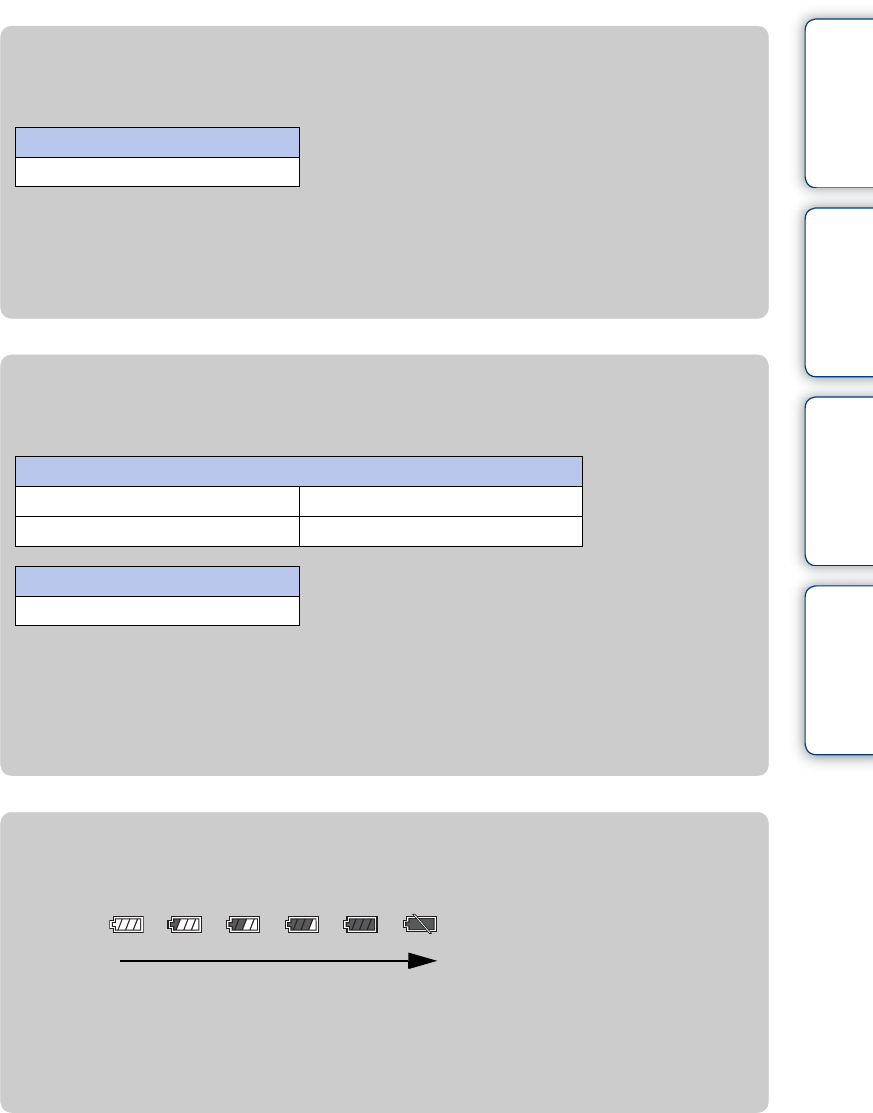
23US
Table of
contents
Operation
Search
Settings
Search Index
zHow long does it take to charge the camera?
Charging time
• Time required to charge a fully depleted battery at a temperature of 25°C (77°F). Charging may take
longer under certain circumstances or conditions.
• You can rapid-charge the camera with a USB charger AC-UD20 (sold separately). To use, connect
the USB charger to the USB jack of the supplied USB connection support cable, or directly to the
USB jack of the camera.
Full charge time
Approx. xx min.
zHow long can I record or play back images?
Standard battery life
*1Recording time is the time when you set image size to [1280×720 30p].
*2 Continuous recording time shows the approximate time available of a fully charged battery pack.
Continuous recording of movies is possible for approximately 29 minutes. Also, recording stops
automatically to prevent the file size from exceeding 2 GB.
*3Typical recording time shows the approximate time available of a fully charged battery pack when
you repeat recording start/stop, turning the power on/off and zooming.
Recording time*1
Continuous recording time*2Approx. xx min.
Typical recording time*3Approx. xx min.
Playback time
Approx. xx min.
zChecking the remaining battery charge
A remaining charge indicator appears on the upper right of the LCD screen.
• The displayed battery remaining indicator may not be correct under certain circumstances.
• If the camera is running on battery power and you do not operate the camera for about 5 minutes,
the camera turns off automatically to prevent wearing down the battery (Auto power off function).
• The Clock Setting screen appears when the camera is turned on for the first time (page 25).
• It takes about one minute until the correct battery remaining indicator appears.
High Low
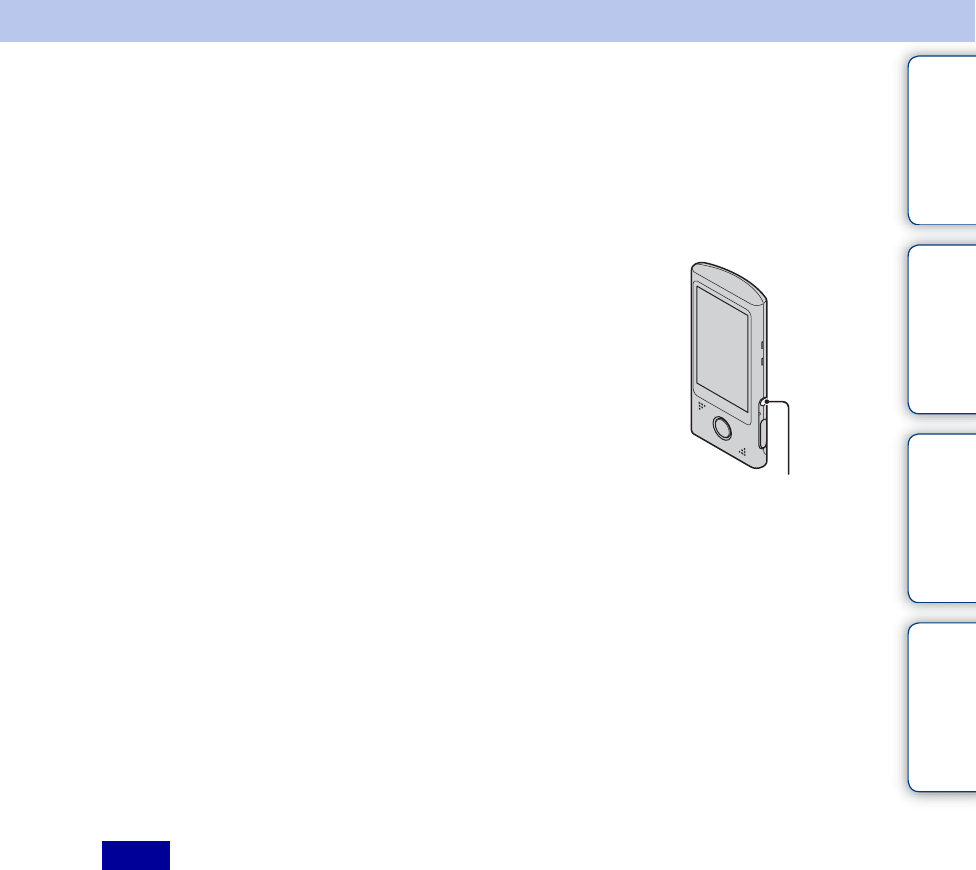
24US
Table of
contents
Operation
Search
Settings
Search Index
Installing “PlayMemories Home
(Limited version)” on a computer
Install the built-in software “PlayMemories Home” on a computer (Windows).
You can import and view recorded images on a computer using “PlayMemories Home”.
1Press the ON/OFF (Power) button to turn on
the camera.
2Connect the camera (turned on) to the computer (page 21).
Windows 7: Device Stage appears.
Windows XP/Windows Vista: AutoPlay Wizard appears.
3Windows 7: click [xxxxx].
Windows XP/Windows Vista: click [xxxxx].
4Follow the instructions on the screen to complete the installation.
After the installation is completed, “PlayMemories Home (camera built-in version)” will be
launched.
• When your computer is connected to the Internet, the installation guide for “Extension” will be
displayed. Continue the installation following the instructions.
• For details on “PlayMemories Home”, see page xx.
• Log in with administrative right over the computer.
• If Device Stage does not start when using Windows 7, click [Computer], then double-click the camera
icon t media icon t [APPLICATION] t “xxxxx.exe”.
• If the AutoPlay Wizard does not appear when using Windows XP/Windows Vista, double-click
[Computer] (in Windows XP, [My Computer]) t [xxxxx] t “xxxxx.exe”.
• “PlayMemories Home” is not supported by Mac. For details when using Mac, see page xx.
Notes
ON/OFF (Power)
button
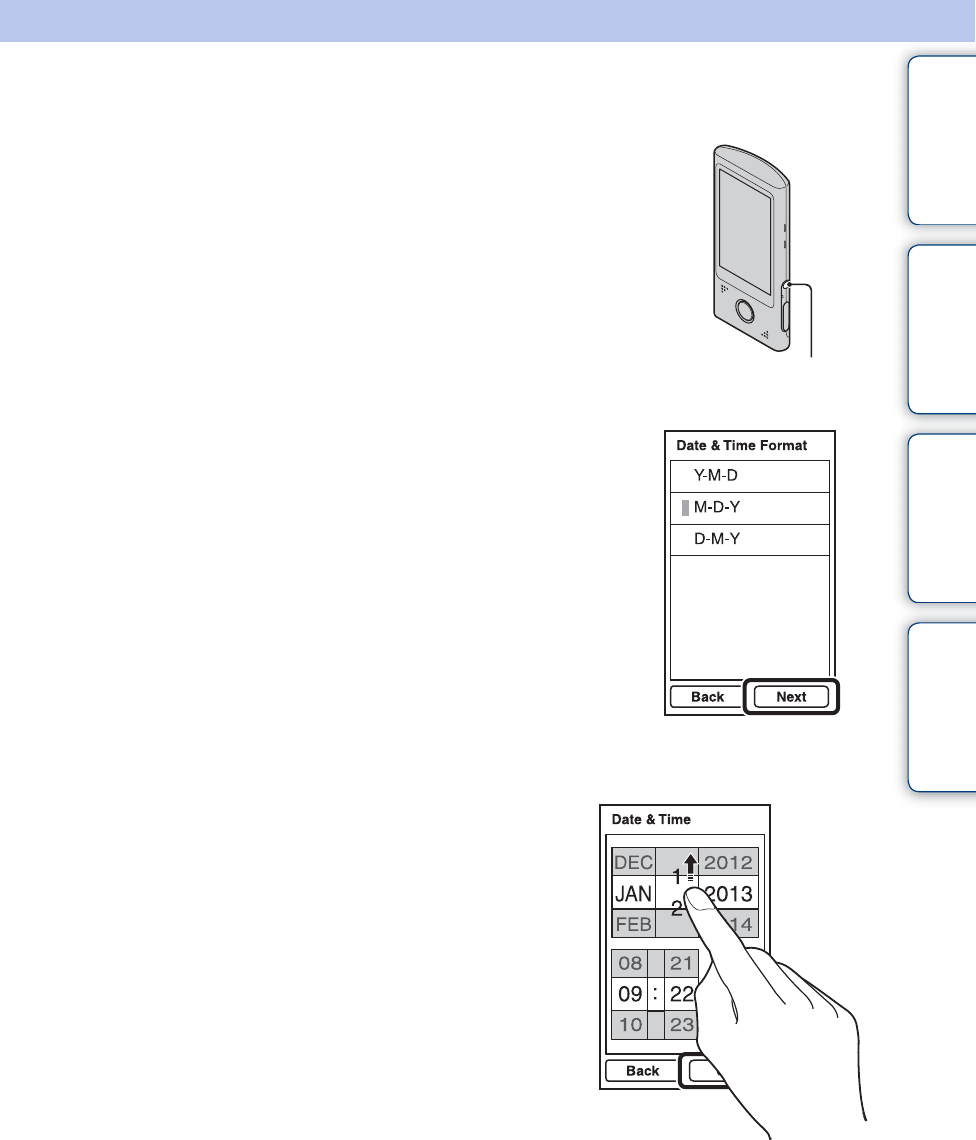
25US
Table of
contents
Operation
Search
Settings
Search Index
Setting the clock
1Press the ON/OFF (Power) button.
The camera is turned on.
The demonstration movie plays back when you turn on the
camera for the first time.
2Select the desired date display format, then tap
[Next].
3Select Daylight Savings [On]/[Off], then tap
[Next].
4Scroll each item up or down to set the
desired date and time, and tap [OK].
Midnight is indicated as 12:00 AM, and noon as 12:00
PM.
ON/OFF (Power)
button
Continued r
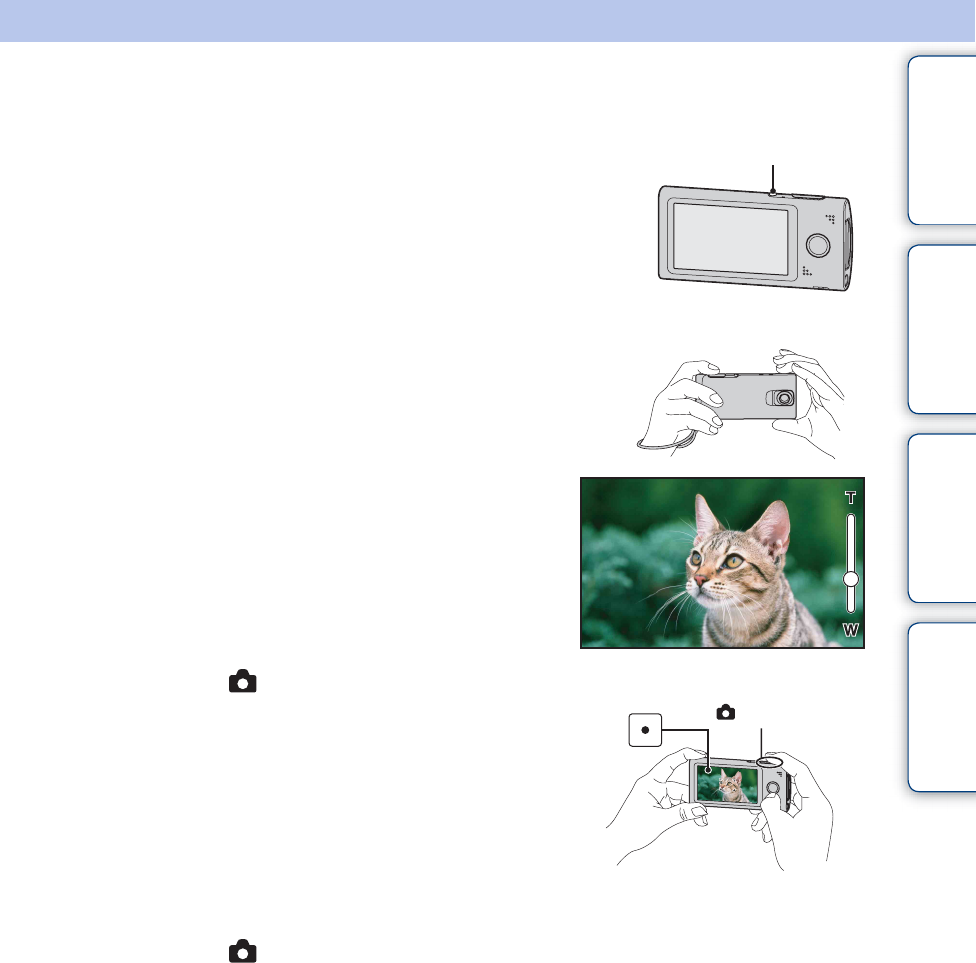
27US
Table of
contents
Operation
Search
Settings
Search Index
Shooting (Still images)
1Press the ON/OFF (Power) button.
2Compose the shot.
Be sure not to place fingers on the lens.
Touch and hold T on the T/W (zoom) bar to zoom in,
W to zoom out.
3Press the (Shutter) button halfway
down.
When the image is in focus, a beep sounds and the z
indicator (AE/AF lock) lights on the top of the display.
4Press the (Shutter) button fully down.
ON/OFF (Power) button
AE/AF lock indicator
(Shutter) button
Continued r

28US
Table of
contents
Operation
Search
Settings
Search Index
zIf you shoot a still image of a subject that is difficult
to focus on
• The shortest shooting distance is approximately 10 cm (4 inches).
• If the camera cannot focus on a subject automatically, the AE/AF lock indicator changes to slow
flashing and the beep does not sound. Recompose the shot.
• Focusing may be difficult in the following situations:
– It is dark and the subject is distant.
– The contrast between the subject and the background is poor.
– The subject is seen through glass.
– The subject is moving quickly.
– There is reflective light or shiny surfaces.
– The subject is flashing.
– The subject is backlit.
zWhen shooting portrait
• When the camera detects faces, the white frames
appear, and the focus and exposure are adjusted to the
faces automatically.
• The frames turn green when the faces are in focus by
pressing the (Shutter) button half way down.
• The camera may not detect faces depending on the
shooting condition.
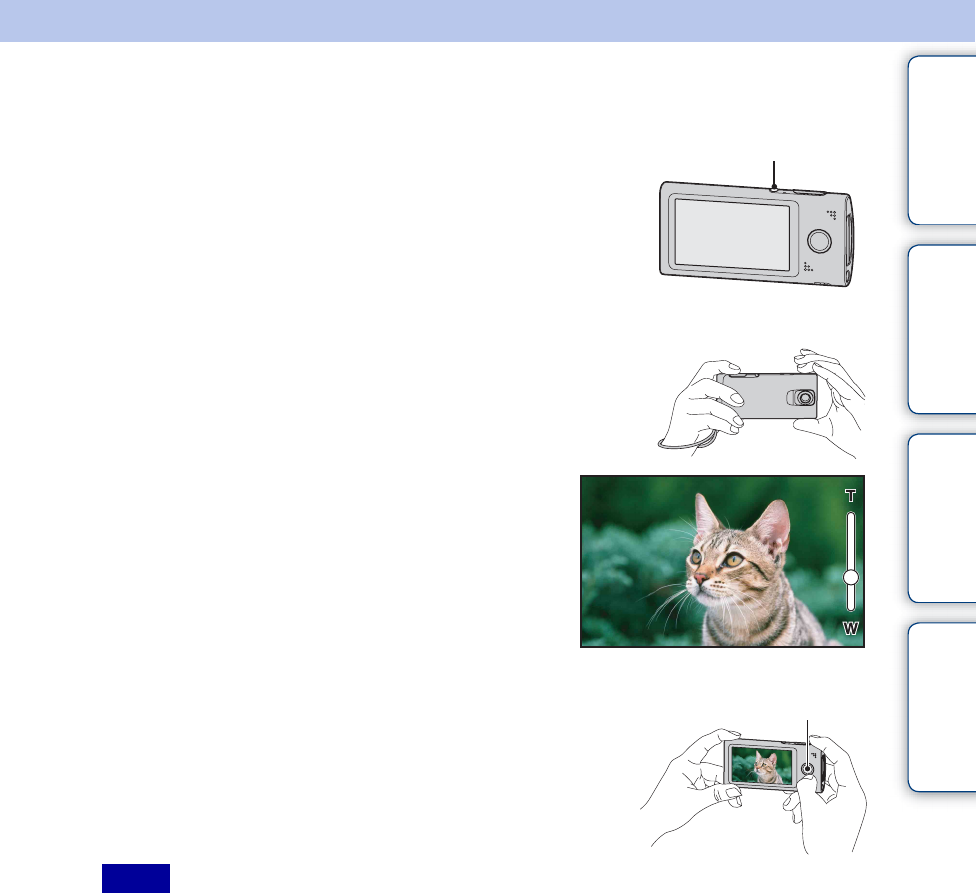
29US
Table of
contents
Operation
Search
Settings
Search Index
Shooting (Movies)
1Press the ON/OFF (Power) button.
2Compose the shot.
Be sure not to place fingers on the lens.
Touch and hold T on the T/W (zoom) bar to zoom in,
W to zoom out.
3Press the movie button.
To finish shooting the movie, press the movie button again.
• Continuous recording is possible for approximately 29 minutes.
• The maximum size of a single movie file is approximately 2 GB. Recording stops before 29 minutes if
the file size reaches approximately 2 GB during movie recording.
Notes
ON/OFF (Power) button
Movie button
Continued r

30US
Table of
contents
Operation
Search
Settings
Search Index
zTo shoot still images during movie recording
• Press the (Shutter) button fully down during movie recording.
• The recorded still image appears small on the LCD screen of the camera.
• The image sizes are as follows, depending on the movie size.
– 1920 × 1080 30p: 1920 × 1080
– 1280 × 720 30p/60p: 1280 × 720
zWhat is the recording method of this camera?
For MPEG-4 AVC/H.264, the camera supports high definition images with an effective
total number of scanning lines of 1080 or 720. The number of recorded image pixel is
1920 × 1080 or 1280 × 720, approximately 30 or 60 frames per second, and the image is
recorded in progressive mode.
• MPEG: Moving Picture Experts Group
• AVC: Advanced Video Codec
MPEG-4 AVC/H.264 is a standard of video camera, which uses highly efficient image
compression encoding technology to record HD (high definition) images. Compared with
the existing image compression encoding technology, MPEG-4 AVC/H.264 is able to
compress images even more effectively.

31US
Table of
contents
Operation
Search
Settings
Search Index
Zoom
You can enlarge the image when shooting. The camera’s zoom function can enlarge images up
to 4×.
1Touch and hold T or W.
Touch and hold T to zoom in, W to zoom out.
• Only Digital zoom is available with this camera.
• You may not be able to zoom in or out images smoothly when using zoom function.
• Image quality decreases as the images are digitally processed.
Notes
T side
W side
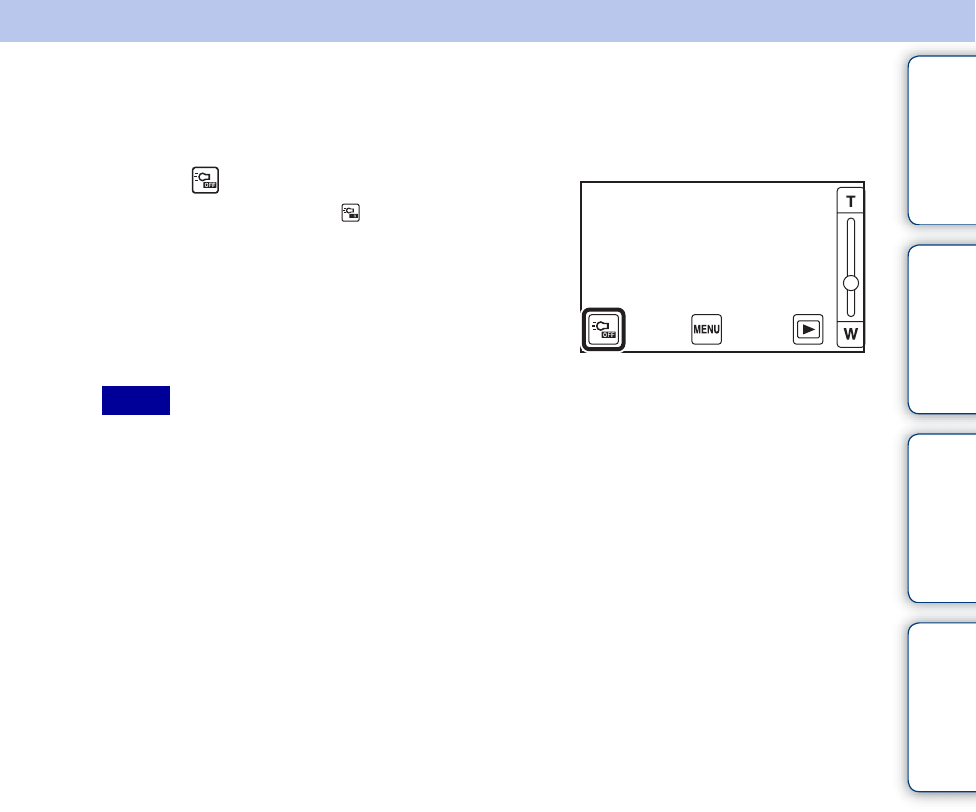
32US
Table of
contents
Operation
Search
Settings
Search Index
Light
You can shoot with the light of the camera turned on.
1Press on the shooting screen.
To turn off the light, press again.
• You can use the light in shooting mode only.
• The camera emits very bright light. Do not aim directly at eyes at close range.
• Battery power wears down faster when the light is turned on.
Notes
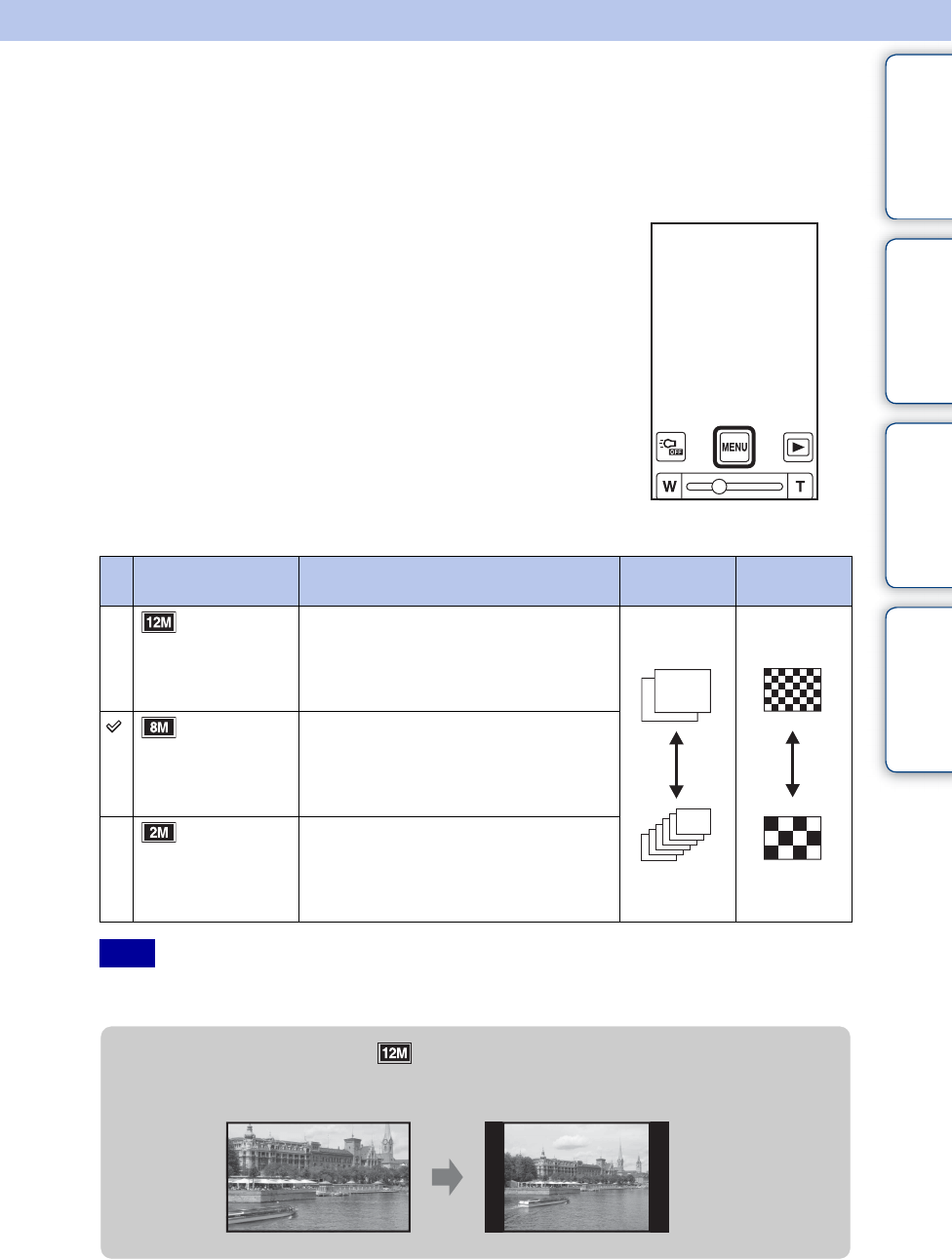
33US
Table of
contents
Operation
Search
Settings
Search Index
Photo Size
The photo size determines the size of the image file that is recorded when you take an image.
The larger the photo size, the more detail will be reproduced when the image is printed on large-
format paper. The smaller the photo size, the more images can be recorded.
1Tap [MENU] t [Shooting Settings].
Tap the LCD screen when the screen display is not shown.
2Tap the desired size from [Photo Size].
• When you print still images recorded with 16:9 aspect ratio, both edges may be cut off.
Photo Size Usage guidelines No. of
images
Printing
(4128×3096 4:3)
For prints up to A3+ size
(3840×2160
16:9)
For viewing on a high-definition TV,
and for prints up to A4 size
(1920×1080
16:9)
For viewing on a high-definition TV
Note
Less
More
Fine
Rough
zWhen you select (4128 × 3096 4:3)
The aspect ratio switches to 4:3 when shooting images.
Continued r
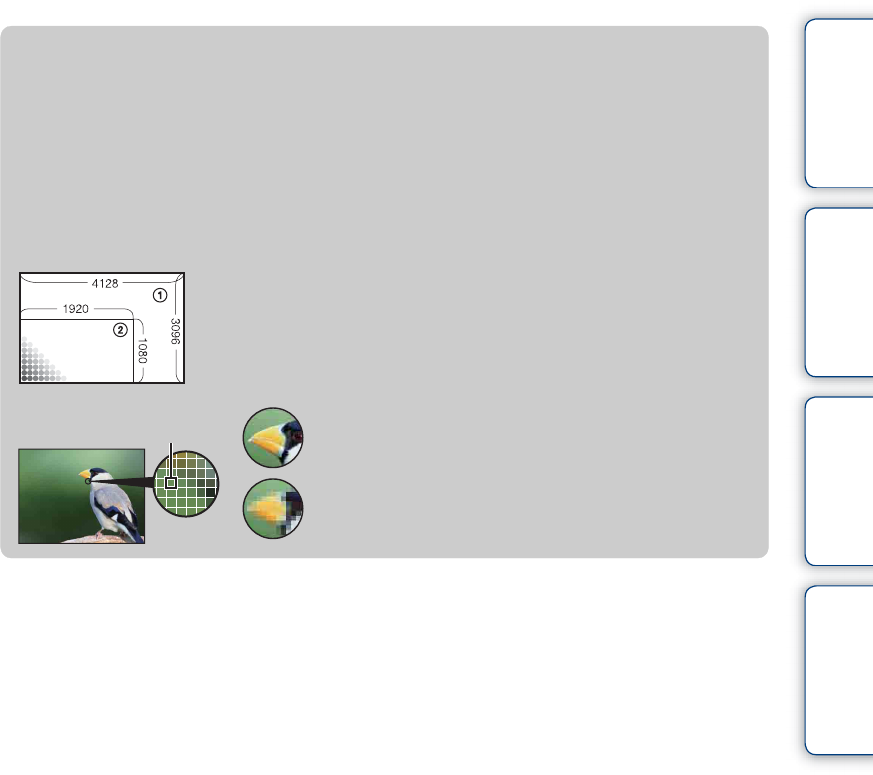
34US
Table of
contents
Operation
Search
Settings
Search Index
zOn “image quality” and “image size”
A digital image is made up of a collection of small dots called pixels.
If it contains a large number of pixels, the image becomes large, it takes up more memory,
and the image is displayed in fine detail. “Image size” is shown by the number of pixels.
Although you cannot see the differences on the screen of the camera, the fine detail and data
processing time differ when the image is printed or displayed on a computer screen.
Description of the pixels and the image size
1Image size: 12M
4128 pixels × 3096 pixels = 12,780,288 pixels
2Image size: 2M
1920 pixels × 1080 pixels = 2,073,600 pixels
Many pixels
(Fine image quality and large file size)
Few pixels
(Rough image quality but small file size)
Pixels
Pixel
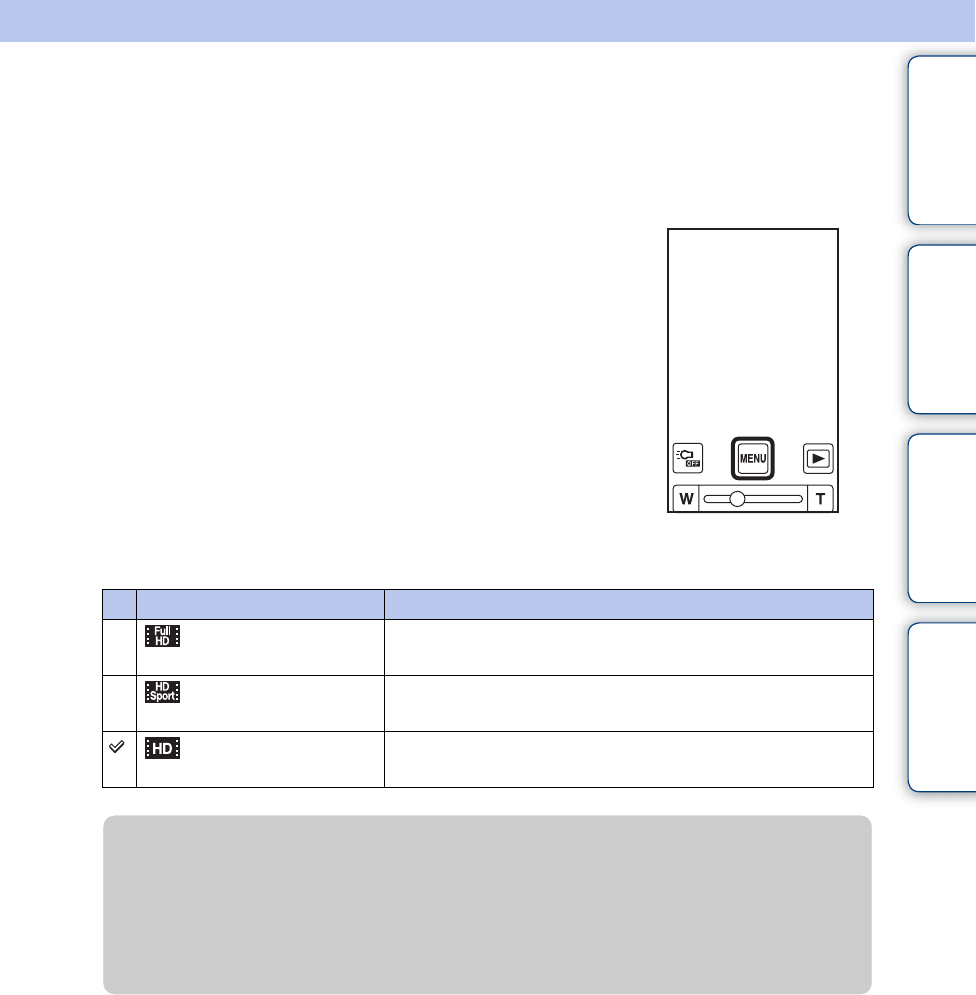
35US
Table of
contents
Operation
Search
Settings
Search Index
Movie Size
The larger the movie size, the higher the movie quality.
The movies shot with the camera will be recorded in MPEG-4 AVC/H.264 Main Profile,
approximately 30 or 60 frames per second, Progressive, AAC LC, “MP4 format”.
1 Tap [MENU] t [Shooting Settings].
Tap the LCD screen when the screen display is not shown.
2Tap the desired size from [Movie Size].
Movie Size Usage guidelines
(1920×1080 30p) Shoots HD (high definition) quality movies in sizes suited
for display on computer or high definition TV
(1280×720 60p) Shoots the rapidly moving action scenes such as sports
smoothly with HD (high definition) quality
(1280×720 30p) Shoots HD (high definition) quality movies in sizes suited
for display on computer
zProgressive playback
The camera supports progressive mode*, which is used in computers, and therefore is suited
for playing back images on computers.
* The progressive mode is a type of movie recording method, which reads out all image pixels at
once.
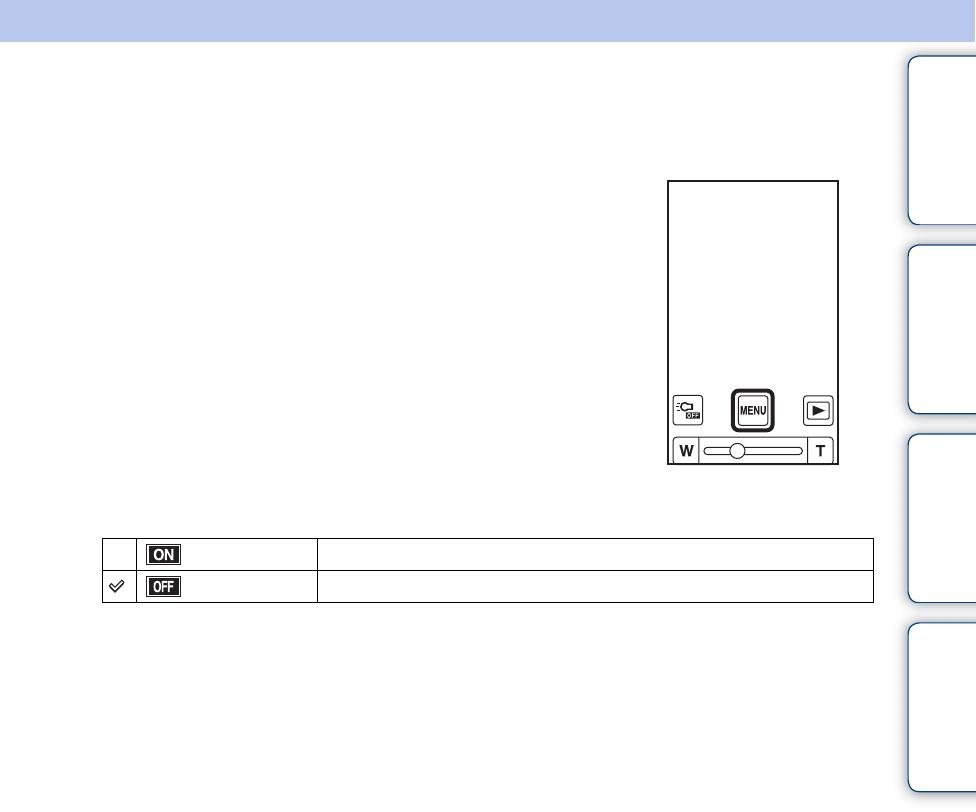
36US
Table of
contents
Operation
Search
Settings
Search Index
Flicker Reduction
Curbs the flicker generated by fluorescent by using the electro-shutter.
1Tap [MENU] t [Shooting Settings].
Tap the LCD screen when the screen display is not shown.
2Tap the desired mode from [Flicker Reduction].
(On) Uses the Flicker Reduction.
(Off) Does not use the Flicker Reduction.
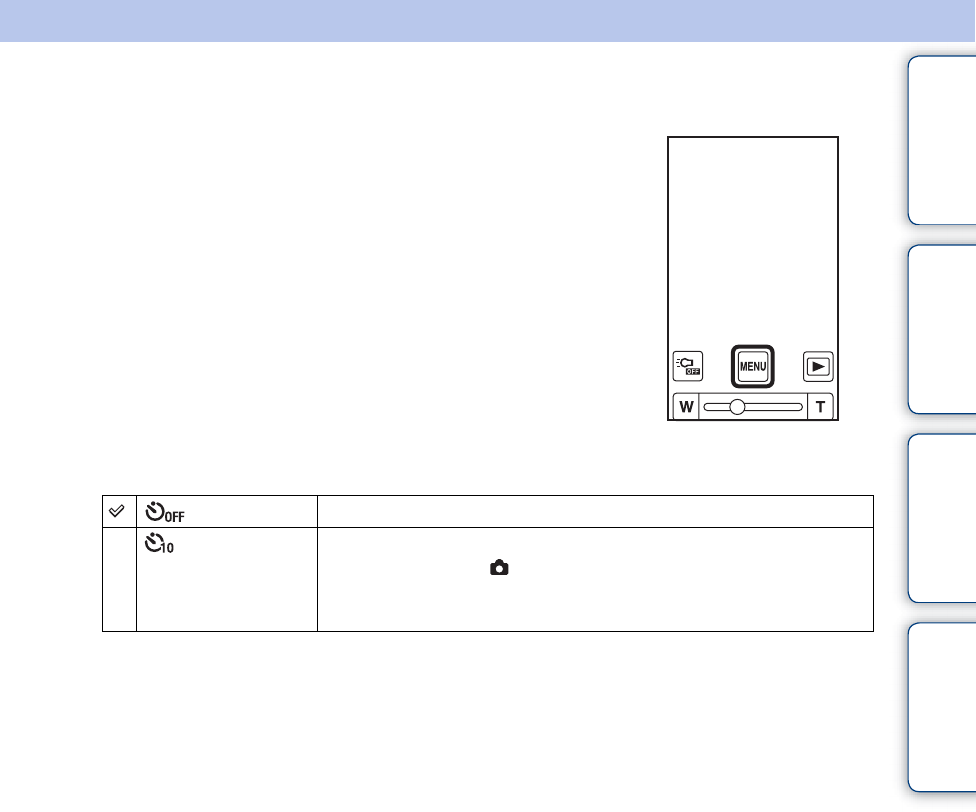
37US
Table of
contents
Operation
Search
Settings
Search Index
Self-Timer
1Tap [MENU] t [Shooting Settings].
Tap the LCD screen when the screen display is not shown.
2Tap the desired mode from [Self-Timer].
(Off) Does not use the self-timer.
(10sec) Sets the 10-second delay self-timer.
When you press the (Shutter) button or the movie button, a self-
timer icon flashes, and after rapid beep sounds are heard, the
camera will shoot.
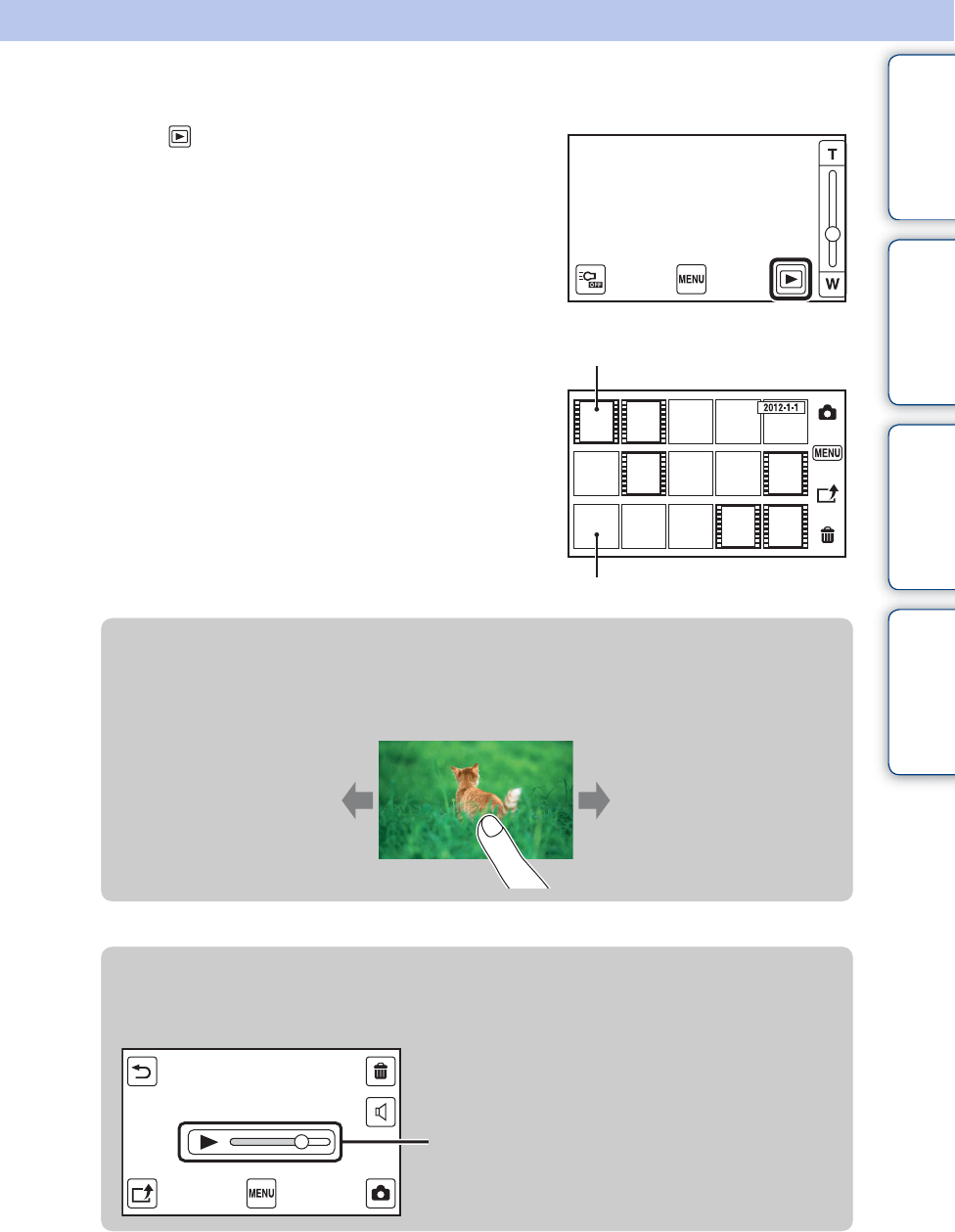
38US
Table of
contents
Operation
Search
Settings
Search Index
Viewing
1Tap (Playback) to switch to playback
mode.
The index screen appears.
2Select an image and tap.
A single movie plays back when an image is selected.
Movie
Still image
zTo show previous/next images
Drag your finger in the direction of the arrows.
You can send multiple images at one time by flicking.
Previous Next
zTo search for a point in a movie to start playback
Drag z on the playback bar to the desired scene.
Playback bar
Continued r
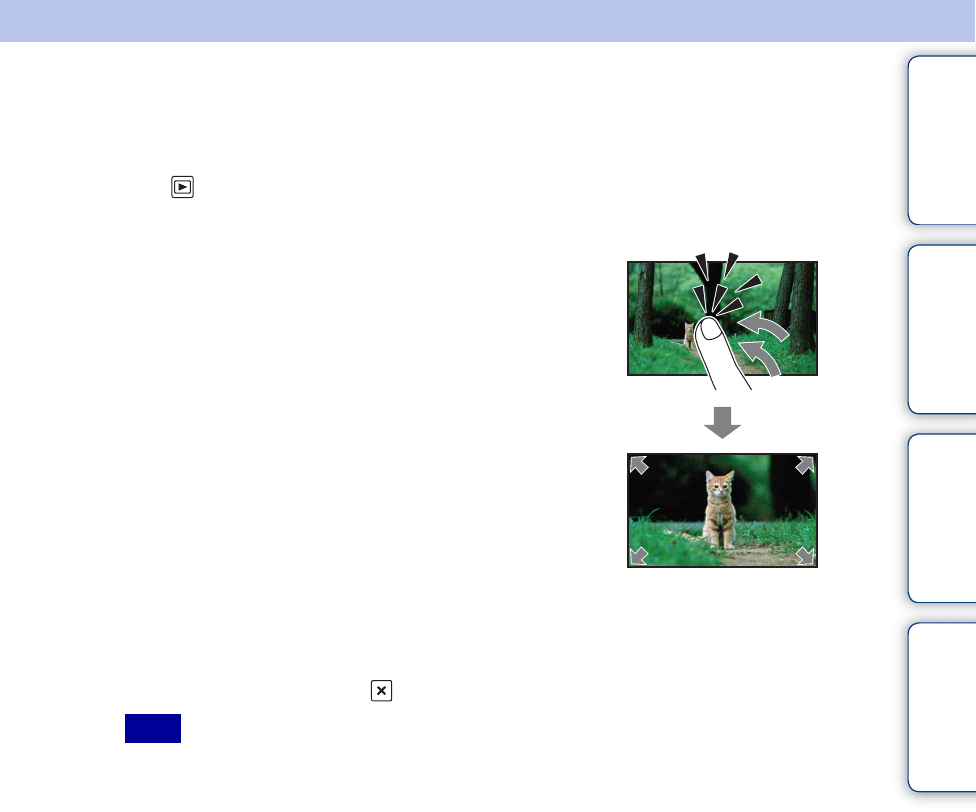
40US
Table of
contents
Operation
Search
Settings
Search Index
Playback zoom
Enlarges the played back still images.
1Tap (Playback) to switch to playback mode.
2Select the still image and tap.
3Double-tap the part you want to enlarge.
4Adjust the magnification and the part to
enlarge.
Each double-tap on the LCD screen enlarges the image up to 8 times its original size.
Drag the image to change the part to enlarge.
To cancel playback zoom, tap .
• You cannot operate playback zoom when an HDMI cable (sold separately) is connected.
Note
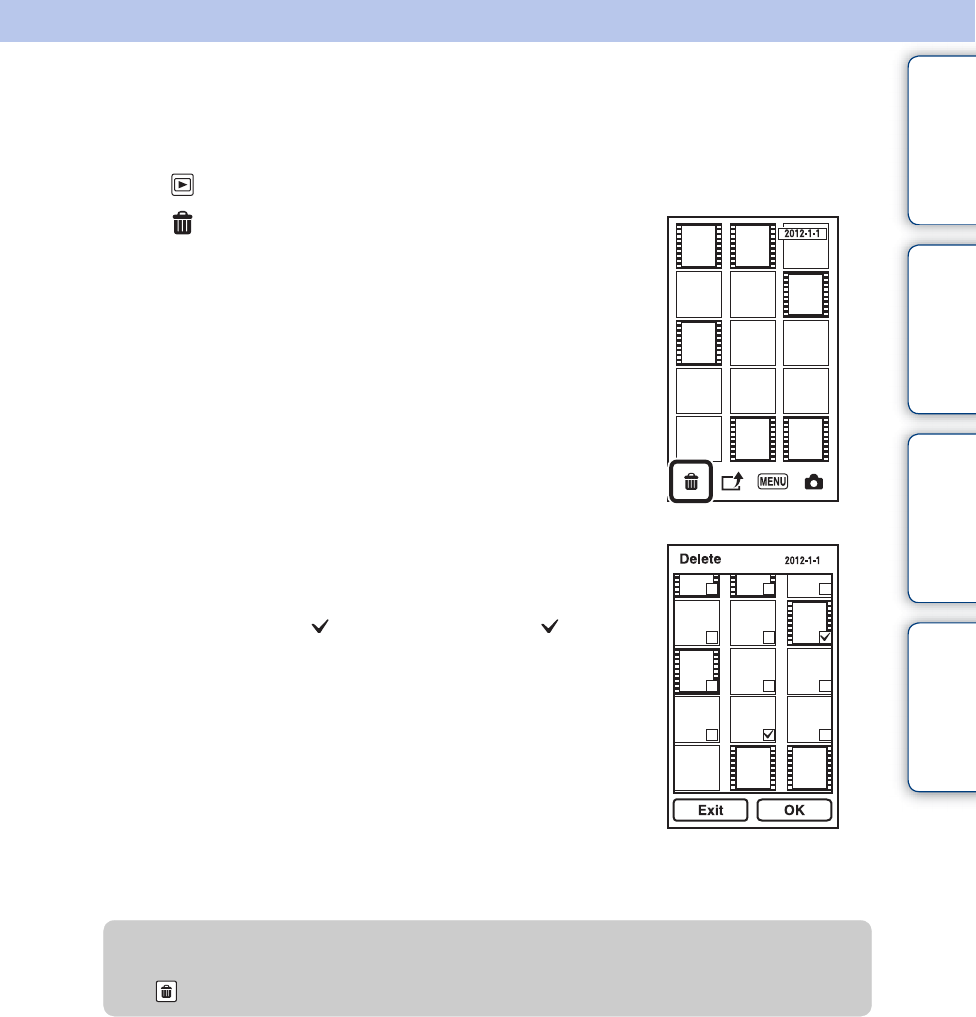
41US
Table of
contents
Operation
Search
Settings
Search Index
Delete
Allows you to select unwanted images for deletion.
1Tap (Playback) to switch to playback mode.
2Tap (Delete) on the index screen.
3Tap images you want to delete.
Repeat the above step until there are no more images to be
deleted.
Select an image with a mark again to release the mark.
4Tap [OK] t [OK].
zTo delete images during playback
Tap (Delete) t [OK] in single-image mode.
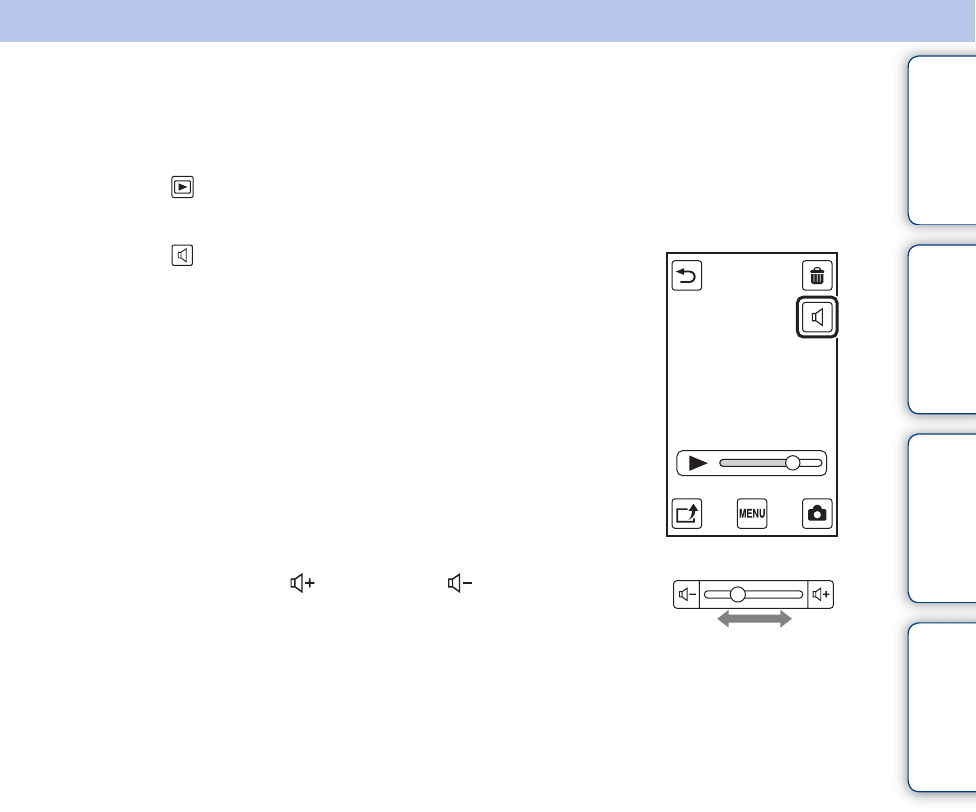
42US
Table of
contents
Operation
Search
Settings
Search Index
Volume control
You can adjust the volume for playback movies.
1Tap (Playback) to switch to playback mode.
2Select a movie and tap.
3Tap (Volume control).
Tap the LCD screen when the screen display is not shown.
4Touch and hold to increase, to decrease
the volume. Lower Louder
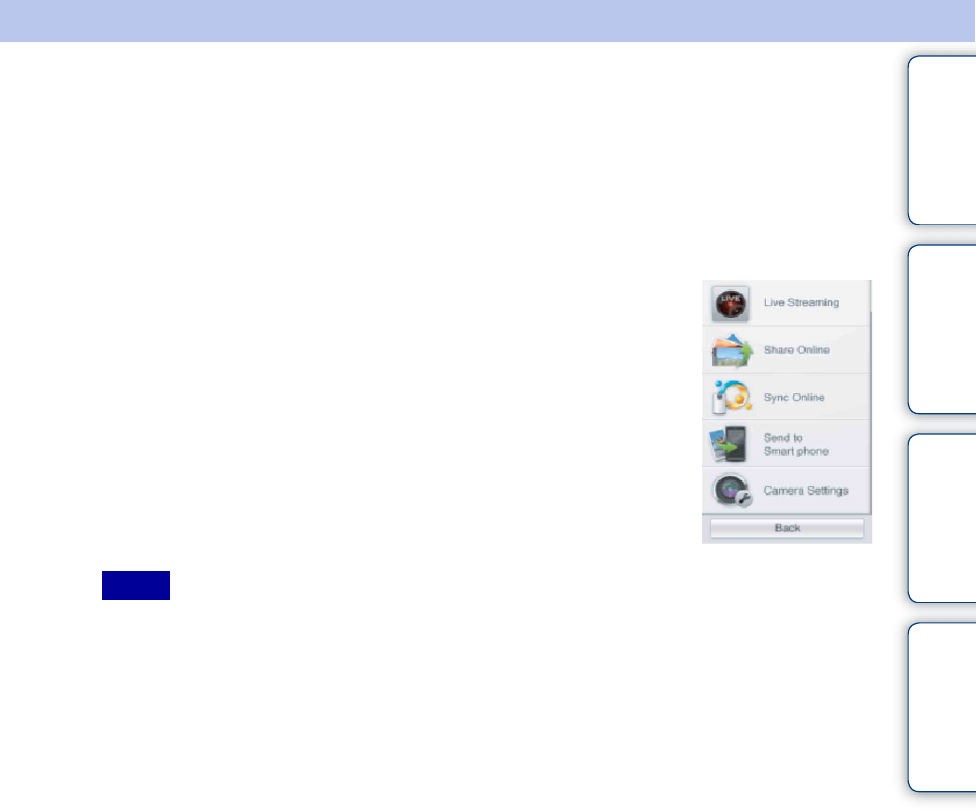
43US
Table of
contents
Operation
Search
Settings
Search Index
What you can do with Wi-Fi
Wi-Fi allows you to connect to the network service via a LAN environment, either in or outside
the home.
Before you connect, you first need to register your access point.
You can use Wi-Fi from the menu screen, which is opened by tapping the MENU button.
Depending on the region, menu contents may differ.
The following functions are available from the MENU button.
– Live Streaming (page 46)
– Share (page 47)
– Save to PlayMemories online service (page 48)
– Send to Smartphone (page 49)
• Since a wireless LAN exchanges information by radio waves, LAN connection can be anywhere within a
given coverage area. Be aware of the risks of hacking by a vicious third party. It is recommended to
secure your wireless LAN environment, and its use is left to your discretion.
• It is not possible to connect to the Internet using Wi-Fi of this camera.
• Wi-Fi transferred image size:
– Movie: 480 × 270 30p
– Photo: 1920 × 1080 16:9/1440 × 1080 4:3 or smaller
Notes
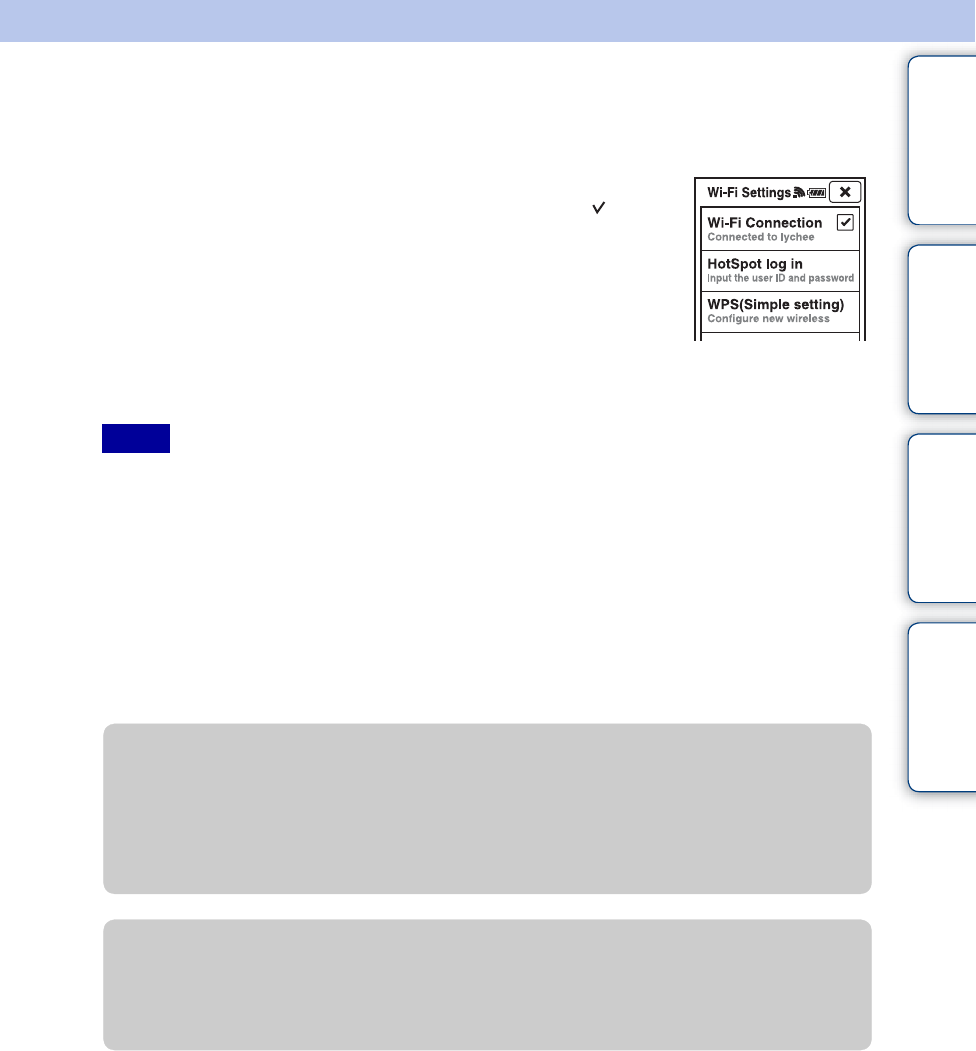
44US
Table of
contents
Operation
Search
Settings
Search Index
Setting Wi-Fi
1Press the ON/OFF (Power) button.
2Tap [MENU] t [Main Settings] t [Wi-Fi
Settings], and [Wi-Fi Connection] to show the
mark.
3Select an access point to connect.
4Enter the password.
• Network device connections and setting methods differ according to the device.
• The following are needed to connect the camera to a network:
– An Internet service provider (ISP) contract
– ADSL modem or other network device
– Access point or wireless router
– Access point setting information (SSID)
• If you do not know the settings to make, be sure to check with the person who set up the access point,
administrator, or with your service provider.
• When connected to a network, if you do not operate the camera for about xx minutes, the camera may
disconnect from the network automatically to save battery power. In these cases establish the connection
again.
Notes
zWhen using a hotspot (public Wireless LAN access
point)
When you use Wi-Fi to connect to a hotspot at a hotel or airport, tap [MENU] t [Wi-Fi
Settings] t [Hotspot Login], and perform the authentication procedure.
zWhen using a WPS-capable access point
Tap [MENU] t [Wi-Fi Settings] t [WPS].
For details, refer to the instruction manual of the access point.
Continued r
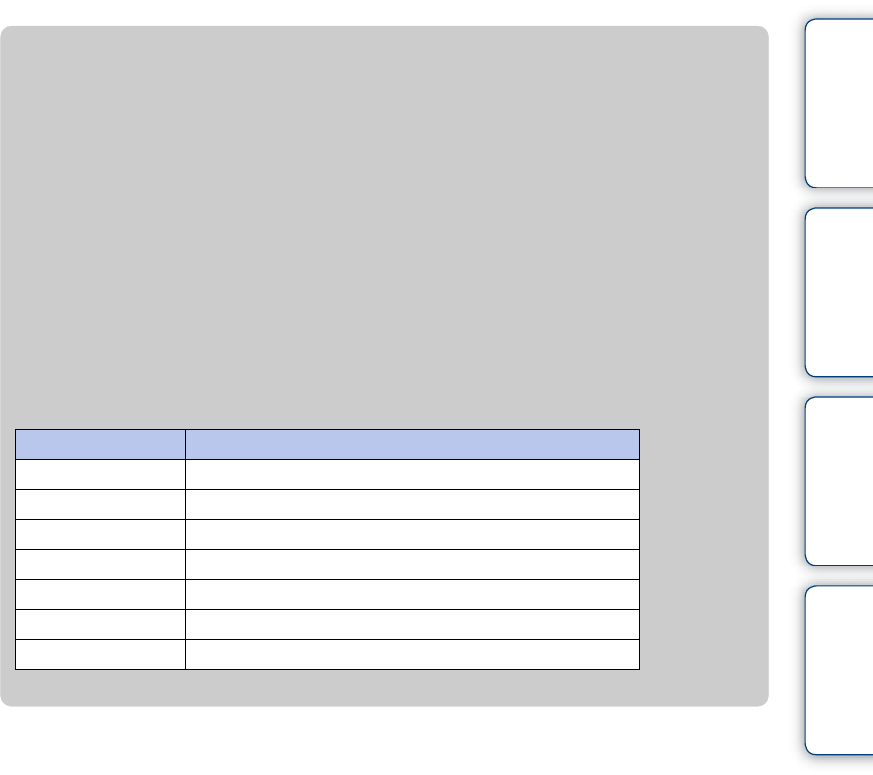
45US
Table of
contents
Operation
Search
Settings
Search Index
zHow to use the keyboard
Touching the text field brings the keyboard up. Enter your text, then touch @.
• The number of characters you can input is limited.
Button Function
@Finish character input
@Hide the keyboard
@Display the keyboard
@Shift key
@Delete the character to the left of the cursor
@Enter key
@Space key
Text field Character input key Suggested word
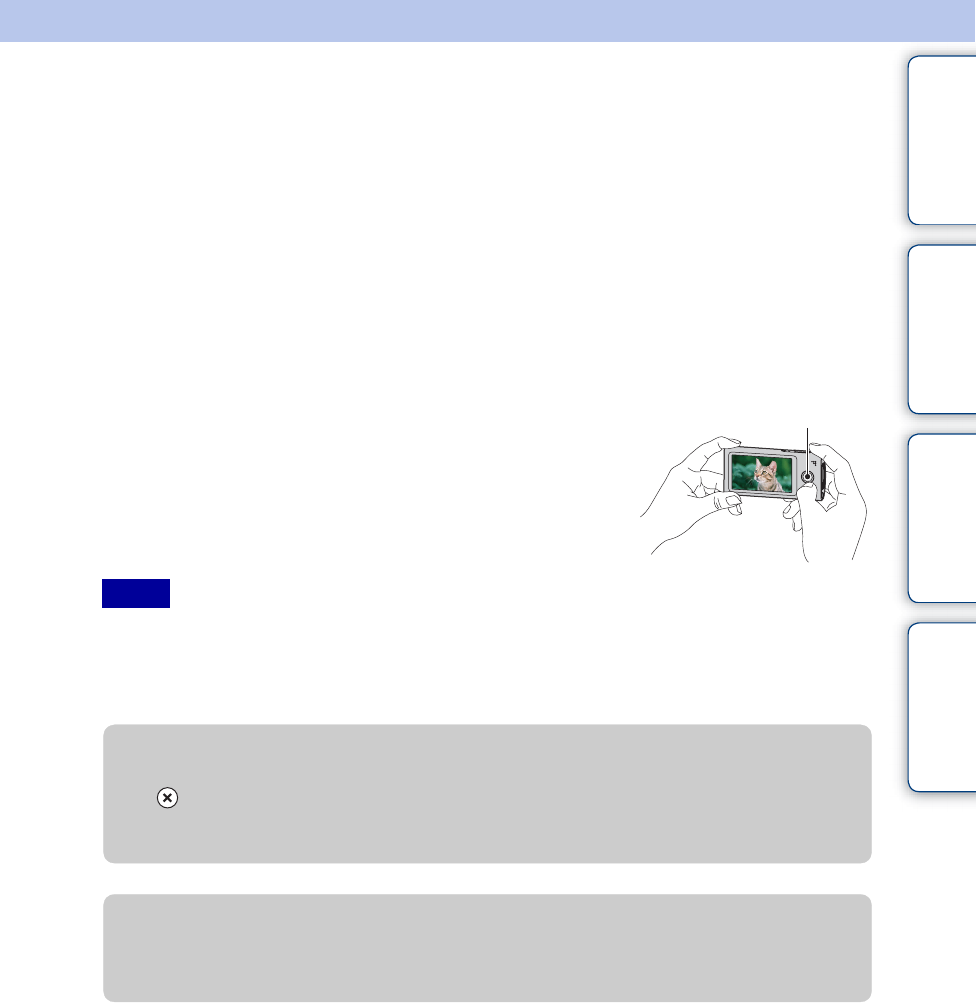
46US
Table of
contents
Operation
Search
Settings
Search Index
Live Broadcast (Live Streaming)
You can send images you are taking to family and friends in real time.
Registration with the live streaming service is required in advance.
1Press the ON/OFF (Power) button.
2Register with a live streaming service for this purpose.
• For details, see http://www.sony.net/xxx.
3Tap [MENU] t [Live Streaming].
4Establish the Wi-Fi connection.
5Enter [Username] and [Password] on the login screen, then tap [OK].
6Press the movie button.
To finish live streaming, press the movie button again.
• You can enter image titles using the keyboard.
• You cannot shoot still images during live streaming.
• Depending on the region, live streaming may not be possible.
• To enable the Live Streaming function, you first need to establish your own service account. You will
also need to set up real-time distribution from the web site.
Notes
Movie button
zTo delete an image currently being uploaded
Tap on the REC review screen, then tap [OK].
• Images are deleted from the live streaming service, but remain in the internal memory of the
camera.
zHow to use Wi-Fi
For details on how to register and using live streaming, see http://www.xxxxxxxxx.
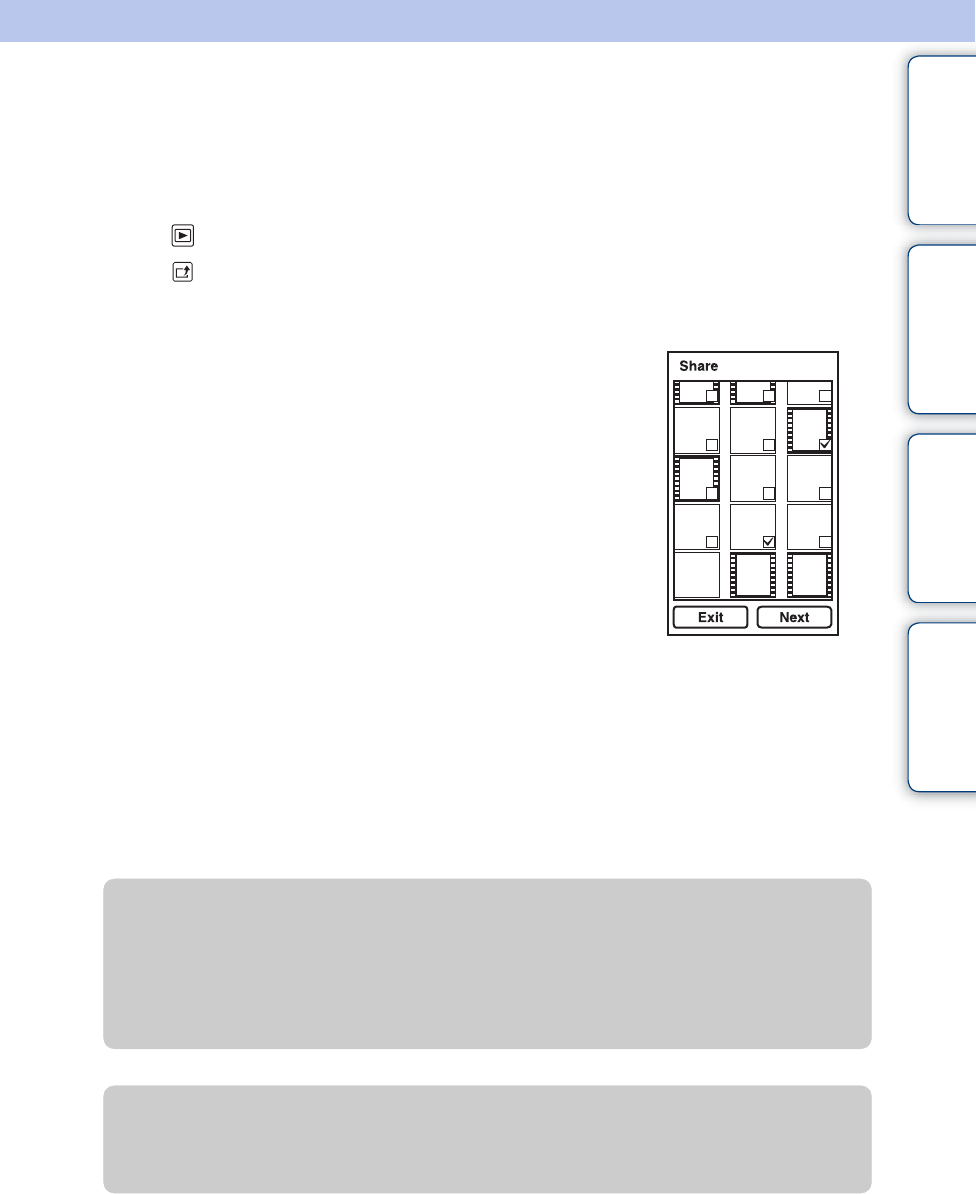
47US
Table of
contents
Operation
Search
Settings
Search Index
Uploading images directly
(Share)
You can upload images to your favorite sharing site soon after recording.
1Tap (Playback) to switch to playback mode.
2Tap (Share) on the index screen.
• You can also share images from the single-image mode.
• You can also share images by tapping the share button on the screen displayed when shooting ends.
3Tap images you want to upload, then tap [Next].
4Select the sharing site to upload from the share
list, then tap [OK].
Wi-Fi connection is automatically established.
To return to the index screen, tap [Next].
• All the images you selected can be uploaded together to the sharing site later.
5Tap [Login] at each service. Enter [Username] and [Password] after the
Wi-Fi connection, and tap [OK] t [Upload].
zWhat you can do with Share
• Images that you stopped uploading can be uploaded later together by tapping [MENU] t [Post and
Share], or by the application software.
• You can select the upload destination from the application software.
• Depending on the region or country, available services may differ.
zHow to use Wi-Fi
For details, see www.sony.net/startBloggiexxxxx.
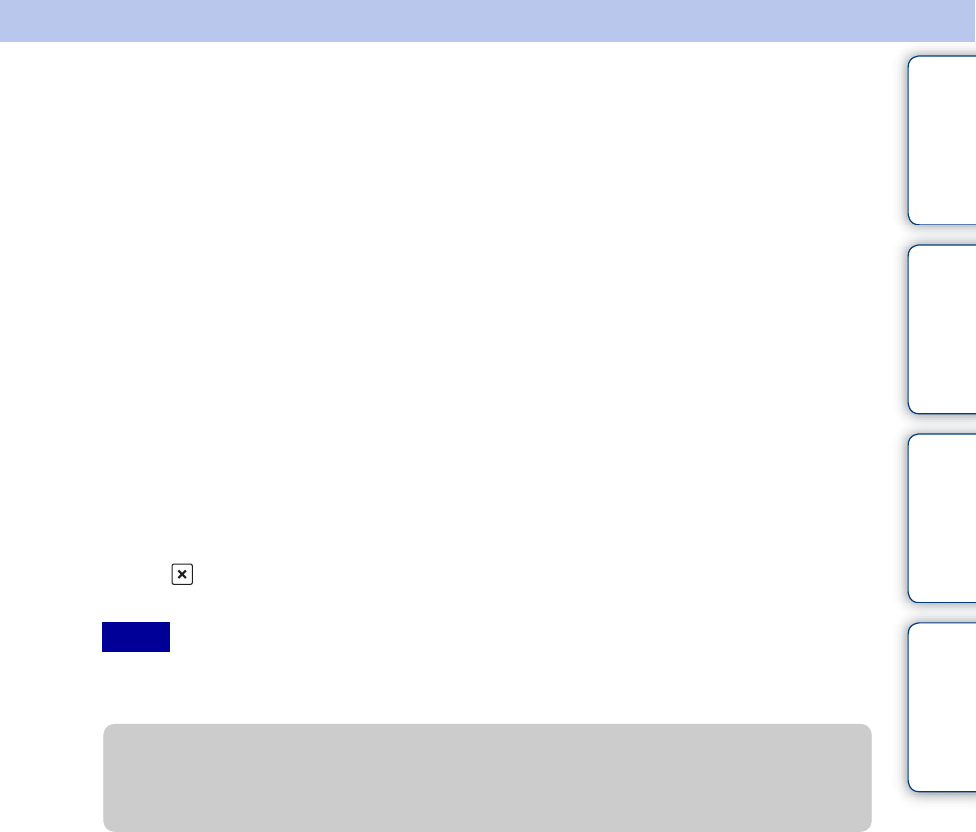
48US
Table of
contents
Operation
Search
Settings
Search Index
Uploading images to Personal
Space (Save to PlayMemories
online service)
You can save all images recorded on the camera to Personal Space. By uploading images to
Personal Space, you can also enjoy recorded images by accessing your contents from an Internet
device, such as a computer, smartphone, tablet computer, or Bravia, anywhere and anytime. A
Personal Space account is required in advance.
1Tap [MENU] t [Save to PlayMemories online service].
2Establish the Wi-Fi connection.
3Enter [Username] and [Password] on the login screen, then tap [OK].
4Tap [Sync-Up].
Uploading starts.
Only images which have not been uploaded from the camera are uploaded.
The screen returns to the [Sync-Up] screen when uploading has finished.
5Tap .
• Depending on the region, Personal Space may not be available.
• To use Personal Space, you need to establish your own account.
Notes
zHow to use Wi-Fi
For details, see www.sony.net/startBloggiexxxxx.
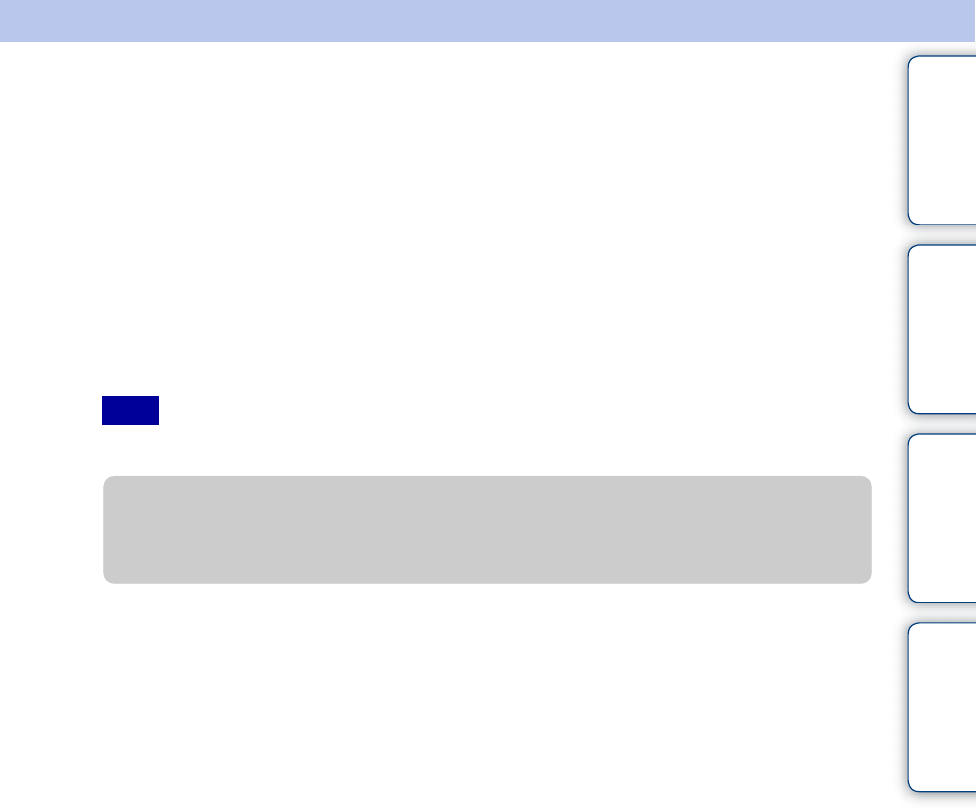
49US
Table of
contents
Operation
Search
Settings
Search Index
Copying data to a smartphone
You can copy recorded images to a smartphone or tablet computer. Installing a suitable
application (PlayMemories Mobile) for this purpose to the smartphone or tablet computer is
required in advance.
1Tap [MENU] t [Send to Smartphone].
2Tap [Connection information] and perform Wi-Fi setting on the
smartphone, using the [SSID] and the [Password] shown.
3Select and transfer the camera contents using the installed application on
the smartphone.
• Depending on their size, certain images transferred to a smartphone may not be playable.
Note
zHow to use Wi-Fi
For details, see www.sony.net/startBloggiexxxxx.
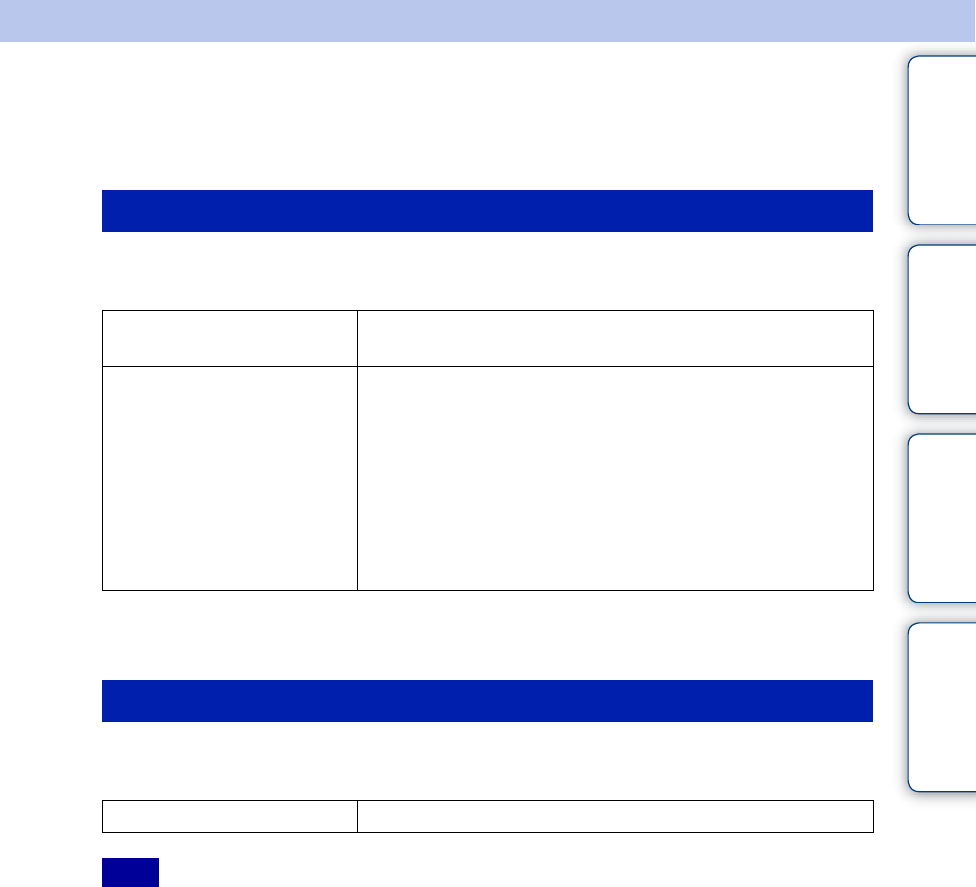
50US
Table of
contents
Operation
Search
Settings
Search Index
Recommended computer
environment
The following computer environment is recommended when using “PlayMemories Home”, and
importing images via a USB connection.
* 64-bit editions are not supported. When creating discs by the installed “Extension”, Windows Image
Mastering API (IMAPI) Ver. 2.0 or later is required.
The following computer environment is recommended when using “PlayMemories Home” or
importing images via a USB connection.
• Use the software “iMovie” bundled on Mac for operations such as importing AVCHD movies.
Windows
OS (pre-installed) Microsoft Windows XP* SP3/Windows Vista SP2/Windows 7
SP1
Others CPU: Intel Pentium III 800 MHz or faster (For playing/editing
the High Definition movies: Intel Core Duo 1.66 GHz or
faster/Intel Core 2 Duo 1.66 GHz or faster/Intel Core 2 Duo
2.26 GHz or faster (AVCHD (FX/FH))
Memory: 512 MB or more (For playing/editing the High
Definition movies: 1 GB or more)
Hard Disk: Disk space required for installation:
approximately 500 MB
Display: 1,024 × 768 dots or more
Mac
OS (pre-installed) USB Connection: Mac OS X (v10.3 to v10.7)
Note

51US
Table of
contents
Operation
Search
Settings
Search Index
To play back and edit movie files (MPEG-4 AVC/H.264) recorded by the camera on your
computer, you need to install the software compatible with MPEG-4 AVC/H.264 or the
PlayMemories Home.
• Even in a PC environment where operations are guaranteed, images may not play back smoothly due to
dropped frames, etc. Note that the imported image itself is not affected.
• If you are using a notebook PC, be sure to use the PC with the AC adaptor plugged in. Sometimes normal
operations are not possible due to the power savings function of the PC.
• Operations are not guaranteed, even on computers fulfilling the above system requirements. For example,
other open or background applications currently running may limit product performance.
Note on playback of movie files (MPEG-4 AVC/
H.264)
Note

52US
Table of
contents
Operation
Search
Settings
Search Index
Uploading images to a network
service
1Select images and the sharing site to upload with the camera in advance
(page 47).
2Connect the camera to a computer in which the PlayMemories Home
(pre-loaded on the internal memory) is already installed.
PlayMemories Home starts automatically and the confirmation screen for uploading images
appears.
• Set [LUN Settings(USB)] to [Multi].
• When uploading images over the Internet, the cache may remain in the computer being used depending
on the service provider. This is also true when the camera is used for this purpose.
In order to use PlayMemories Home to enjoy the benefits of the image uploading service or other
services (the “services”) provided by these and other websites, you must consent to the
following.
• Some websites require registration procedures and/or fees to use their services. In using such services,
you must comply with the terms and conditions established by the websites concerned.
• Services may be terminated or changed in accordance with the convenience of the website operators.
Sony will not be held responsible for any trouble occurring between the users and third parties or any
inconvenience caused to users relating to the utilization of the services inclusive of the termination of or
changes to such services.
• To view a website, you will be redirected to it by the Sony server. There may be times when you cannot
access the website because of server maintenance or for other reasons.
• If the operation of the Sony server is to be terminated, you will be notified of the termination ahead of
time on Sony’s website, etc.
• The URLs to which you are redirected by the Sony server and other information may be recorded for the
purposes of improving Sony’s future products and services. However, no personal data will be recorded
on such occasions.
Notes
Notes on PlayMemories Home (pre-loaded on the
internal memory)
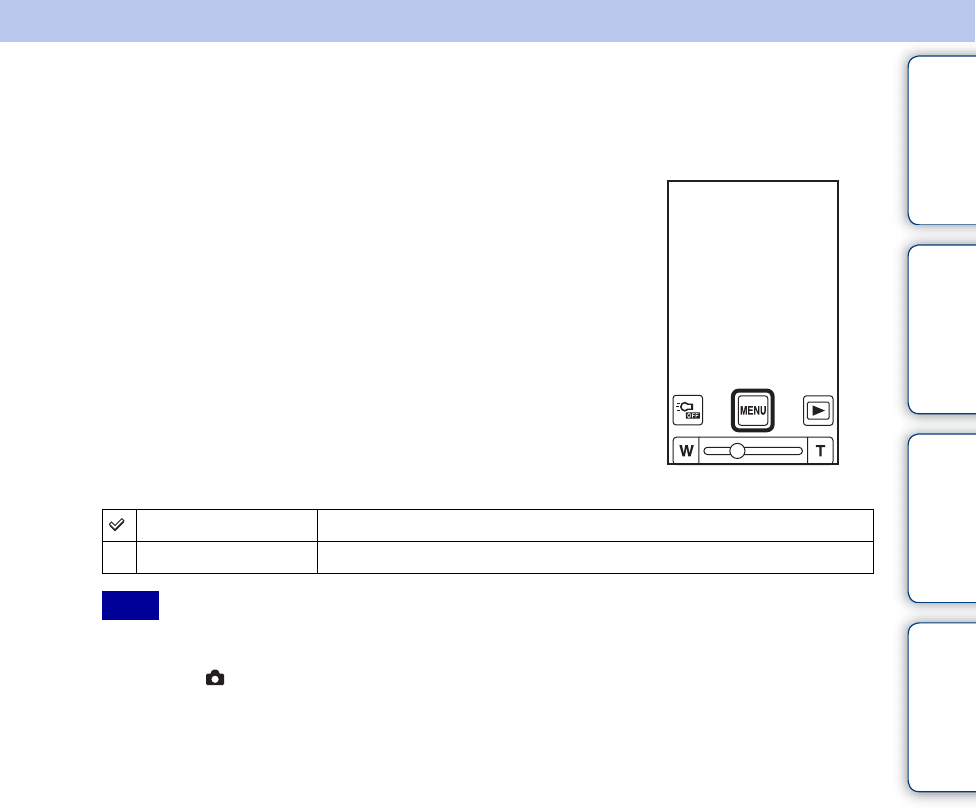
54US
Table of
contents
Operation
Search
Settings
Search Index
Demo Mode
Performs a demonstration of the camera.
1Tap [MENU] t [Main Settings] t [Demo Mode]
t desired mode.
• The demonstration stops when operating any of the following.
– Touch LCD screen.
– Press the (Shutter) button or movie button.
– Turn off the power.
On Performs a demonstration.
Off Does not perform a demonstration.
Note
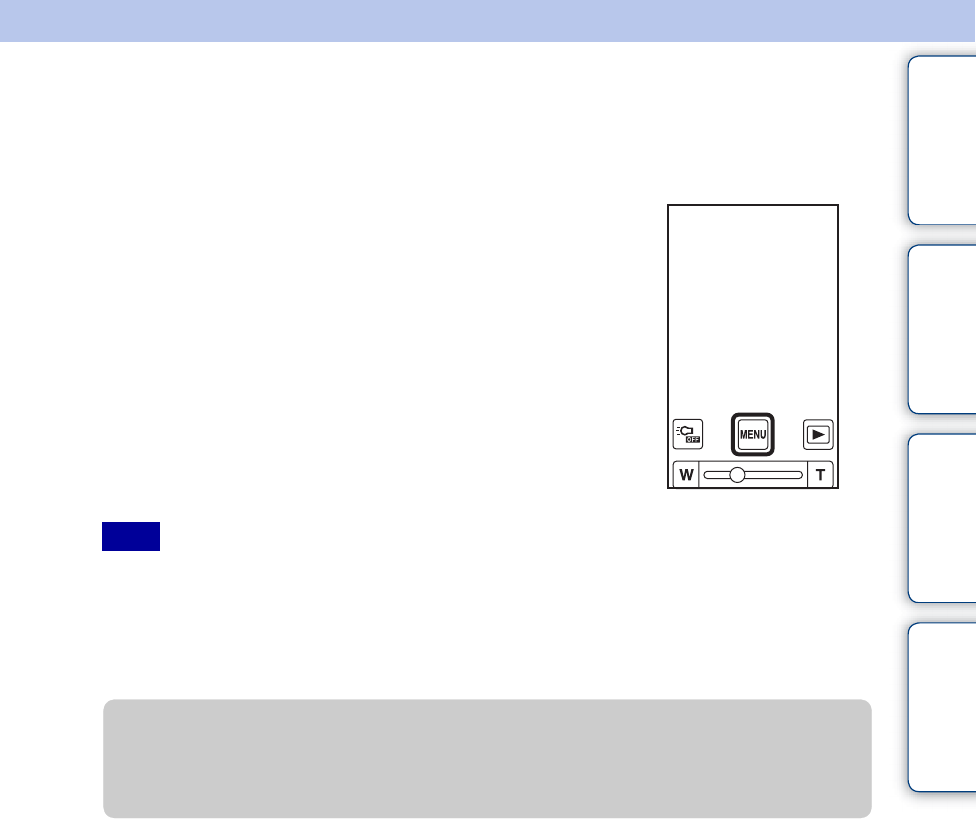
55US
Table of
contents
Operation
Search
Settings
Search Index
Initialize
Initializes the setting to the default setting.
Even if you execute this function, the images are retained.
1Tap [MENU] t [Main Settings] t [Initialize] t
[OK].
• Perform initialization after charging the camera to prevent the camera from turning off during the
process.
• The following Wi-Fi connection settings are also initialized:
– Login information for each network service
– Wi-Fi access point information
Note
zWhen the camera does not work properly
Press and hold the ON/OFF (Power) button for at least 7 seconds, and force-quit the camera
(page 13). Then turn the camera on again.
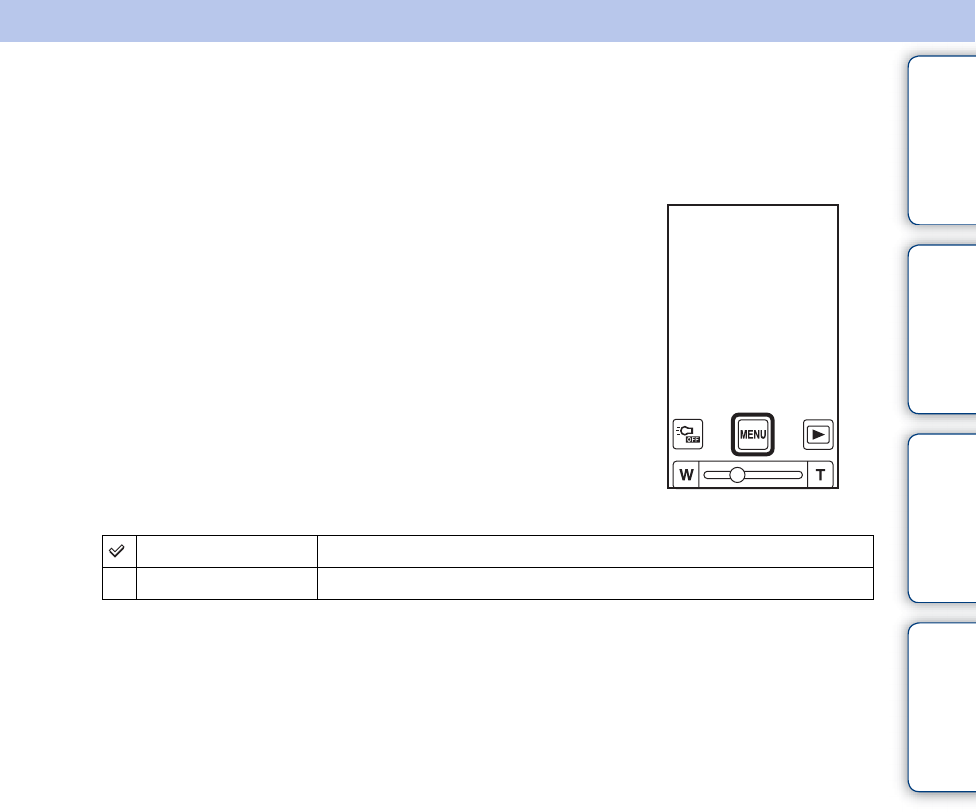
56US
Table of
contents
Operation
Search
Settings
Search Index
HDMI Output
Selects the type of signal to be output to a TV from the HDMI OUT jack. If images are not
displayed on the TV clearly, changing the setting may improve the display.
1Tap [MENU] t [Main Settings] t [HDMI
Output] t desired mode.
60Hz Outputs with 60Hz.
50Hz Outputs with 50Hz.
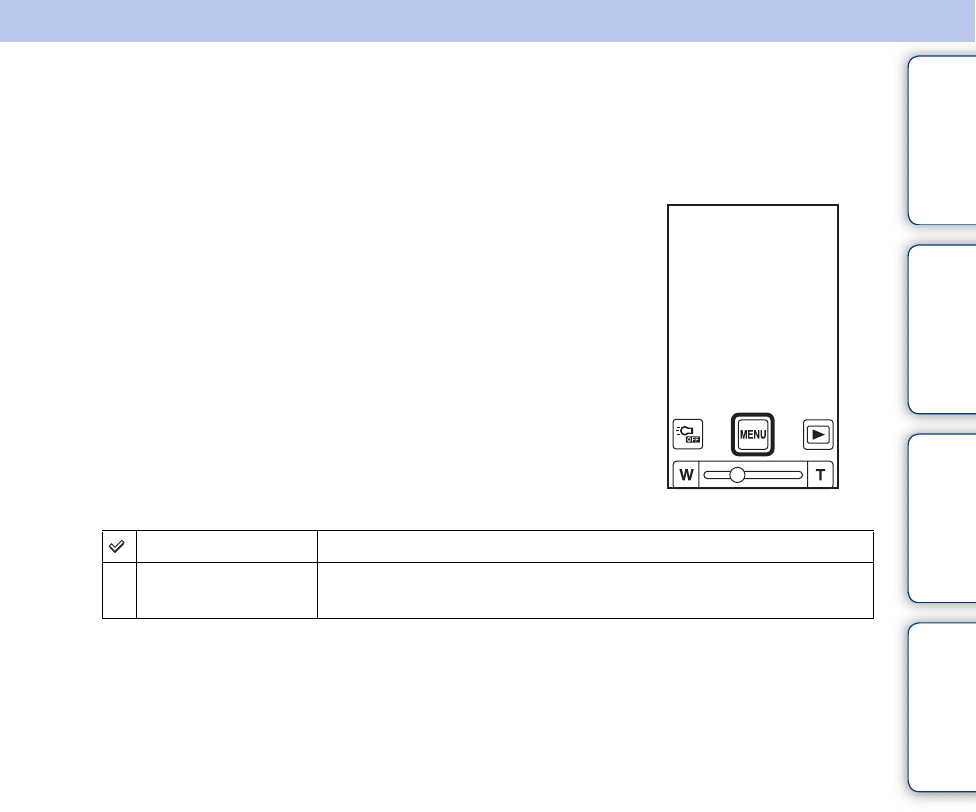
57US
Table of
contents
Operation
Search
Settings
Search Index
LUN Settings(USB)
Sets the display method for the recording media displayed on a computer screen or other monitor
when the camera is connected with a computer or AV component using a USB connection.
1Tap [MENU] t [Main Settings] t [LUN
Settings(USB)] t desired mode.
Multi Select this setting when you connect the camera to a computer.
Single Select this setting in cases where the images are not displayed when
the camera is connected to a device other than a computer.
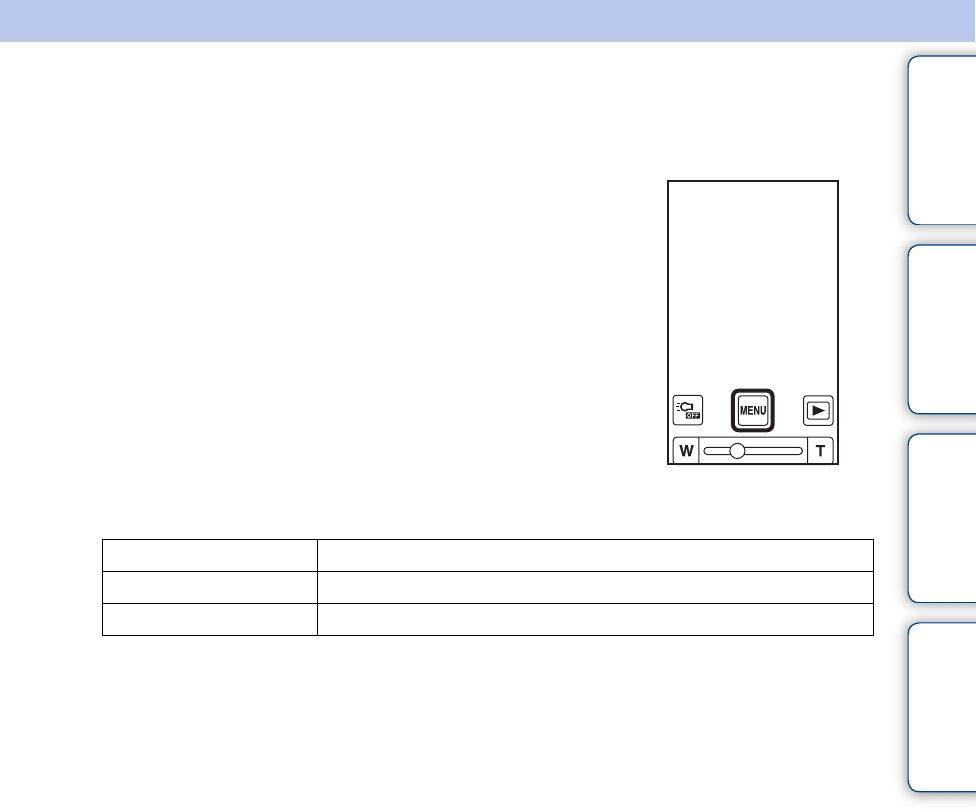
59US
Table of
contents
Operation
Search
Settings
Search Index
Date & Time Setting
Sets the date and time again.
1Tap [MENU] t [Main Settings] t [Date & Time
Setting].
2Tap the items you want to set.
Date & Time Format Selects the date and time display format.
Daylight Savings Pushes forward an hour.
Date & Time Sets the date and time (page 25).
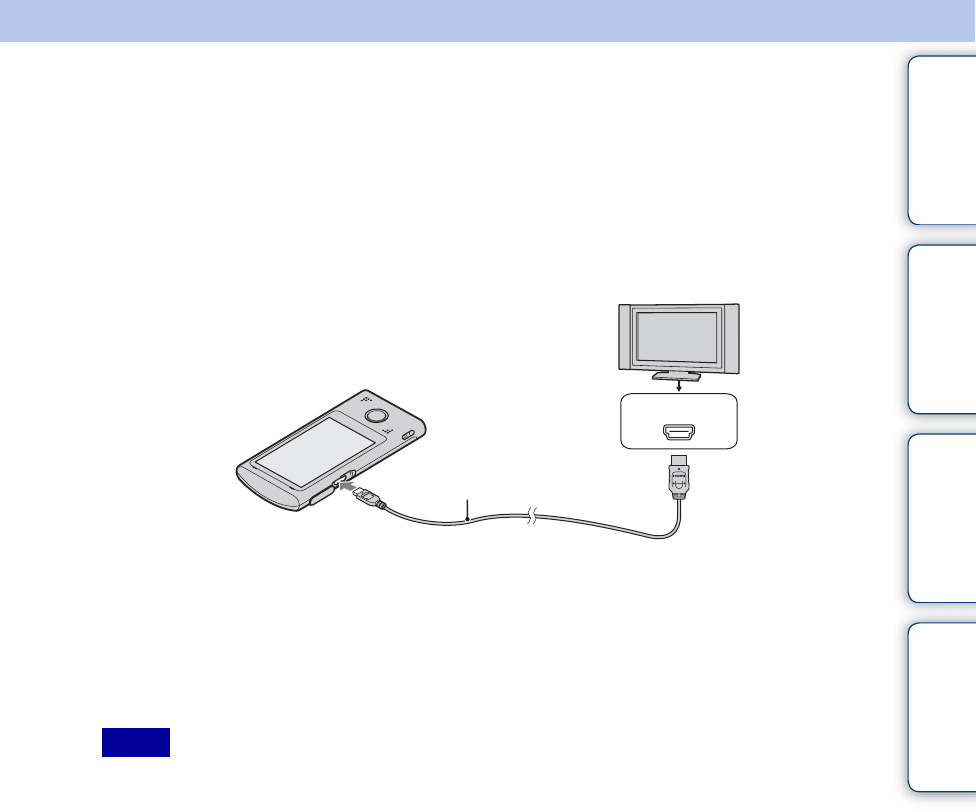
60US
Table of
contents
Operation
Search
Settings
Search Index
Viewing images on a TV
Connect the camera to a TV which has an HDMI terminal with an HDMI cable (sold separately).
Refer also to the instruction manuals of the TV.
1Turn off both the camera and the TV.
2Open the jack cover and connect the camera to the TV with the HDMI
cable (sold separately).
3Turn on the camera.
4Turn on the TV and set the input.
Images shot with the camera appear on the TV.
5Tap images to play back.
• Connect the mini-HDMI jack of the HDMI cable (sold separately) to the HDMI OUT jack of the camera.
• Do not connect the output terminal of the camera to that of other devices. This may result in malfunction.
• Some devices may not work properly. Image and sound may not be output.
• Use an HDMI cable with the HDMI logo.
Notes
1 To HDMI
terminal
HDMI cable
2 To HDMI OUT jack
HDMI terminal

61US
Table of
contents
Operation
Search
Settings
Search Index
If you want to view images on a TV screen, you need a TV with an HDMI terminal and an
HDMI cable (sold separately). The color system of the TV must match that of the camera. Check
the following lists for the TV color system of the country or region where the camera is used, and
set [HDMI Output] (page 56).
NTSC system
Bahama Islands, Bolivia, Canada, Central America, Chile, Colombia, Ecuador, Jamaica, Japan,
Korea, Mexico, Peru, Surinam, Taiwan, the Philippines, the U.S.A., Venezuela, etc.
PAL system
Australia, Austria, Belgium, China, Croatia, Czech Republic, Denmark, Finland, Germany,
Holland, Hong Kong, Hungary, Indonesia, Italy, Kuwait, Malaysia, New Zealand, Norway,
Poland, Portugal, Rumania, Singapore, Slovak Republic, Spain, Sweden, Switzerland, Thailand,
Turkey, United Kingdom, Viet Nam, etc.
PAL-M system
Brazil
PAL-N system
Argentina, Paraguay, Uruguay
SECAM system
Bulgaria, France, Greece, Guiana, Iran, Iraq, Monaco, Russia, Ukraine, etc.
On TV color systems
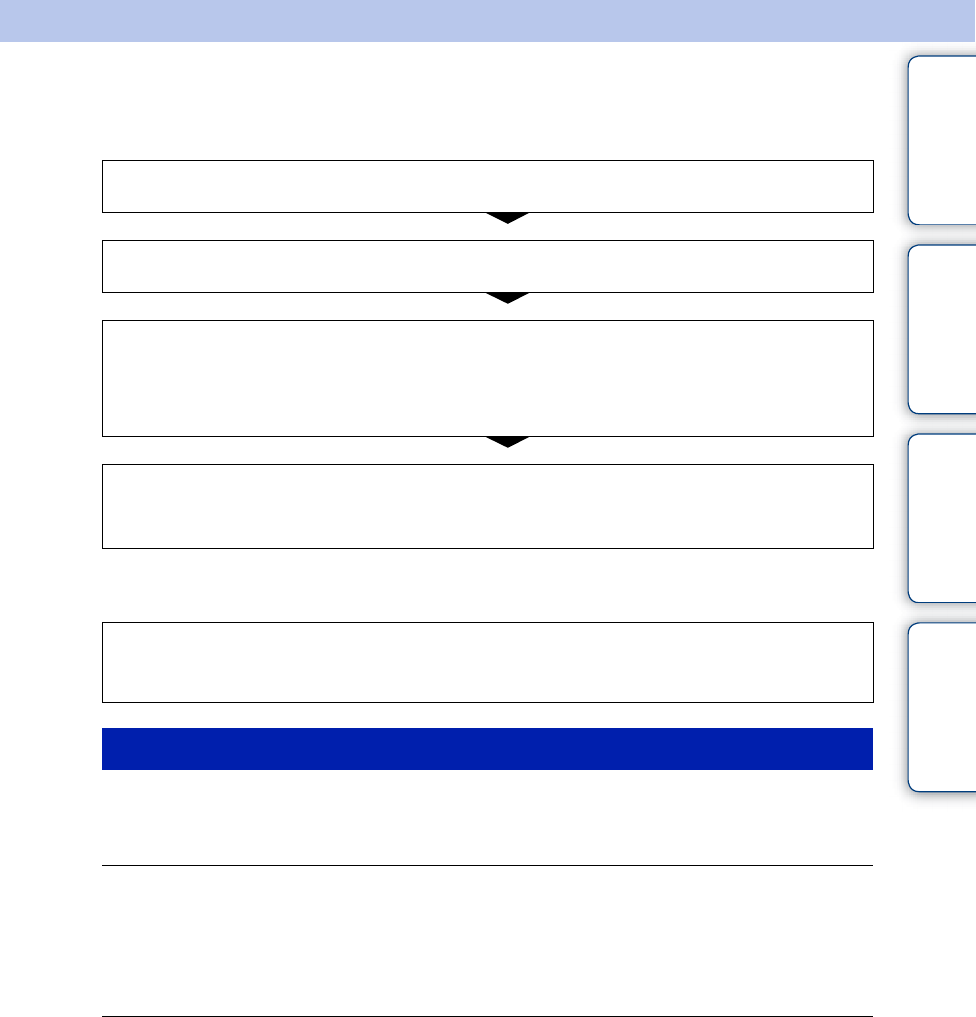
62US
Table of
contents
Operation
Search
Settings
Search Index
Troubleshooting
If you experience trouble with the camera, try the following solutions.
Be aware that by sending the camera for repair, you give consent that the contents of the internal
memory, music files may be checked.
Cannot turn on the camera.
• The battery pack is discharged. Charge the camera.
The power turns off suddenly.
• Depending on the camera and battery temperature, the power may turn off automatically to protect
the camera. In this case, a message is displayed on the LCD screen before the power turns off.
• If you do not operate the camera for a certain period of time while the power is on, the camera turns
off automatically to prevent wearing down the battery pack. Turn the camera on again.
Battery life is short.
• Charge the battery until the charge lamp disappears.
• You are using the camera in an extremely hot or cold location, or the charging is insufficient. This is
not a malfunction.
• If you have not used the camera for a prolonged period, the efficiency of the battery will be improved
by repeatedly charging and discharging it.
• When usable battery life becomes half the usual time, even after charging the battery fully, the battery
may need to be replaced. Consult your nearest Sony dealer.
1Check the items on pages 62 to 68.
2Turn the power off and then on again.
3Press and hold the ON/OFF (Power) button for at least 7
seconds, and force-quit the camera. Then turn the camera on
again (page 13).
4Consult your Sony dealer or local authorized Sony service
facility.
Additional information on this product and answers to frequently asked questions can
be found at our Customer Support Website.
http://www.sony.net/
Battery pack and power
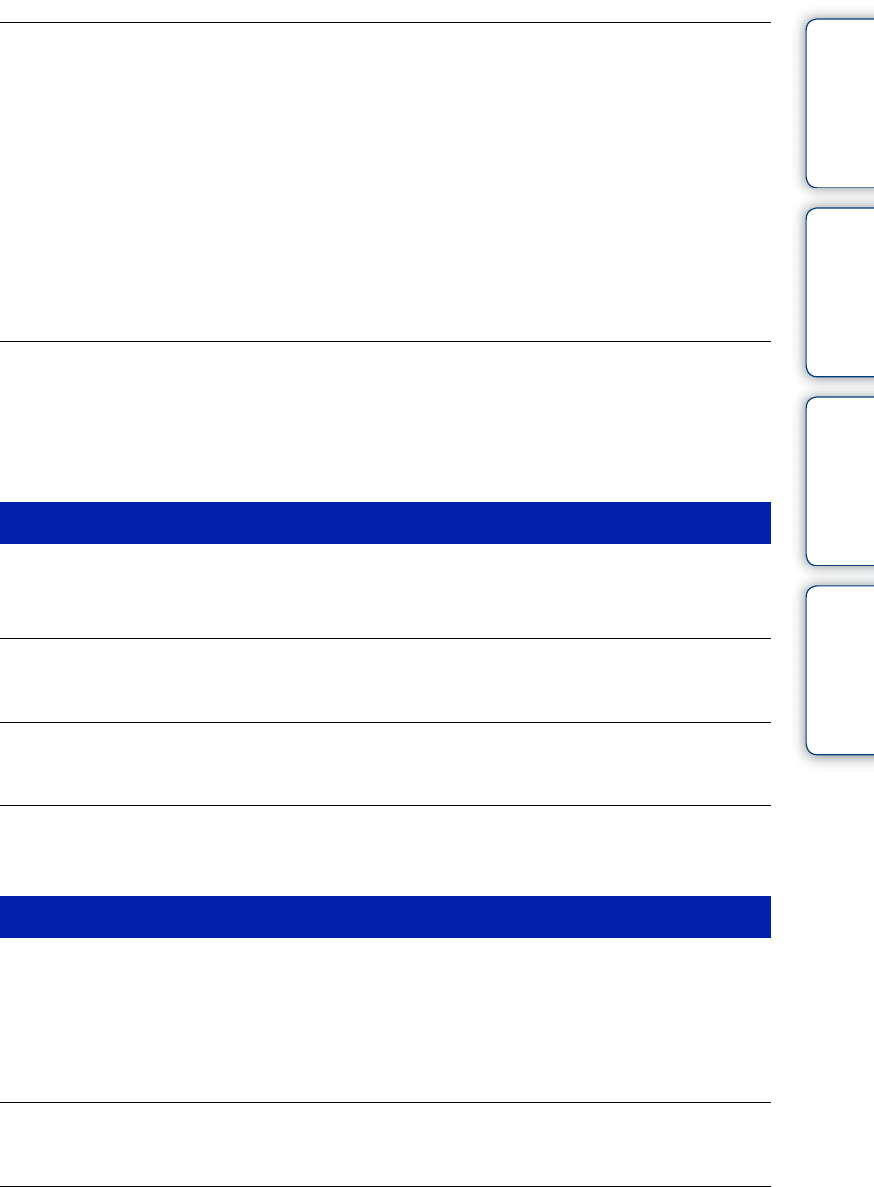
63US
Table of
contents
Operation
Search
Settings
Search Index
Cannot charge the camera.
• Turn off the camera and make the USB connection.
• Disconnect the USB connection support cable, and then reconnect it.
• Use the USB connection support cable (supplied).
• Charge the battery in an ambient temperature of 10°C to 30°C (50°F to 86°F).
• Turn on the computer and connect the camera.
• Release the computer from sleep or hibernation status.
• Connect the camera directly to a computer using the supplied USB connection support cable.
• Connect the camera to a computer with the operating system that is supported by the camera.
• After trying the remedies above, if the problem still persists, press and hold the ON/OFF (Power)
button for at least 7 seconds, and force-quit the camera. Then reconnect it to the computer using the
supplied USB connection support cable.
The remaining charge indicator is incorrect.
• This phenomenon occurs when you use the camera in an extremely hot or cold location.
• A discrepancy arose between the remaining charge indicator and the actual remaining battery charge.
Fully discharge the battery pack once, then charge it to correct the indication.
• The battery pack is dead (page 70). Consult your nearest Sony dealer.
Cannot record images.
• Check the free capacity of the internal memory. If it is full, delete unnecessary images (page 41).
The date and time are not displayed on the LCD screen.
• While shooting, the date and time are not displayed. They are displayed only during playback.
Cannot insert dates on images.
• The camera does not have a feature for superimposing dates on images.
Dots appear and remain on the screen.
• This is not a malfunction. These dots are not recorded.
Cannot play back images.
• The folder/file name has been changed on your computer.
• Playback on the camera cannot be guaranteed if files contain images processed on a computer, or
images shot by another camera.
• The camera is in USB mode. Delete the USB connection (page 22).
The image appears rough right after playback starts.
• This may happen due to image processing. This is not a malfunction.
The image does not appear on the TV.
• Set [HDMI Output] to [60Hz] in NTSC region, [50Hz] in PAL region (page 56).
• Check whether the connection is correct (page 60).
Shooting still images/movies
Viewing images
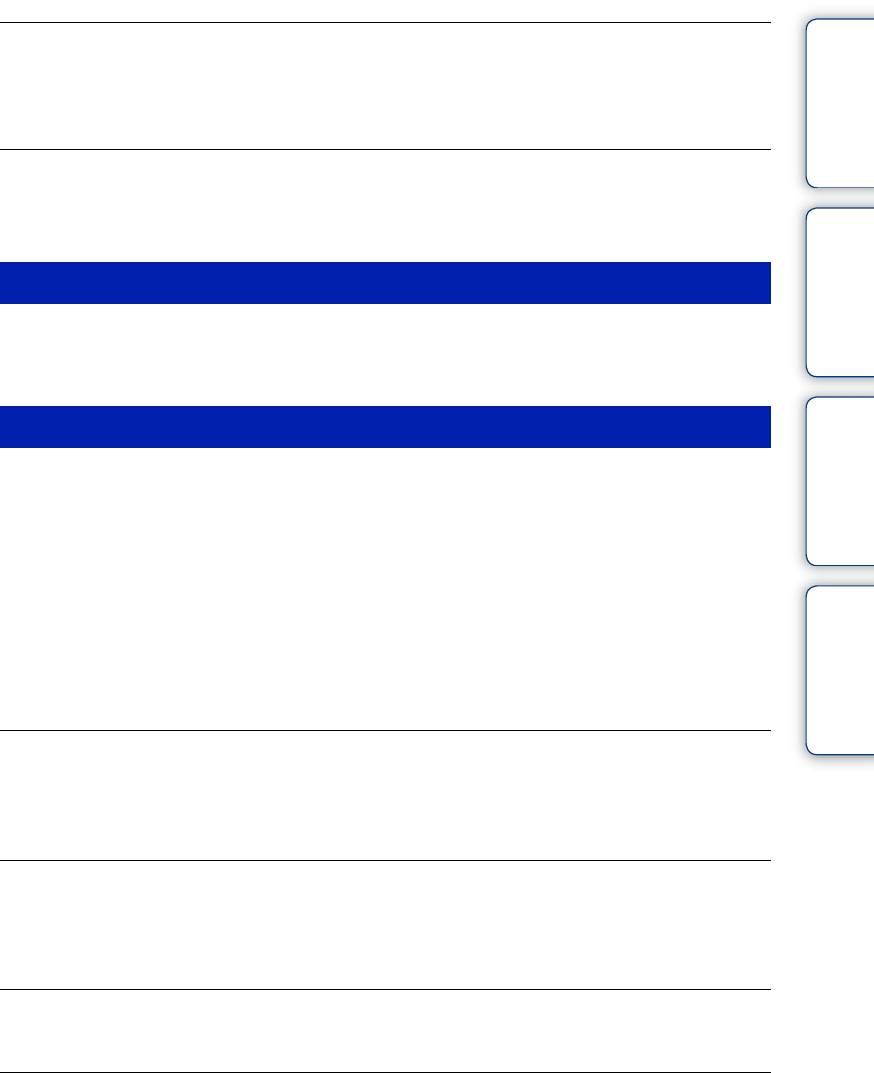
64US
Table of
contents
Operation
Search
Settings
Search Index
The top and bottom edges of images are trimmed slightly on a connected TV.
• The LCD screen of the camera can display recording images across the entire screen (full pixel
display). However, this may cause slight trimming of the top, bottom, right, and left edges of images
when played back on a TV that is not compatible with full pixel display.
Black bands appear on the left and right of the screen.
• Black bands appear on the left and right of the screen when viewing movies recorded with the camera
held in the vertical position on a TV or a computer. This is not a malfunction.
Cannot delete an image.
• Undo the protection on a computer.
Your computer does not recognize the camera.
• When the battery level is low, charge the camera.
• Turn on the camera and connect to a computer.
• Use the USB connection support cable (supplied).
• Disconnect the USB connection support cable from both the computer and the camera, and connect it
again firmly.
• Disconnect all equipment other than the camera, the keyboard and the mouse from the USB
connectors of your computer.
• Connect the camera directly to your computer without passing through a USB hub or other device.
• Set [LUN Settings(USB)] to [Multi] (page 57).
Cannot import images.
• Connect the camera and your computer correctly making a USB connection (page 50).
• When you format the internal memory with a computer, you may not be able to import the images to
a computer. Format the internal memory with the camera, and shoot (page 58).
After making a USB connection, PlayMemories Home does not start
automatically.
• Install the PlayMemories Home to a computer, and make the USB connection after both the camera
and a computer are turned on.
Cannot play back images on your computer.
• Consult the computer or software manufacturer.
The image and sound are interrupted by noise when you view a movie on a
computer.
• You are playing back the movie directly from the internal memory. Import the movie to your
computer using the PlayMemories Home and play it back.
Deleting
Computers
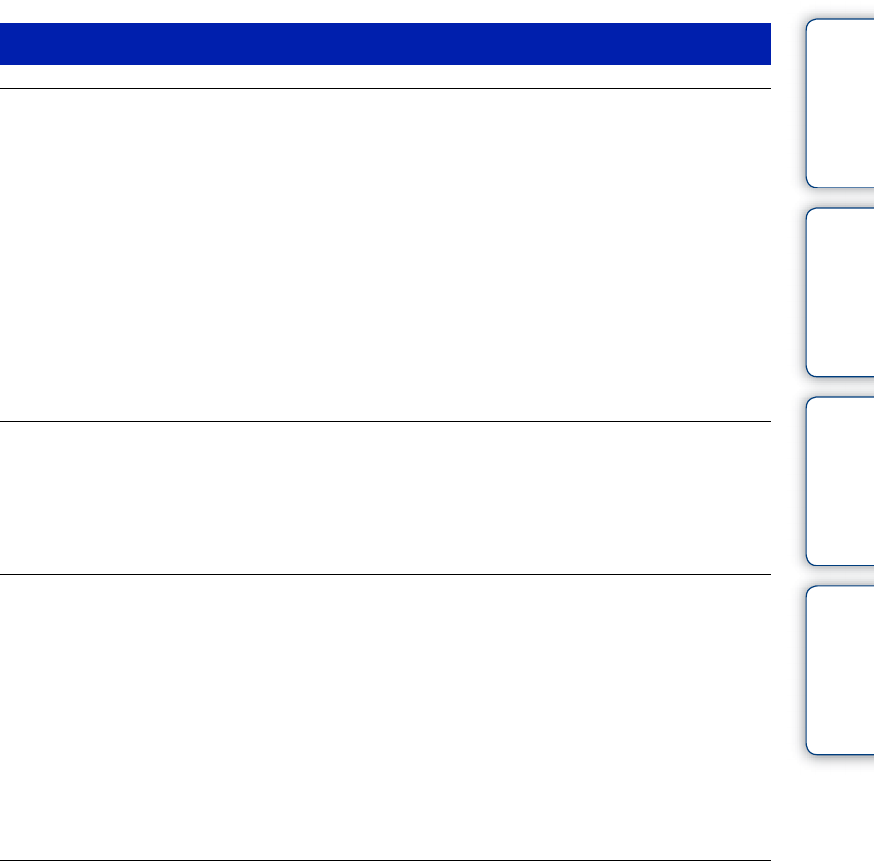
65US
Table of
contents
Operation
Search
Settings
Search Index
Cannot establish a connection with the Wireless LAN access point.
• Check to make sure the power of the Wireless LAN access point is on.
• The communication range may be shortened by the surrounding conditions, such as various obstacles,
radio wave traffic, and the wall material between this camera and the Wireless LAN access point.
Change the location of the camera or move the camera closer to the access point.
• Check whether an encryption key (WEP/WPA) or other special settings (Fixed IP address, proxy
settings, etc.) are needed to connect to the access point.
• When the access point is set so that the SSID is hidden, the SSID may not be displayed on the
network list. Check the SSID of the access point with an administrator and make settings manually.
Or cancel the setting on the access point.
• Microwave ovens or Bluetooth-enabled devices use the 2.4 GHz wavelength and could hinder the
communication. If such devices are in the vicinity, move the camera away from those devices or shut
those devices down.
Cannot enter the encryption key.
• For details on the verification method used for the encryption key (WEP/WPA), see the operation
manual for the access point or the information listed on the bottom panel of the device.
• The number of characters that can be input differs depending on the encryption type.
• This camera cannot be connected to a 5 GHz access point.
It takes too much time to transfer an image.
• The communication range may be shortened by the surrounding conditions, such as various obstacles,
radio wave traffic, and the wall material between the devices or between this camera and the Wireless
LAN access point. Change the location of the devices, put the devices closer together, or move the
camera closer to the access point.
• You may be getting a crossed connection with another Wireless LAN access point. Set the wireless
channel at the Wireless LAN access point. For further information, refer to the operating manual of
the Wireless LAN access point.
• Microwave ovens or Bluetooth-enabled devices use the 2.4 GHz wavelength and could hinder the
communication. If such devices are in the vicinity, move the camera away from those devices or shut
those devices down.
Cannot connect to a hotspot (public Wireless LAN access point) service.
• Check with the hotspot service provider that you have contracted with.
Wireless network
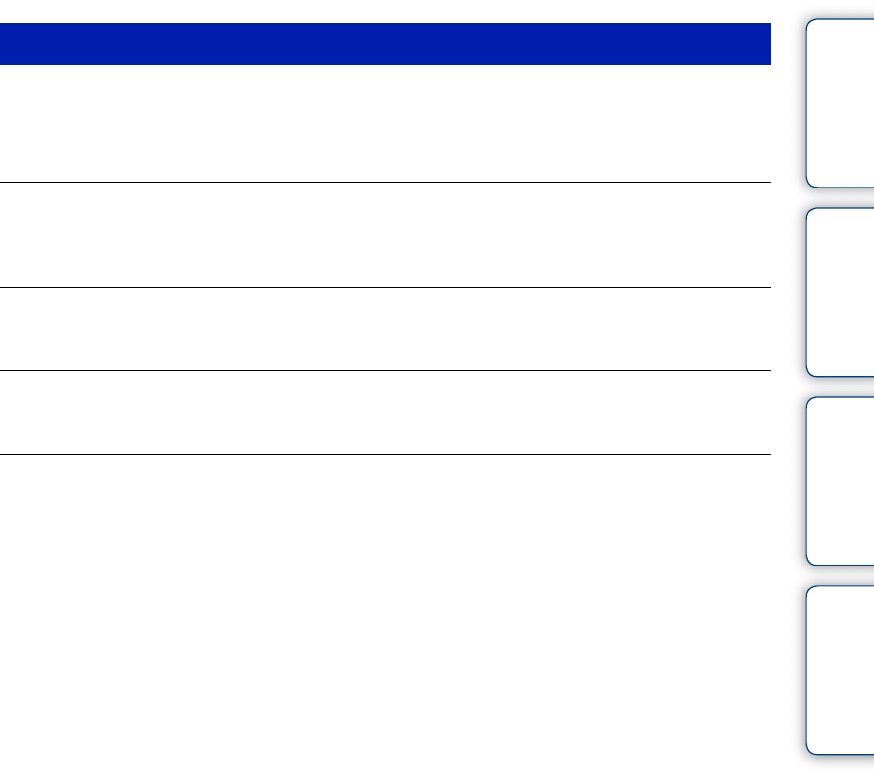
66US
Table of
contents
Operation
Search
Settings
Search Index
The camera does not work properly.
• Press and hold the ON/OFF (Power) button for at least 7 seconds, and force-quit the camera. Then
turn the camera on again.
The lens gets fogged.
• Moisture condensation has occurred. Turn off the camera and wait about an hour for the moisture to
evaporate.
The camera becomes warm when you use it for a long time.
• This is not a malfunction.
The Clock Set screen appears when you turn on the camera.
• Set the date and time again (page 25).
The date or time is incorrect.
• Set the date and time again (page 59).
Others
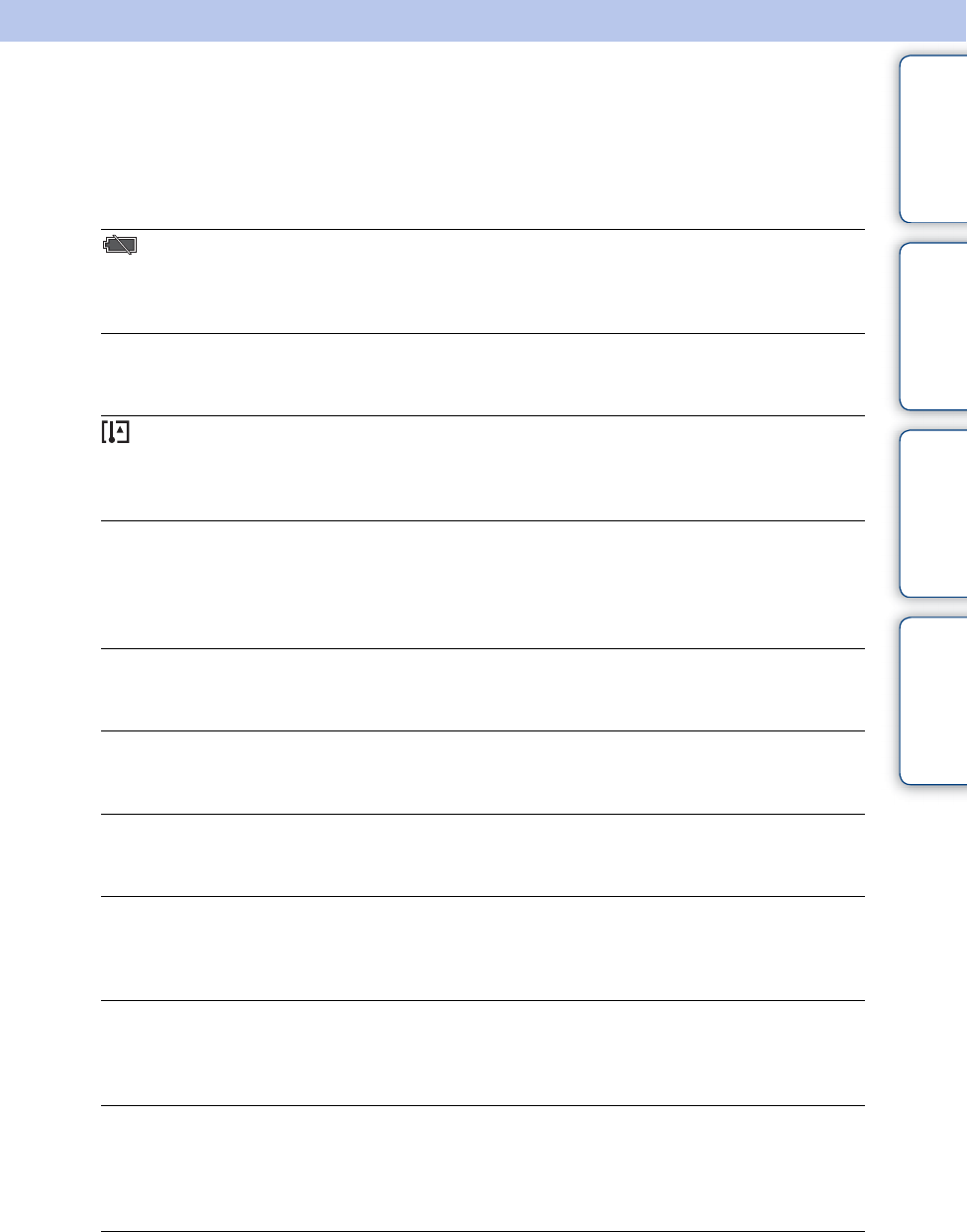
67US
Table of
contents
Operation
Search
Settings
Search Index
Warning indicators and
messages
If the following messages appear, follow the instructions.
• The battery level is low. Charge the battery pack immediately. Depending on the conditions of use,
the indicator may flash even though there are still 5 to 10 minutes of remaining battery time left.
System error
• Turn the power off and then on again.
• If you record movies for an extended period, the camera temperature rises. In this case, stop recording
movies.
Camera overheating
Allow it to cool
• The camera temperature has risen. The power may turn off automatically, or you may be unable to
record movies. Leave the camera in a cool location until the temperature goes down.
Internal memory error
• Turn the power off and then on again.
Error formatting internal memory
• Format the media again (page 58).
No images
• No images that can be played back have been recorded in the internal memory.
Folder error
• A folder with the same first three digit number already exists on the internal memory (for example:
123MSDCF and 123ABCDE). Format the camera (page 58).
Cannot create more folders
• The folder with a name beginning with “999” exists on the internal memory. Format the camera
(page 58).
File error
• An error occurred while the image was playing back.
Playback on the camera cannot be guaranteed if files contain images processed on a computer, or
images shot by another camera.
Image size over limit
• You are playing back an image with size that cannot be played back on the camera.

68US
Table of
contents
Operation
Search
Settings
Search Index
Maximum number of images already selected
• Up to 100 files can be selected when using [Delete] and [Share].
Operation cannot be executed in unsupported files
• Playback zoom cannot be performed on movies.
Invalid operation
• This message appears if you perform an invalid operation.
Login expired
• The authentication information of the network service has expired. Login to the network service
again.
The upload place deleted
• The upload destination, such as an album, is not found. Make sure that the correct destination is
specified for the service.
Connection error
• An error has occurred during Wi-Fi connection. Re-establish the Wi-Fi connection.
There is not enough usable space on the server
• There is not enough available capacity on the destination server for the content you wish to upload.
Unexpected error occurred
• Turn the power off and then on again.
Network error occurred
• Reconnect the network service.
User authentication failed
• Logging in to the network service failed. Login to the network service again.
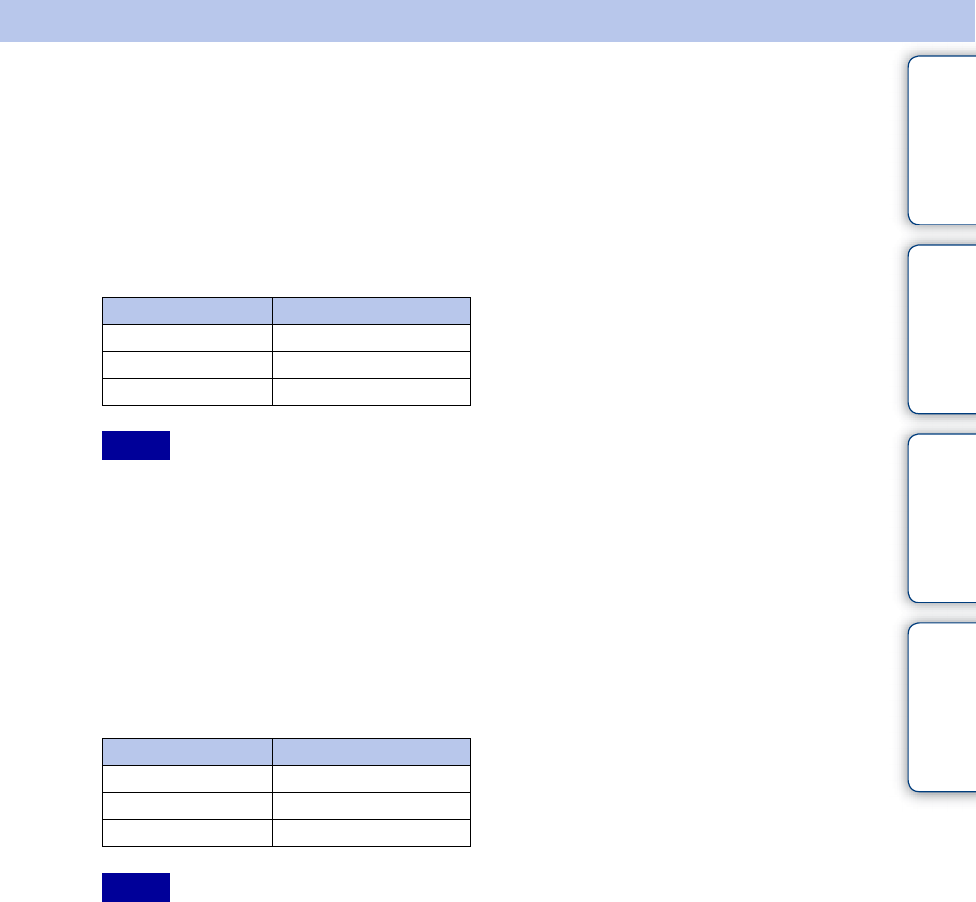
69US
Table of
contents
Operation
Search
Settings
Search Index
Number of still images and
recordable time of movies
The number of still images and recordable time may vary depending on the shooting conditions.
Still images
• When the number of remaining recordable images is greater than 9,999, the “>9999” indicator appears.
• When images recorded using other cameras are played back on this camera, the display may differ from
the actual image size.
• When measuring media capacity, 1 GB equals 1 billion bytes, a portion of which is used for data
management.
Movies
The table below shows the approximate maximum recording times. These are the total times for
all movie files. Continuous shooting is possible for approximately 29 minutes.
• Your camera uses the VBR (Variable Bit Rate) format to automatically adjust image quality to suit the
recording scene. This technology causes fluctuations in the recording time of the internal memory.
Movies containing quickly moving and complex images are recorded at a higher bit rate, and this reduces
the overall recording time.
• The maximum size of a single movie file is approximately 2 GB. Recording stops before 29 minutes if
the file size reaches approximately 2 GB during movie recording.
• The number in ( ) is the minimum recording time.
• When the possible continuous shooting time ends, the recording stops automatically.
(Units: Images)
Size Capacity
4:3 (12M) xx
16:9 (8M) xx
16:9 (2M) xx
Notes
(Units: hour : minute : second)
Size Capacity
1920×1080 30p x:xx:xx (x:xx:xx)
1280×720 60p x:xx:xx (x:xx:xx)
1280×720 30p x:xx:xx (x:xx:xx)
Notes

70US
Table of
contents
Operation
Search
Settings
Search Index
Built-in battery pack
On charging the battery pack
• We recommend charging the battery pack in an ambient temperature of between 10°C to 30°C (50°F to
86°F). The battery pack may not be effectively charged in temperatures outside this range.
• When usable battery life becomes half the usual time, even after charging the battery fully, the battery
may need to be replaced. Consult your nearest Sony dealer.
Effective use of the battery pack
• Battery performance decreases in low temperature surroundings. So in cold places, the operational time
of the battery pack is shorter.
• The battery pack will run out quickly if you use the zoom frequently.
• Do not expose the camera to water. The camera is not water-resistant.
• Do not leave the camera in an extremely hot place, such as in a car or under direct sunlight.
How to store the camera
• Even if you do not use the camera for an extended period, fully charge the camera every 6 to 12 months
to maintain the camera’s function. Also, store the camera in a cool, dry place.
On battery life
• The battery life is limited. Battery capacity decreases over time and through repeated use. If decreased
usage time between charges becomes significant, consult your nearest Sony dealer.
• The battery life varies according to how it is stored and the operating conditions and environment in
which each battery pack is used.

71US
Table of
contents
Operation
Search
Settings
Search Index
Precautions
Do not use/store the camera in the following places
• In an extremely hot, cold or humid place
In places such as in a car parked in the sun, the camera body may become deformed and this may cause a
malfunction.
• Under direct sunlight or near a heater
The camera body may become discolored or deformed, and this may cause a malfunction.
• In a location subject to rocking vibration
• Near strong magnetic fields
• In sandy or dusty places
Be careful not to let sand or dust get into the camera. This may cause the camera to malfunction, and in
some cases may be irreparable.
On carrying
Do not sit down in a chair or other place with the camera in the back pocket of your trousers or skirt, as this
may cause malfunction or damage the camera.
On cleaning
Cleaning the lens
Wipe the lens with a soft cloth to remove fingerprints, dust, etc.
Cleaning the camera surface
Clean the camera surface with a soft cloth slightly moistened with water, then wipe the surface with a dry
cloth. Do not do any of the following as they may damage the finish or the casing.
– Use Chemical products such as thinner, benzine, alcohol, disposable cloths, insect repellent, sunscreen or
insecticide, etc.
– Touch the camera with any of the above on your hand.
– Leave the camera in contact with rubber or vinyl for a long time.
On operating temperatures
Your camera is designed for use under the temperatures between 0°C and 40°C (32°F and 104°F). Shooting
in extremely cold or hot places that exceed this range is not recommended.
On moisture condensation
If the camera is brought directly from a cold to a warm location, moisture may condense inside or outside
the camera. This moisture condensation may cause a malfunction of the camera.
If moisture condensation occurs
Turn off the camera and wait about an hour for the moisture to evaporate.
Note on disposal/transfer
• When using the software pre-loaded on the internal memory, personal information such as IDs and mail
addresses may be saved on the internal memory of the camera. Before changing ownership of the camera,
or before disposal, delete any personal information.
• Even if you delete data in the internal memory or format the camera, you may not delete data from the
internal memory completely.
• To prevent the camera from restoring the internal memory data, record any unnecessary data on the
internal memory of the camera.

72US
Table of
contents
Operation
Search
Settings
Search Index
The software (including, updated software) that installed into this product (“SONY SOFTWARE”) has,
among others, certain functionality defined below (“Network Linkage Function”). Your use of Network
Linkage Function shall constitute your agreement to the following terms and conditions.
“Network Linkage Function”: Certain function of connecting, linking, working your audio-visual data in
this product with certain websites which offer services linking your data (the “Website”)
– NEITHER SONY NOR LICENSORS OF SONY WHICH GRANT SONY CERTAIN
INTELLECTUAL PROPERTY RIGHTS RELATING TO THE SONY SOFTWARE (“LICENSORS”)
WARRANT OR MAKE ANY REPRESENTATION THAT YOU WILL BE ABLE TO USE, IN
WHOLE OR A PART OF, NETWORK LINKAGE FUNCTION OR ANY WEBSITE NOW OR IN
THE FUTURE.
– You shall be responsible for bearing all costs and expenses such as interest access fee, registration fee
and service see necessary to use the Website and the services offered by such Website.
– You shall use the services offered by the Website at your sole risk and responsibility and in compliance
with the terms and conditions of service at such Website.
– Any Website may, at its sole discretion, cease or change the operation of such Website. SONY and
Licensors shall NOT be liable for any loss or damages of you and third parties, whether direct, incidental,
consequential or otherwise, arising out of or relating to the use or inability to use the services provided by
such Website due to its cessation or change of the operation.
– When you access to a Website using Network Linkage Function, your data may be transferred to such
Website through the servers administered by or for SONY (the “SONY Servers”). You acknowledge and
agree that (i) there may be time period in which you may not be able to access to any Website using
Network Linkage Function for any reason (including the server maintenance of SONY Servers); and that
(ii) when you access to Website through the SONY Servers the SONY Servers will record certain non-
personally identifiable data, such as the number of times the SONY SOFTWARE accesses a particular
Website URL, but at no time will the SONY SOFTWARE allow the SONY Servers record any personal
information which may identify you; and that (iii) SONY will use such access count records only for the
purpose of designing, developing, improving, offering, selling and rendering SONY group products and
services.
– At any time, SONY may temporarily halt or permanently cease operation of the SONY Servers. SONY
and Licensors shall NOT be liable for any loss or damages of you and third parties, whether direct,
incidental, consequential or otherwise arising out of or relating to the use or inability to use the services
provided by the Website due to such halt or cessation of the operation of the SONY Servers.
– If the use of services provided by certain Website is prohibited or limited by the applicable laws and
regulations of certain countries, you shall comply with such laws and regulations. In order to comply
with such laws and regulations, SONY may take the steps to prevent or limit the use of such services the
access to such Website by using Network Linkage Function. SONY and Licensors shall NOT be liable
for any loss or damages of you and third parties, whether direct, incidental, consequential or otherwise
arising out of or relating to the use or inability to use the services provided by the Website due to such
steps taken by SONY.

73US
Table of
contents
Operation
Search
Settings
Search Index
Specifications
Camera
[System]
Image device: 7.22 mm (1/2.5 type) CMOS sensor
Total pixel number of camera:
Approx. 13 011 000 pixels
Effective pixel number of camera:
Approx. 8 294 000 pixels (still image, 16:9),
Approx. 12 780 000 pixels (still image, 4:3),
Approx. 2 073 000 pixels ([1920×1080 30p]
movie)
Lens: F2.8
f = 5.3 mm (7/32 inches)
When converted to a 35 mm still camera
For movies: 37 mm (1 1/2 inches) (16:9)
For still images: 32 mm (1 5/16 inches) (4:3)
Exposure control: Automatic exposure
File format:
Still images: JPEG (DCF Ver. 2.0, Exif Ver. 2.3,
MPF Baseline) compliant
Movies: MPEG-4 AVC/H.264 (MP4)
Audio: MPEG AAC
Recording media: Internal Memory (approx.
8GB)
• When measuring media capacity, 1 GB equals 1
billion bytes, a portion of which is used for
system management and/or application files.
Available user capacity is approximately 7.8
GB.
[Input and Output connectors]
HDMI OUT jack: HDMI mini connector
USB jack: type A (built-in)
USB communication: Hi-Speed USB (USB 2.0
compliant)
[LCD screen]
LCD screen: 7.6 cm 3.0 type (16:9) TFT drive
Total number of dots: 288 000 (720 × 400) dots
[Power, general]
Power:
Built-in rechargeable battery pack
USB charging (supplied from the computer by
connecting with the supplied USB connection
support cable)
Charging time: Approx. xx mins. (when charging
from the USB connector of the computer)
Approx. xx mins. (when charging from the AC-
UD20 USB charger (sold separately))
Power consumption (during shooting): xx W
(when the movie image size is [1280×720 30p])
Wireless LAN: OFF
Operating temperature: 0°C to 40°C (32°F to
104°F)
Storage temperature: –20°C to +60°C (–4°F to
+140°F)
Dimensions: Approx. xx mm × xx mm × xx mm
(xx inches × xx inches × xx inches) (W/H/D,
excluding protrusions)
Mass: Approx. xx g (xx oz)
Microphone: Stereo
Speaker: Monaural
[Wireless LAN]
Standards: IEEE802.11b/g/n compliant
Channel: 1 to 11 (USA, Canada)
1 to 13 (EU, Australia, U.K.)
Design and specifications are subject to change
without notice.

74US
Table of
contents
Operation
Search
Settings
Search Index
Trademarks
• “Bloggie” is a trademark of Sony Corporation.
• HDMI, the HDMI logo and High-Definition Multimedia Interface are trademarks or registered
trademarks of HDMI Licensing LLC in the United States and other countries.
• Microsoft, Windows, Windows Vista and DirectX are either registered trademarks or trademarks of
Microsoft Corporation in the United States and/or other countries.
• Mac, Mac OS, the Mac OS logo, iMac, iBook, iMovie, PowerBook, Power Mac and eMac are
trademarks or registered trademarks of Apple Inc.
• Intel and Pentium are trademarks or registered trademarks of Intel Corporation.
In addition, system and product names used in this manual are, in general, trademarks or registered
trademarks of their respective developers or manufacturers. However, the ™ or ® marks are not used in all
cases in this manual.
Notes on the License
THIS PRODUCT IS LICENSED UNDER THE AVC PATENT PORTFOLIO LICENSE FOR THE
PERSONAL AND NON-COMMERCIAL USE OF A CONSUMER TO (i) ENCODE VIDEO IN
COMPLIANCE WITH THE AVC STANDARD (“AVC VIDEO”) AND /OR (ii) DECODE AVC VIDEO
THAT WAS ENCODED BY A CONSUMER ENGAGED IN A PERSONAL AND NON-
COMMERCIAL ACTIVITY AND/OR WAS OBTAINED FROM A VIDEO PROVIDER LICENSED TO
PROVIDE AVC VIDEO. NO LICENSE IS GRANTED OR SHALL BE IMPLIED FOR ANY OTHER
USE. ADDITIONAL INFORMATION MAY BE OBTAINED FROM MPEG LA, L.L.C.
SEE <HTTP://WWW.MPEGLA.COM>

75US
Table of
contents
Operation
Search
Settings
Search Index
Index
B
Battery pack ........................................................................70
Beep........................................................................................53
C
Charging ...............................................................................21
Clock Settings....................................................................25
Computer
Recommended environment.................................50
Uploading images .....................................................52
D
Date & Time Setting .......................................................59
Daylight Savings.........................................................25, 59
Delete.....................................................................................41
Demo Mode ........................................................................54
F
Flicker Reduction .............................................................36
Format ...................................................................................58
H
HDMI OUT jack...............................................................60
HDMI Output .....................................................................56
I
Identifying parts ................................................................13
Initialize................................................................................55
Install .....................................................................................24
L
LUN Settings(USB) ........................................................57
M
Mac computer ....................................................................50
Movie Size...........................................................................35
N
Number of still images...................................................69
O
OS............................................................................................50
P
Photo Size............................................................................33
Pixel........................................................................................34
Playback zoom...................................................................40
PlayMemories Home ......................................................24
R
Recordable time of movies...........................................69
S
Self-Timer............................................................................37
Settings..................................................................................11
Shooting
Movies............................................................................29
Still images...................................................................27
Software................................................................................24
T
Touch panel.........................................................................18
Troubleshooting ................................................................62
U
USB ..................................................................................21, 24
V
View
Movies............................................................................38
Still images...................................................................38
Volume control..................................................................42
W
Warning messages............................................................67
Wi-Fi......................................................................................43
Windows computer..........................................................50
Z
Zoom......................................................................................31

Mobile HD Snap Camera
bloggie
4-412-629-11(1)
MHS-TS55
Important Notice
Mobile HD Snap Camera
© 2012 Sony Corporation Printed in China
4-412-629-11(1)
Owner’s Record
The model and serial numbers are located on the
bottom. Record the serial number in the space
provided below. Refer to these numbers whenever you
call your Sony dealer regarding this product.
Model No. MHS-TS55
Serial No. __________________________________
WARNING
To reduce fire or shock hazard, do not expose the
unit to rain or moisture.
CAUTION
Observe the following cautions, as there may be a risk
of heat generation, fire or explosion.
* Lithium-ion battery is built into the product.
Charge the product by the designated charging
method.
Do not place the product in or near fire, or put the
product in a microwave.
Do not leave the product in a car in hot weather.
Do not store or use the product in a hot and humid
place such as in a sauna bath.
Do not disassemble, crush or pierce the product.
Do not expose the product to excessive shock such as
dropping from a high place.
Do not expose the product to high temperatures
above 60°C (140°F).
Keep the product dry.
Dispose of the product appropriately.
Charge the product by the designated charging method
in the instruction manual.
For the customers in the U.S.A.
If you have any questions about this product, you
may call:
Sony Customer Information Center
1-800-222-SONY (7669)
The number below is for the FCC related matters only.
Regulatory Information
Declaration of Conformity
Trade Name: SONY
Model No.: MHS-TS55
Responsible Party: Sony Electronics Inc.
Address: 16530 Via Esprillo, San Diego, CA 92127
U.S.A.
Telephone No.: 858-942-2230
This device complies with Part15 of the FCC
Rules. Operation is subject to the following two
conditions: (1) This device may not cause harmful
interference, and (2) this device must accept any
interference received, including interference that
may cause undesired operation.
CAUTION
You are cautioned that any changes or modifications
not expressly approved in this manual could void your
authority to operate this equipment.
(Continued overleaf)
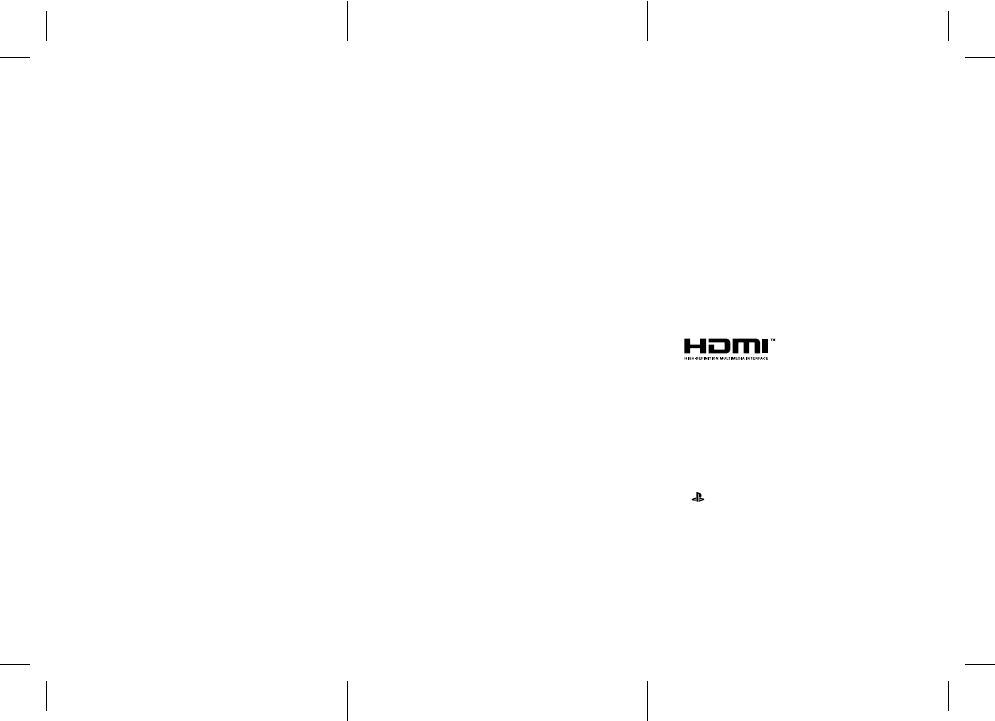
Mobile HD Snap Camera
bloggie
4-412-629-11(1)
Note:
This equipment has been tested and found to comply
with the limits for a Class B digital device, pursuant to
Part 15 of the FCC Rules.
These limits are designed to provide reasonable
protection against harmful interference in a residential
installation. This equipment generates, uses, and can
radiate radio frequency energy and, if not installed
and used in accordance with the instructions, may
cause harmful interference to radio communications.
However, there is no guarantee that interference will
not occur in a particular installation. If this equipment
does cause harmful interference to radio or television
reception, which can be determined by turning the
equipment off and on, the user is encouraged to try to
correct the interference by one or more of the following
measures:
Reorient or relocate the receiving antenna.
Increase the separation between the equipment and
receiver.
Connect the equipment into an outlet on a
circuit different from that to which the receiver is
connected.
Consult the dealer or an experienced radio/TV
technician for help.
The supplied interface cable must be used with the
equipment in order to comply with the limits for a
digital device pursuant to Subpart B of Part 15 of
FCC Rules.
THIS DEVICE COMPLIES WITH PART 15 OF THE
FCC RULES.
OPERATION IS SUBJECT TO THE FOLLOWING
TWO CONDITIONS:
(1) THIS DEVICE MAY NOT CAUSE HARMFUL
INTERFERENCE, AND
(2) THIS DEVICE MUST ACCEPT ANY
INTERFERENCE RECEIVED, INCLUDING
INTERFERENCETHAT MAY CAUSE
UNDESIRED OPERATION.
This equipment must not be co-located or operated in
conjunction with any other antenna or transmitter.
The available scientific evidence does not show that
any health problems are associated with using low
power wireless devices. There is no proof, however,
that these low power wireless devices are absolutely
safe. Low power Wireless devices emit low levels of
radio frequency energy (RF) in the microwave range
while being used. Whereas high levels of RF can
produce health effects (by heating tissue), exposure
of low-level RF that does not produce heating effects
causes no known adverse health effects. Many
studies of low-level RF exposures have not found any
biological effects. Some studies have suggested that
some biological effects might occur, but such findings
have not been confirmed by additional research. MHS-
TS55 has been tested and found to comply with FCC
radiation exposure limits set forth for an uncontrolled
environment and meets the FCC radio frequency (RF)
Exposure Guidelines in Supplement C to OET65.
Specifications
Power:
Rechargeable Battery Pack 3.7V
USB Charging DC 5.0V
Power Consumption 2.1W
Supplied accessories
USB connection support cable (1)
(Sony Corporation 1-836-378-)
Wrist Strap (1)
Instruction Manual (this manual)
Important Notice (1)
On the memory capacity of this product
When measuring media capacity, 1 GB equals 1
billion bytes, a portion of which is used for system
management and/or application files. The capacity that
a user can use is approximately 7.8 GB.
Trademarks
“Bloggie” is a trademark of Sony Corporation.
HDMI, the HDMI logo and High-Definition
Multimedia Interface are trademarks or registered
trademarks of HDMI Licensing LLC in the United
States and other countries.
Microsoft, Windows, Windows Vista and DirectX
are either registered trademarks or trademarks of
Microsoft Corporation in the United States and/or
other countries.
Mac, Mac OS, the Mac OS logo, iMac, iBook, iMovie,
PowerBook, Power Mac and eMac are trademarks or
registered trademarks of Apple Inc.
Intel and Pentium are trademarks or registered
trademarks of Intel Corporation.
“ ” and “PlayStation” are registered trademarks of
Sony Computer Entertainment Inc.
In addition, system and product names used in this
manual are, in general, trademarks or registered
trademarks of their respective developers or
manufacturers. However, the or marks are not
used in all cases in this manual.
(Continued)

